Disclaimer
Peter Paul Rubens
Baroque Painter and Diplomat
1577 - 1640
Self Portrait of Peter Paul Rubens
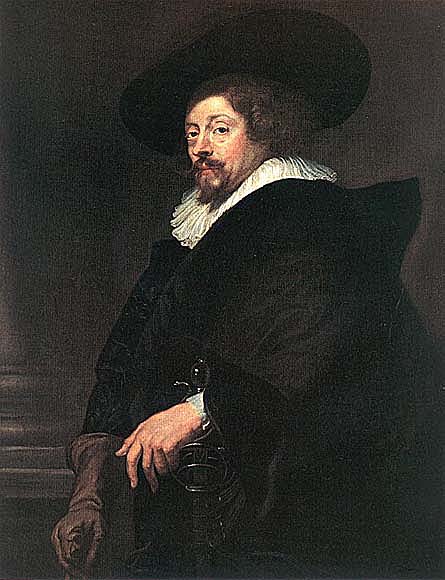
Peter Paul Rubens was a prolific seventeenth-century Flemish and European painter, and a proponent of an exuberant Baroque style that emphasized movement, color, and sensuality. He is well-known for his Counter-Reformation altarpieces, portraits, landscapes, and history paintings of mythological and allegorical subjects.
In addition to running a large studio in Antwerp which produced paintings popular with nobility and art collectors throughout Europe, Rubens was a classically-educated humanist scholar, art collector, and diplomat who was knighted by both Philip IV, King of Spain, and Charles I, King of England.
Rubens was born in Siegen, Westphalia, to Jan Rubens and Maria Pypelincks. His father, a Calvinist, and mother fled Antwerp for Cologne in 1568, after increased religious turmoil and persecution of Protestants during the rule of the Spanish Netherlands by the Duke of Alba. Jan Rubens became the legal advisor (and lover) to Anna of Saxony, the second wife of William I of Orange, and settled at her court in Siegen in 1570. Following imprisonment for the affair, Peter Paul Rubens was born in 1577. The family returned to Cologne the next year. In 1589, two years after his father's death, Rubens moved with his mother to Antwerp, where he was raised Catholic. Religion figured prominently in much of his work and Rubens later became one of the leading voices of the Catholic Counter-Reformation style of painting.
In Antwerp Rubens received a humanist education, studying Latin and classical literature. By fourteen he began his artistic apprenticeship with Tobias Verhaeght. Subsequently, he studied under two of the city's leading painters of the time, the late mannerists Adam van Noort and Otto van Veen. Much of his earliest training involved copying earlier artists' works, such as woodcuts by Hans Holbein the Younger and Marcantonio Raimondi's engravings after Raphael. Rubens completed his education in 1598, at which time he entered the Guild of St. Luke as an independent master.
In 1600, Rubens traveled to Italy. He stopped first in Venice, where he saw paintings by Titian, Veronese, and Tintoretto, before settling in Mantua at the court of Duke Vincenzo I of Gonzaga. The coloring and compositions of Veronese and Tintoretto had an immediate effect on Rubens's painting, and his later, mature style was profoundly influenced by Titian. With financial support from the duke, Rubens traveled to Rome by way of Florence in 1601. There, he studied classical Greek and Roman art and copied works of the Italian masters. The Hellenistic sculpture Laocoon and his Sons was especially influential on him, as was the art of Michelangelo, Raphael and Leonardo da Vinci. He was also influenced by the recent, highly naturalistic paintings by Caravaggio. He later made a copy of that artist's Entombment of Christ, recommended that his patron, the Duke of Mantua, purchase The Death of the Virgin (Louvre), and was instrumental in the acquisition of The Madonna of the Rosary (Kunsthistorisches Museum, Vienna) for the Dominican Church in Antwerp. During this first stay in Rome, Rubens completed his first altarpiece commission, St. Helena with the True Cross for the Roman Church, Santa Croce in Gerusalemme.
The Duke of Lerma

In 1603 Flemish painter Peter Paul Rubens traveled to Spain as part of a diplomatic mission. While there, he received a commission for this portrait of the Duke of Lerma, the powerful prime minister of Spanish king Philip III. The painting now hangs in the Prado Museum in Madrid, Spain.
Emperor Charles V
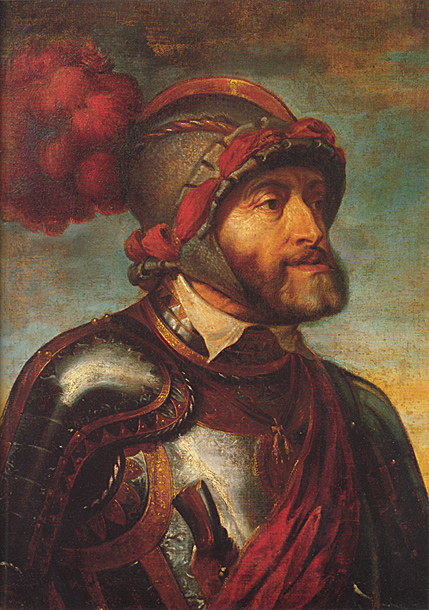
Allegory on Emperor Charles V as Ruler of Vast Realms
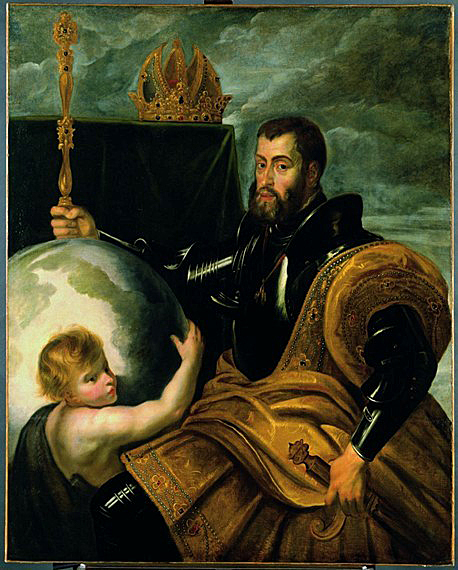
While Rubens was court painter to Duke Vincenzo Gonzaga, he was sent on a diplomatic mission to Spain in 1603- 1604. This was probably Rubens' first encounter with the powerful and magnificent position of the Habsburg dynasty and the Habsburg rulers at their principal residence. He perceived Charles V as the founder of the imperial and dynastic power of this family which he held in high respect. Rubens applied himself to the study of Titian's (1477- 1576) portraits of the emperor. Shortly after his return from Spain to Italy, he executed this portrait of the emperor, which he modelled on a painting by Parmigianino (1503- 1540) in the ducal collection. Rubens created a large-scale composition of geometric and stereometric forms. The emperor is depicted in ceremonial armour, with the Order of the Golden Fleece and his imperial insignia: crown, sceptre, sword and globe, the latter being the symbol of his extensive dominions. The mitre crown depicted in the painting is consistent with the form of the private crowns of the Habsburgs.
Rubens traveled to Spain on a diplomatic mission in 1603, delivering gifts from the Gonzagas to the court of Philip III. While there, he viewed the extensive collections of Raphael and Titian that had been collected by Philip II. He also painted an equestrian portrait of the Duke of Lerma during his stay (Prado, Madrid) that demonstrates the influence of works like Titian's Charles V at Muhlberg (1548; Prado, Madrid). This journey marks the first of many during his career that would combine art and diplomacy.
Marchesa Brigida Spinola-Doria
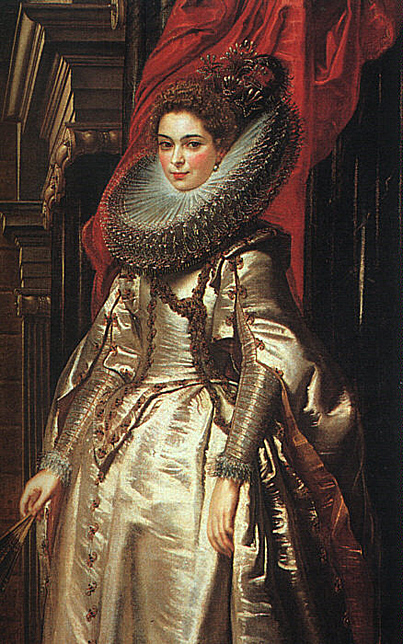
On at least four occasions during his long stay in Italy, Rubens worked in Genoa, a wealthy seaport. This proud Genoese aristocrat, by birth a Spinola, married Giacomo Massimiliano Doria in 1605. Painted at the age of twenty-two in the year following her marriage, the marchesa wears a magnificent silvery satin dress that may be her wedding gown.
Following the sixteenth-century Venetian master Titian, Rubens built up layer upon layer of translucent glazes and added free strokes of thick highlights. In contrast to this loose brushwork in the gleaming white gown and crimson drapery, the tight Flemish technique Rubens had practiced in his native Flanders defines the carefully detailed face, intricately jeweled coiffure, and spectacular lace collar.
Rubens' preliminary drawing and a print made after this painting indicate that the National Gallery's portrait is only a fragment. Initially the figure was full-length, and the architecture receded to an open landscape. Sometime after 1854 the canvas was cut down, possibly because its edges had been damaged.
He returned to Italy in 1604, where he remained for the next four years-first in Mantua, and then in Genoa and Rome. In Genoa, Rubens painted numerous portraits, such as the Marchesa Brigida Spinola-Doria (National Gallery of Art, Washington, D.C.), in a style that would influence later paintings by Anthony van Dyck, Joshua Reynolds, and Thomas Gainsborough. He also began a book illustrating the palaces in the city. From 1606 to 1608, he was largely in Rome. During this period Rubens received his most important commission to date for the high altar of the city's most fashionable new church, Santa Maria in Vallicella (or, Chiesa Nuova). The subject was to be St. Gregory the Great and important local saints adoring an icon of the Virgin and Child. The first version, a single canvas (Musee des Beaux-Arts, Grenoble), was immediately replaced by a second version on three slate panels that permits the actual miraculous holy image of the "Santa Maria in Vallicella" to be revealed on important feast days by a removable copper cover, also painted by the artist.
The impact of Italy on Rubens was great. Besides the artistic influences, he continued to write many of his letters and correspondences in Italian for the rest of his life, signed his name as "Pietro Paolo Rubens", and spoke longingly of returning to the peninsula-a hope that never materialized.
Upon hearing of his mother's illness in 1608, Rubens planned his departure from Italy for Antwerp. However, she died before he made it home. His return coincided with a period of renewed prosperity in the city with the signing of Treaty of Antwerp in April 1609, which initiated the Twelve Years' Truce. In September of that year Rubens was appointed court painter by Albert and Isabella, the Governors of the Low Countries. He received special permission to base his studio in Antwerp, instead of at their court in Brussels, and to also work for other clients. He remained close to the Archduchess Isabella until her death in 1633, and was called upon not only as a painter but also as an ambassador and diplomat. Rubens further cemented his ties to the city when, on October 3, 1609, he married Isabella Brant, the daughter of a leading Antwerp citizen and humanist Jan Brant.
Isabella Brandt and Self Portrait of Rubens: 1610
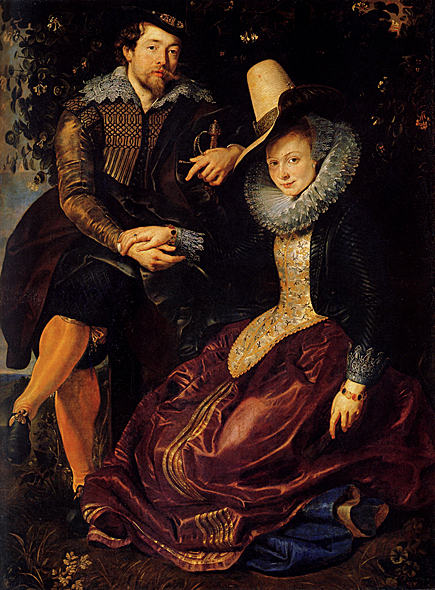
Isabella Brandt: ca 1626
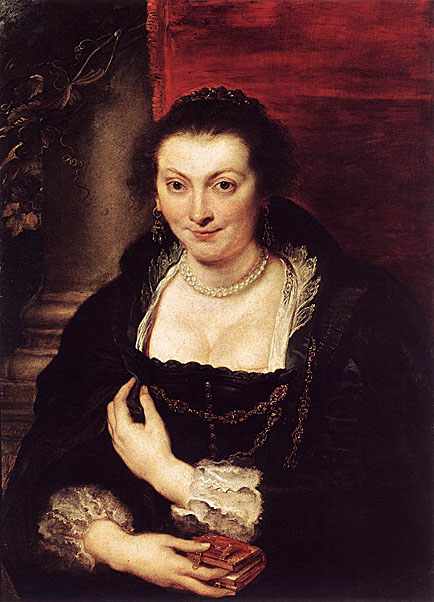
In 1610, Rubens moved into a new house and studio that he designed. Now the Rubenshuis Museum, the Italian-influenced villa in the center of Antwerp contained his workshop, where he and his apprentices made most of the paintings, and his personal art collection and library, both among the most extensive in Antwerp. During this time he built up a studio with numerous students and assistants. His most famous pupil was the young Anthony van Dyck, who soon became the leading Flemish portraitist and collaborated frequently with Rubens. He also frequently collaborated with the many specialists active in the city, including the animal painter Frans Snyders, who contributed to the eagle to Prometheus Bound (illustrated left), and his good friend the flower-painter Jan Brueghel the Elder.
Anthony van Dyck - Self Portrait
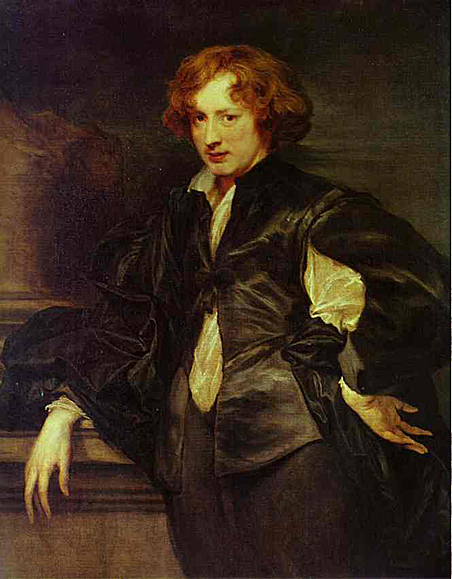
Prometheus Bound: 1610

The piece Prometheus Bound is based upon the mythological story of the Titan Prometheus who stole fire from the gods to give to mankind. This work, which was completed in 1612, has a very interesting and diverse history.
Flemish baroque painter Peter Paul Rubens was born June 28, 1577. By the age of 21 Rubens had become a master painter. At 21, Rubens traveled to Italy to continue his education. It was in Venice where he saw the radiant colors and majestic forms of Titian that influenced the style we see in his Prometheus work. Prometheus Bound was painted between 1611 and 1612. The more I look at this painting the more I like it but the stranger it becomes. The painting is of an almost naked man chained to a rock and fighting an eagle that is pecking out his liver. This piece symbolizes Baroque art at its purest. Most of the qualities associated with the Baroque are present in this painting. The painting is very dramatic in its portrayal of this struggle between Prometheus and the eagle. When I look at the eagle's face I think it is grinning as if it were enjoying ripping out the liver of Prometheus.
Altarpieces such as The Raising of the Cross (1610) and The Descent from the Cross (1612-1614) for the Cathedral of Our Lady were particularly important in establishing Rubens as Flanders' leading painter shortly after his return. The Raising of the Cross, for example, demonstrates the artist's synthesis of Tintoretto's Crucifixion for the Scuola di San Rocco in Venice, Michelangelo's dynamic figures, and Rubens's own personal style. This painting has been held as a prime example of Baroque religious art.
The Raising of the Cross: 1610
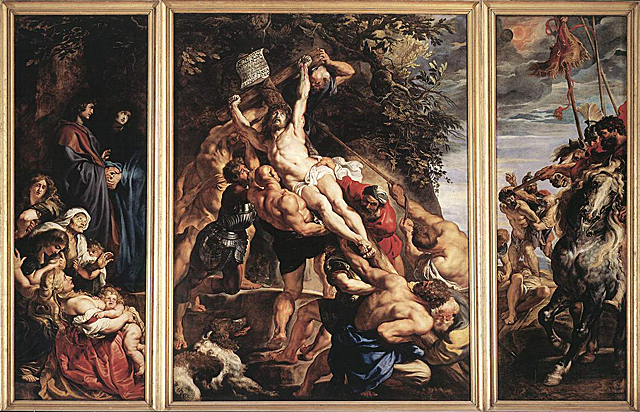
The triptych marked Rubens' sensational introduction of the Baroque style into Northern art. The diagonal composition is full of dynamism and animated color. The artist had just returned from Italy, with the memory of Michelangelo, Caravaggio and Venetian painting still fresh in his mind. The Raising of the Cross is the perfect summation of the unruly bravura that marked his first years in Antwerp.
In the centre nine executioners strain with all their might to raise the cross from which Christ's pale body hangs. The dramatic action is witnessed from the left by St John, the Virgin Mary and a group of weeping women and children. On the right, a Roman officer watches on horseback while soldiers in the background are crucifying the two thieves. In other words, the subject is spread across all three panels. The outside of the wings shows Saints Amand, Walpurgis, Eligius and Catherine of Alexandria.
The painting was confiscated by the French in 1794 and taken to Paris. It was returned to Antwerp in 1815, following the defeat of Napoleon, and installed in the church of Our Lady.
During restoration in the 1980s, successive layers of varnish, which had form an even grey veil over the painting, were removed. The burgeoning talent of the confident young Rubens is more clearly visible now in the intense emotion of the figures, the contrasting lighting, the glow of the laboring bodies and the gleam of the armor and costly robes.
The Descent from the Cross: 1612-1614
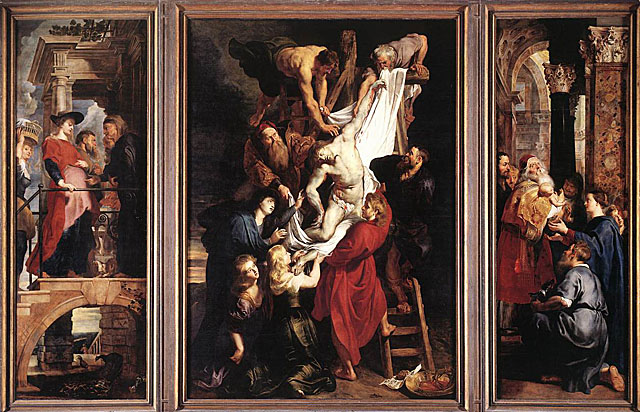
After the termination of the Calvinist regime in Antwerp in 1585, the city's churches were gradually decorated once again with works of art. The process continued and intensified in the early part of the 17th century, when the Southern Netherlands enjoyed a period of stability and prosperity thanks to the peace policies pursued by the Archdukes Albert and Isabella. Art and artists were major beneficiaries. Antwerp was a wealthy city, whose churches were decorated with unusual splendour: Catholic worship had to be especially glorious in this place where the Protestants head recently held sway.
In 1611, the Arquebusiers - Antwerp's civic guard - commissioned a Descent from the Cross by their illustrious townsman Rubens for their altar in the cathedral. The dean of the guild at that time was Burgomaster Nicolaas Rockox, who appear in the painting. The Descent from the Cross is the second of Rubens's great altarpieces for the Antwerp Cathedral. It shows the Visitation, and the Presentation of the Temple on either side of the Descent from the Cross. (The first triptych of the Raising of the Cross was executed in 1611-12.) His rich painterly Baroque technique incorporated both elements of Venetian design and also the composition and lighting of the Roman period of Caravaggio. But the result is purely Flemish.
Although at first sight the themes presented in the triptych seem extremely wide-ranging, they are actually linked, for St Christopher was the Arquebusiers' patron saint. When the triptych was closed, all that worshippers could see was this scene from the legend of St Christopher, whose Greek name 'Christophorus' means 'Christ-bearer'. This fact forms the key to the entire painting, in which the friends and holy women in the centre panel, and Mary and Simeon in the wings are also 'Christ-bearers'.
The Descent from the Cross: Detail-Center Panel

The center panel of the great triptych shows the Descent from the Cross against a dark sky. Several men - Joseph of Arimathea, Nicodemus, St John and two servants - carefully lower the body of Christ in a brilliant white shroud. They are assisted by several women, including Jesus' mother. Christ's foot rests on the shoulder of Mary Magdalene, who dried his feet with her hair.
The Descent from the Cross: Detail-Left Wing
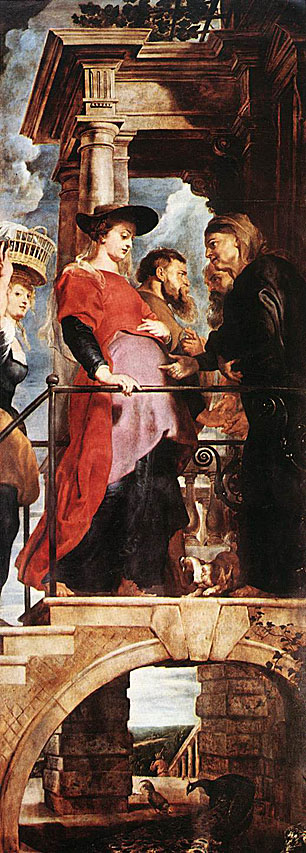
The left wing of the great triptych of the Descent from the Cross shows the Virgin Mary, pregnant with Jesus, visiting her cousin Elizabeth, who will shortly give birth to John the Baptist. The women, accompanied by their respective husbands Joseph and Zacharias, greet one another in an imposing porch. A servant carries a basket containing travel items.
The Descent from the Cross: Detail Outside Left and Right
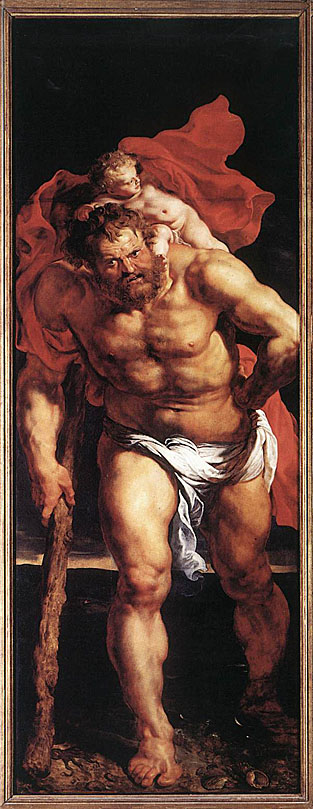
The outsides of the wings are devoted to St Christopher. According to his medieval legend, the huge St Christopher carried the Christ Child across a river on his shoulders. A hermit on the right lights his way with a lantern.
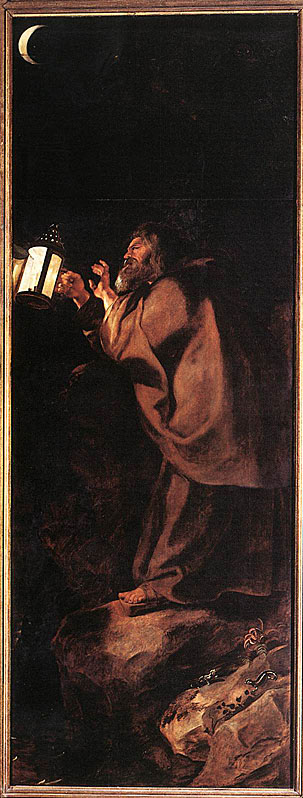
The Descent from the Cross: Detail Right Wing
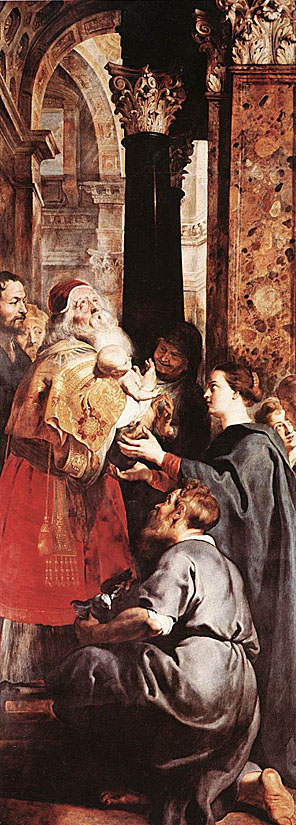
The right wing of the great triptych of the Descent from the Cross is devoted to the presentation of the Infant Christ in the Temple at Jerusalem. The elderly Simeon holds the Child in his arms while the prophetess Anna, located in the shadows between Simeon and Mary, looks on joyfully. Joseph, who has brought two sacrificial doves with him, kneels down respectfully. The onlooker on the left edge of this splendid temple interior is Nicolaas Rockox, a friend of Rubens and a prominent figure in Antwerp.
Rubens used the production of prints and book title-pages, especially for his friend Balthasar Moretus-owner of the large Plantin-Moretus publishing house- to further extend his fame throughout Europe during this part of his career. With the exception of a couple of brilliant etchings, he only produced drawings for these himself, leaving the printmaking to specialists, such as Lucas Vorsterman. He recruited a number of engravers trained by Goltzius, who he carefully schooled in the more vigorous style he wanted. He also designed the last significant woodcuts before the 19th century revival in the technique.
In 1621, the queen-mother of France, Marie de' Medici, commissioned Rubens to paint two large allegorical cycles celebrating her life and the life of her late husband, Henry IV, for the Luxembourg Palace in Paris. The Marie de' Medici Cycle (now in the Louvre) was installed in 1625, and although he began work on the second series it was never completed. Marie was exiled from France in 1630 by her son, Louis XIII, and died in 1642 in the same house in Cologne where Rubens had lived as a child.
The Marie de' Medici Cycle is a series of twenty-four paintings by Peter Paul Rubens commissioned by Marie de' Medici, wife of Henry IV of France, for the Luxembourg Palace in Paris. Rubens received the commission in the autumn of 1621. After negotiating the terms of the contract in early 1622, the project was to be completed within two years, coinciding with the marriage of Marie's daughter, Henrietta Maria. Twenty-one of the paintings depict Marie's own struggles and triumphs in life.
The Destiny of Marie de' Medici
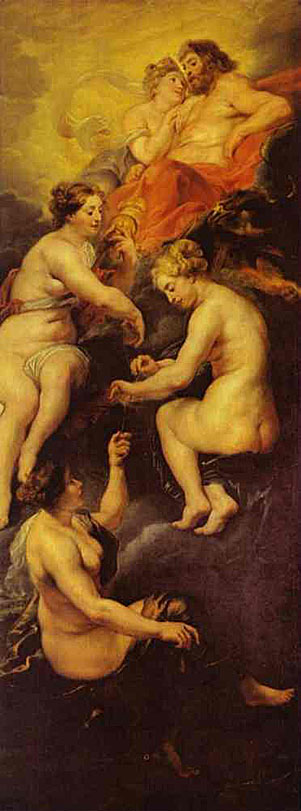
The first painting of the narrative cycle, The Destiny of Marie de' Medici, is a twisting composition of the three Fates on clouds beneath the celestial figures of Juno and Jupiter.
The Fates are depicted as beautiful, nude goddesses spinning the thread of Marie de' Medici's destiny; their presence at Marie's birth assures her prosperity and success as a ruler that is unveiled in the cycle's subsequent panels. In Greek and Roman mythology, one Fate spun the thread, another measured its length, and the third cut the thread. In Rubens' depiction, however, the scissors necessary for this cutting are omitted, stressing the privileged and immortal character of the Queen's life. The last panel of the cycle, in accordance with this theme, illustrates Queen Marie rising up to her place as queen of heaven, having achieved her lifelong goal of immortality through eternal fame.
Early interpretations explained Juno's presence in the scene through her identity as the goddess of childbirth. Later interpretations suggested, however, that Rubens used Juno to represent Marie de' Medici's alter ego, or avatar, throughout the cycle. Jupiter accordingly signifies the allegory of Henri IV, the promiscuous husband.
The Birth of the Princess
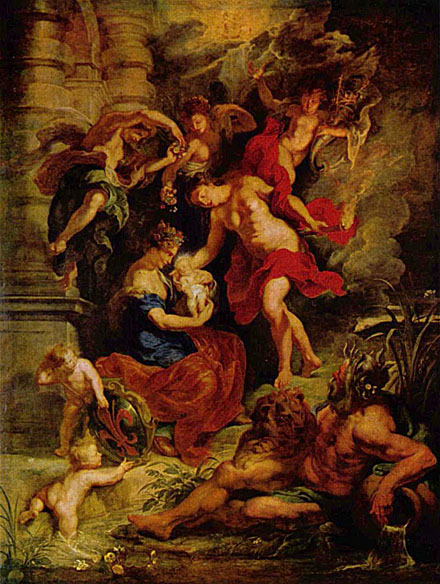
The cycle's second painting, The Birth of the Princess, represents de' Medici's April 26, 1573 birth. Symbols and allegory appear throughout the painting. On the left, two putti play with a shield on which the Medici crest appears, suggesting that Heaven favored the young de' Medici from the moment of her birth. The river god in the picture's right corner is likely an allusion to the Arno River that passes through Florence, Marie's city of birth. The cornucopia above the infant's head can be interpreted as a harbinger of Marie's future glory and fortune; the lion may be seen as symbolic of power and strength. The glowing halo around the infant's head should not be seen as a reference to Christian imagery; rather, it should be read according to imperial iconography which uses the halo as an indication of the Queen's divine nature and of her future reign. Though Marie was born under the Taurus sign, Sagittarius appears in the painting; it may be seen as a guardian of imperial power.
Education of the Princess
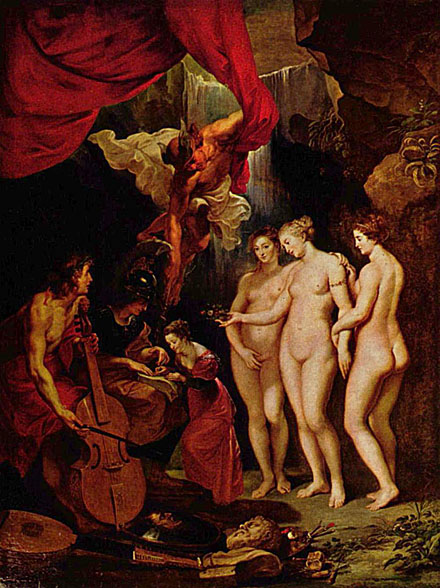
Education of the Princess (1622-1625) shows a maturing Marie de' Medici at study. Her education is given a divine grace by the presence of three gods Apollo, Athena, and Hermes. (Apollo being associated with art, Athena with wisdom, and Hermes the messenger god for a fluency and understanding of language) Hermes dramatically rushes in on the scene and literally brings a gift from the gods, the caduceus. It is generally thought that Hermes endows the princess with the gift of eloquence, to go along with the Grace's gift of beauty. However, the caduceus, which is seen in six other paintings in the cycle, has also been associated with peace and harmony. The object may be seen as foretelling of Marie's peaceful reign. It can be interpreted that the combined efforts of these divine teachers represent Marie's idyllic preparedness for the responsibilities she will obtain in the future, and the trials and tribulations she will face as Queen. It is also suggested that the three gods, more importantly, offer their guidance as a gift that allows the soul to be "freed by reason" and gain the knowledge of what is "good" revealing the divine connection between the gods and the future Queen. The painting displays an embellished Baroque collaboration of the spiritual and earthly relationships, which are illustrated in a theatrical environment. Acting as more than just static symbols the figures portrayed take an active role in her education. Also present are the three graces, Euphrosyne, Aglaea, and Thalia giving her beauty.
The Presentation of Her Portrait to Henri IV
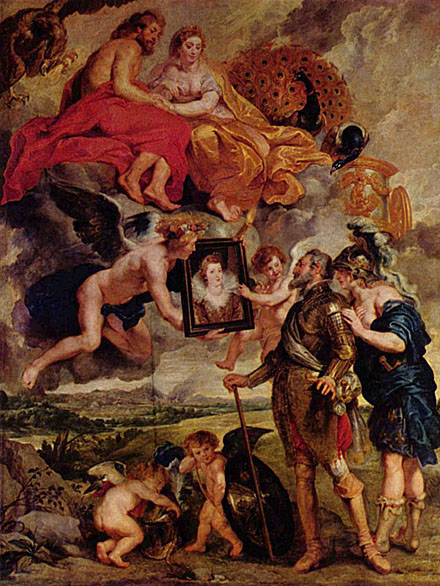
To fully appreciate and value this particular cycle piece and the collection as a whole, there is one historical principle to take into account. This painting was created on the cusp of the age of absolutism and, as such, one must remember royalty were considered above corporeal existence. So from birth, Marie would have led a life more ornamental than mortal. This painting of classical gods, along with allegorical personifications, aptly shows the viewer how fundamental this idea was.
Just as Tamino in The Magic Flute, Henri IV falls in love with a painted image. With Amor the Cupid as his escort, Hymen, the god of marriage, displays the princess Marie on canvas to her future king and husband. Meanwhile, Jupiter and Juno are sitting atop clouds looking down on Henri as they provide the viewer a key example of marital harmony and thus show approval for the marriage. A personification of France is shown behind Henri in her helmet, her left hand showing support, sharing in his admiration of the future sovereignty. Rubens had a way of depicting France that was very versatile in gender in many of his paintings in the cycle. Here France takes on an androgynous role being both woman and man at the same time. Frances's intimate gesture may suggest closeness between Henri and his country. This gesture would usually be shared among male companions, telling each others' secret. The way France is also dressed shows how female she is on top revealing her breasts and the way the fabric is draped adding notions of classicism. However her bottom half, most notably her exposed calves and Roman boots hints at a masculinity. A sign of male strength in the history of imagery was their stance and exposed strong legs. This connection between the two show that not only are the gods in favor of the match, the King also has the well wishes of his people.
In negotiating the marriage between Marie de' Medici and King Henri IV, a number of portraits were exchanged between the two. The king was pleased with her looks, and upon meeting her was impressed even more by her, than with her portraits. There was great approval of the match, as the pope and many powerful Florentine nobles had been advocates of the marriage and had worked at convincing the king of the benefits of such a union. The couple was married by proxy on October 5, 1600.
The Wedding by Proxy of Marie de' Medici to King Henri IV
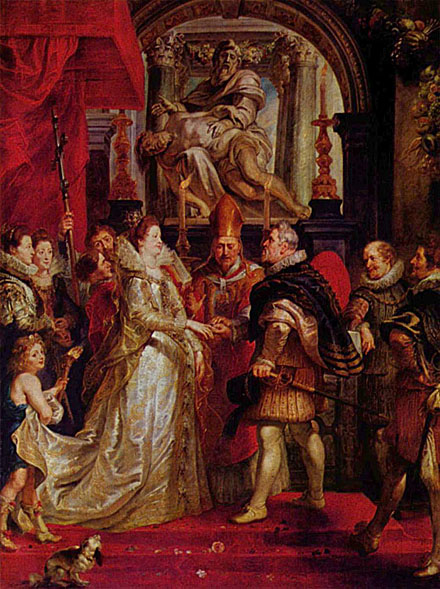
The Wedding by Proxy of Marie de' Medici to King Henri IV (1622-25): Rubens depicts the marriage ceremony of the Florentine princess Marie de' Medici to the King of France, Henri IV which took place in the cathedral of Florence on October 5, 1606. Cardinal Peitro Aldobrandini presides over the ritual, however since Henri IV was too busy to attend his own wedding, the bride's uncle, the Grand Duke Ferdinand of Tuscany stood in his place and is pictured here slipping a ring on his niece's finger. All the surrounding figures are identifiable, including the artist himself. Although he was present at the actual event twenty years earlier, as a member of the Gonzaga household during his travels in Italy, Rubens appears youthful and stands behind the bride, holding a cross and gazing out at the viewer. It is highly unlikely that Rubens actually had such a pronounced presence in this scene when it took place. Those who attended the ceremony for Marie include Christine de Lorraine, Grand Duchess of Tuscany and Marie's sister Eleonora, Duchess of Mantua; and in entourage of Grand Duke are Roger de Bellegarde, Grand Esquire of France, and the Marquis de Sillery, who negotiated the marriage. As in other scenes in the Medici Cycle, Rubens includes a mythological element: the ancient god of marriage, Hymen wearing a crown of roses, carries the bride's train in one hand and the nuptial torch in the other. The scene takes place below a marble statue, which depicts God the Father mourning over the dead body of Christ, alluding to the Pieta sculpture by Baccio Bandinelli (1493-1560).
The Disembarkation at Marseilles
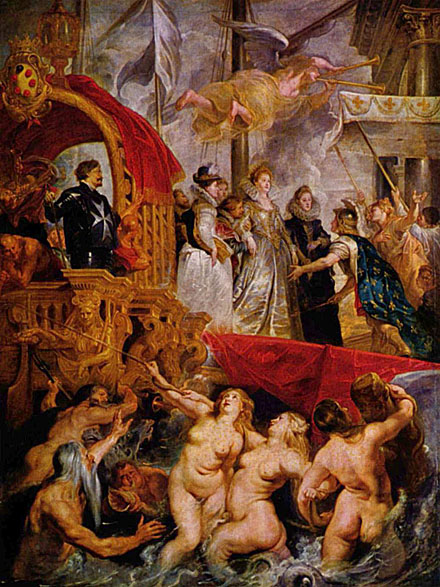
Having never been a particularly graceful event for anyone, disembarking a ship does not pose a problem for Rubens in his depiction of Marie de' Medici arriving in Marseilles after having been married to Henri IV by proxy in Florence. Rubens has again, turned something ordinary into something of unprecedented magnificence. He depicts her leaving the ship down a gangplank (she actually walked up, not down, but was illustrated this way by Rubens to create a diagonal element). She was accompanied by the Grand Duchess of Tuscany and her sister, the Duchess of Mantua, into the welcoming, allegorical open arms of France, evidenced by the golden fleur-de-lis on his cape of royal blue. Her sister and aunt flank Marie while two trumpets are blown simultaneously by an ethereal Fame. All this occurs while Neptune and his corps of Nereids rise from the sea, after having accompanied her on the long voyage to procure her safe arrival in Marseilles. It is melody and song as Rubens combines heaven and Earth, history and allegory into a symphony for the eyes of the viewer. Moreover, in The Debarkation at Marseilles, Marie is welcomed to her new home by a personified France, wearing a helmet and a blue mantle with golden fleur-de-lis in the painting. Above, Fame blows two horns to announce her arrival to the people of France with her future husband. Below, Neptune, three sirens, a sea-god, and a triton help escort the future Queen to her new home. To the left, the arms of the Medici can be seen above an arched structure, where a Knight of Malta stands in all of his regalia. On a side note, Avermaete discusses an interesting idea that is particularly present in this canvas.
The Meeting of Marie de' Medici and Henri IV at Lyons
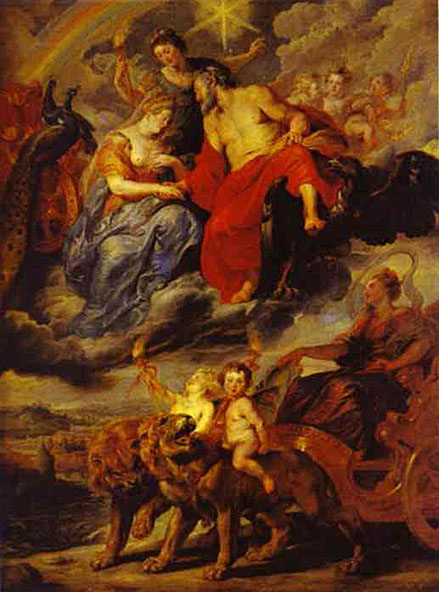
This painting allegorically depicts the first meeting of Marie and Henri, which took place after their nuptials by proxy. The upper half of the painting shows Marie and Henri as the mythological Roman gods Juno and Jupiter. The representations are accompanied by their traditional attributes. Marie is shown as Juno (Greek Hera) identified by the peacocks and chariot. Henri is shown as Jupiter (Greek Zeus) identified by the fiery thunderbolts in his hand and the eagle. The joining of the couple's right hands is a traditional symbol of the marriage union. They are dressed in the classical style, which is naturally appropriate to the scene. Above the two stands Hymen who unites them. A rainbow extends from the left corner, a symbol of concord and peace. The lower half of the painting is dominated by imagery of Lyons. Reading from left to right, we see the cityscape with its single hill. The lions pull the chariot (which is a pun on the name of the city), and in the chariot we see the allegorical figure of the city herself with a crown of her battlements: Lyons. Rubens needed to be very careful in the representation of the couple's first meeting because allegedly Henri was very much involved with a mistress at the time of the marriage. In fact, due to the king's other engagements their introduction was delayed, and it was not until midnight nearly a week after Marie arrived that Henri finally joined his bride. By presenting him as Jupiter Rubens implies the promiscuity of the man and the deity. Simultaneously by placing King and Queen together he effectively illustrates the elevated status of the couple.
The Birth of the Dauphin at Fontainebleau
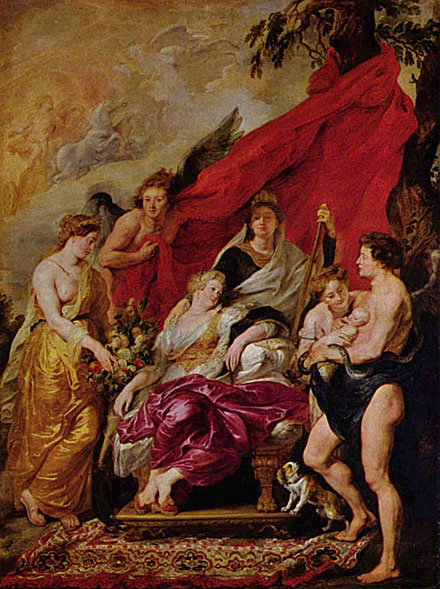
This painting depicts the birth of Marie de' Medici's first son, Louis XIII. Rubens designed the scene around the theme of political peace. The birth of the first male heir brings a sense of security to the royal family that they will continue to rule. In those times an heir was of the utmost importance, especially if Henri wanted to showcase his masculinity and discontinue with the pattern of the royal reproductive failure. The word dauphin is French for dolphin, a term associated with princely royalty. Henri's promiscuity made difficult the production of a legitimate heir, and rumors circulated to the extent that Henri's court artists began to employ strategies to convince the country otherwise. One of these strategies was to personify Marie as Juno or Minerva. By representing Marie as Juno, implying Henri as Jupiter, the king is seen domesticated by marriage. The queen's personification as Minerva would facilitate Henri's military prowess and her own. As a Flemish painter Rubens includes a dog in the painting, alluding to fidelity in marriage. In addition to the idea of political peace Rubens also includes the personification of Justice, Astraea. The return of Astraea to earth is symbolic of the embodiment of continuing Justice with the birth of the future king. Louis is nursed by Themis, the goddess of divine order, referring to Louis XIII birthright to one day become king. The baby is quite close to a serpent, which is a representation of Health. Rubens incorporates the traditional allegory of the cornucopia, which symbolizes abundance, to enhance the meaning of the painting by including the heads of Marie de' Medici's children who have yet to be born among the fruit. While Marie gazes adoringly at her son, Fecundity presses the cornucopia to her arm, representing the complete and bountiful family to come.
The Consignment of the Regency
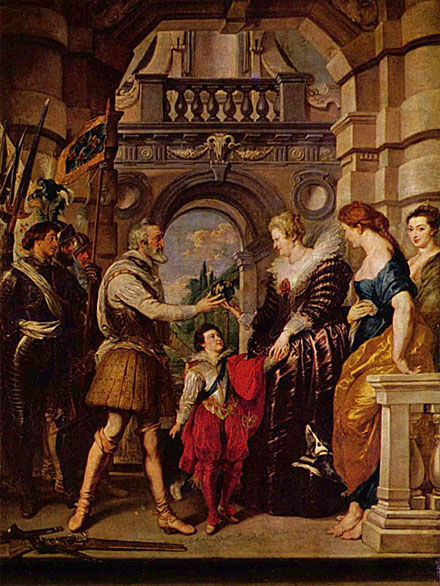
Throughout the depictions of Marie de' Medici's life, Rubens had to be careful not to offend either Marie or the king, Louis XIII, when portraying controversial events. Marie commissioned paintings that truthfully followed the events of her life, and it was the job of Rubens to tactfully convey these images. More than once, the artistic license of the painter was curbed in order to portray Marie in the right light. In The Consignment of the Regency, Henri IV entrusts Marie with both the regency of France and the care of the dauphin shortly before his war campaigns and eventual death. Set within a grand Italian-style architectural setting, the theme is somewhat sobering. Prudence, the figure to the right of Marie, was stripped of her emblematic snake to lessen the chances any viewer would be reminded of Marie's rumored involvement in the King's assassination. The efficacy of the form is lost in order to ensure Marie's representation in a positive light. Other changes include the removal of the Three Fates, originally positioned behind the king calling him to his destiny, war, and death. Rubens was forced to remove these mythical figures and replace them with three generic soldiers.
Also worthy of note in this painting is the first appearance the orb as a symbol of the "all-embracing rule or power of the state". This particular image appears to carry significant weight in Rubens's iconographic program for the cycle, as it appears in six (one quarter) of the twenty-four paintings of the cycle. This orb functions both as an allusion to the Roman orbis terrarum (sphere of earth) which signifies the domain and power of the Roman emperor, and as a subtle assertion of the claim of the French monarchy upon the imperial crown. While Rubens was certainly aware of the inherent meaning of the orb and employed it to great effect, it appears that Marie and her counselors instigated its introduction into the cycle to add allegorical and political grandeur to the events surrounding Marie's regency.
The Coronation in Saint-Denis

The Coronation in Saint-Denis is one of the few paintings in the cycle that does not contain any mythological figures. This painting is the last scene on the North End of the West Wall, showing the completion of Marie's divinely assisted preparation. It would be one of two paintings most visually apparent upon entrance into the gallery through the southeast corner. Rubens composes The Coronation in Saint-Denis for distanced viewing by employing accents of red. For example, the robes of two cardinals near the right edge. These accents also create a sense of unity with the neighboring work, Apotheosis of Henri IV and the Proclamation of the Regency.
This painting is a representation of an historical event in the life of the Queen where the King and the Queen were crowned at the basilica of Saint-Denis in Paris. Considered one of the principle paintings in the series along with the Apotheosis of Henri IV and the Proclamation of the Regency both scenes also show Marie de' Medici receiving the orb of state. She is conducted to the altar by the Cardinals Gondi and de Sourdis, who stand with her along with Mesieurs de Souvrt and de Bethune. The ceremony is officiated by Cardinal Joyeuse. The royal entourage includes Dauphin, the Prince of Conti with the crown, the Duc de Ventadour with the scepter, and the Chevalier de Vendome with the hand of Justice. The Princess de Conti and the Duchess de Montpensier carry the train of the royal mantle. Above in the tribune appears Henri IV, as if to give sanction to the event. The crowd below in the basilica raise their hands in acclamation of the new Queen, and above, the classical personifications of Abundantia and Victoria shower the blessings of peace and prosperity upon the head of Marie. Also, her pet dogs are placed in the foreground of the painting. Henri, not included within the centralized group, has been removed from the main scene to the balcony in the background. Also to be noted are the two winged Victories that hover above, pouring the golden coins of Jupiter. Rubens inspiration for the blue coronation orb emblazoned with golden lilies was Guillaume Dupres' presentation medal struck in 1610 at Marie's' request portraying her as Minerva with Louis XIII as Apollo-Sol. The symbolism carried the message that she was charged with the guidance of the young, soon-to-be king.
The Death of Henri IV and the Proclamation of the Regency
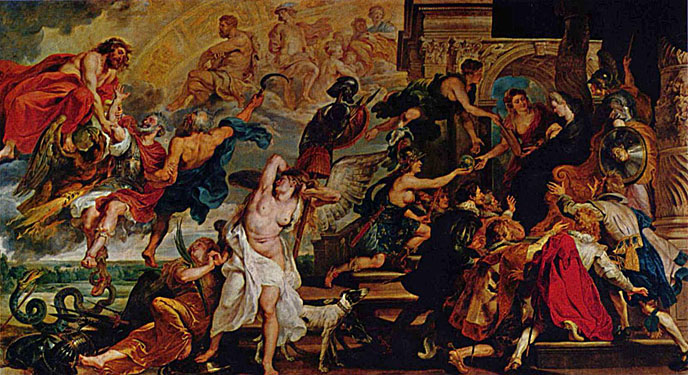
Sometimes also referred to as The Apotheosis of Henri IV and The Proclamation of the Regency, this particular painting within the Medici Cycle as a whole, was placed originally by Rubens as a series of three. The other two having similar design measurements, it was consigned as the middle painting in a pseudo triptych of sorts as it adorned the halls of Marie de' Medici's Palais du Luxembourg.
The painting is separated into two separate, but related scenes: the elevation of Henri IV to the heavens (he had been assassinated on the 14th of May 1610 which resulted in the immediate declaration of Marie as regent and the assumption of Marie to the crown.
On the left, Jupiter and Saturn are shown welcoming the assassinated King of France, as he ascends as a personified Roman sovereign, victoriously to Olympus. As with all of Ruben's allegorical paintings, these two figures are chosen for a reason. Jupiter is meant to be the King's celestial counterpart, while Saturn, who represents finite time, is an indication of the end of Henri's mortal existence. This particular theme, within the painting as a whole, has found other great masters receiving inspiration and fascination from Rubens' tormented figure of Bellona, the goddess of War, who lays disarmed below. Post-Impressionist, Paul Cézanne (1939-1906) registered for permission to copy the goddess as many as ten times. It should be kept in mind that Rubens's energetic manner of placing all these allegorical themes are substantially resultant from classical coins as documented through communication with his friend and notable collector of antiquities, Nicolas-Claude Fabri de Peiresc. The right side of the panel shows the succession of the new Queen, dressed in solemn clothing suited to a widow. She is framed by a triumphal arch and surrounded by people at the court, including the personification of France who is handing her a globe. The Queen accepts an orb, a symbol of government, from the personification of France while the people kneel before her and this scene is a great example of the exaggeration of facts in the cycle. Rubens stresses the idea of the Regency that was offered to the Queen, though she actually claimed it for herself the same day her husband was murdered.
Worthy of note is a possible contemporary inspirational influence on Rubens for the right side of this painting. Although originally started but may or may not have been finished in Rome, Caravaggio's Madonna of the Rosary may well have been an artistic influence on Rubens for the Proclamation of the Regency side of this painting, as the two works are highly corresponding in their presentation. Through a causal nexus, this painting would have been available to Rubens and thereby plausible for its influence to exist within Rubens's own genius on canvas. As a comparison, there are within each, two women upon a dais classical pillars, swathes of luxuriant cloth, genuflecting personages with arms extended, and allegorical figures present. In Rubens's painting, Minerva, Prudence, Divine Providence and France; in the Caravaggio, St Dominic, St Peter the Martyr, and a pair of Dominican monks. Also present in each are objects of importance: rudder, globe, and rosaries. All these and more, combine to make a persuasive argument and show a certain artistically respectful nod from Rubens to Caravaggio as two contemporaries of the time.
The Council of the Gods
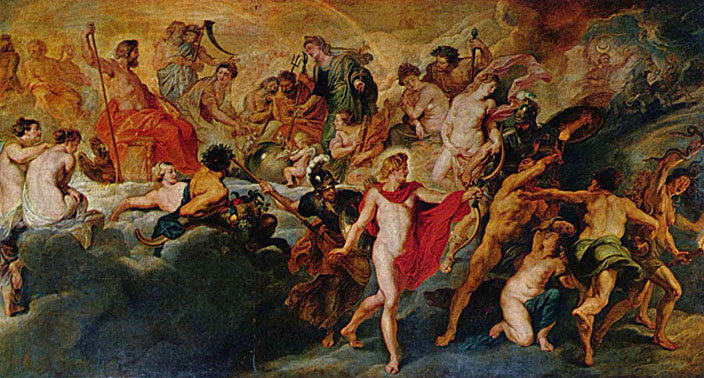
This painting commemorates Marie taking over the government as new regent, and promoting long-term plans for peace in Europe by way of marriages between royal houses.
Cupid and Juno bind two doves together over a split sphere in the painting as a symbol of peace and love. Marie hoped for her son, Louis XIII, to marry the Spanish Infanata Anne and for her daughter Elizabeth to marry the future king of Spain, Philip IV, possibly resulting in an alliance between France and Spain. To Marie de' Medici these unions were probably the most significant part of her reign, for peace in Europe was Marie's greatest goal.
The Council of the Gods is one of the least understood paintings of Marie de' Medici cycle. It represents the conduct of the Queen and the great care with which she oversees her Kingdom during her Regency. For example, how she overcomes the rebellions and the disorders of the State. It also suggests that she perpetuated the policies and ideals of the late King in his life and in death. The painting subjects are placed in a celestial setting which doesn't give way to a particular place, time or event. The scene is painted with a variety of mythological figures. This, along with its setting makes it difficult to figure out the subject matter of the work. The mythological figures include Apollo and Pallas, who combat and overcome vices such as Discord, Hate, Fury, and Envy on the ground and Neptune, Pluto, Saturn, Hermes, Pan, Flora, Hebe, Pomono, Venus, Mars, Zeus, Hera, Cupid, and Diana above.
Though originally intended to be displayed on the East Wall of the gallery in Marie's Luxembourg Palace in Paris, "The Council of the Gods" is now housed at the Louvre. The mythological figures and celestial setting act as allegories for Marie's peaceful rule over France.
The Regent Militant: The Victory at Jülich

The Victory at Jülich shows the only military event that the Queen participated in during her regency: the return of Jülich (or Juliers in French) to the Protestant princes. Being a crossing of Ruhr, Juliers was of great strategic importance for France and thus the French victory was chosen to be the glorious subject of Rubens' painting. The scene is rich with symbolism highlighting her heroism and victory. The Queen thrusts her arm high with an assembler's baton in hand. In the upper part of the image Victoria appears crowning her with laurel leaves which is a symbol of victory. Also symbolizing victory is the imperial eagle which can be seen in the distance. The eagle in the sky compels the weaker birds to flee. The Queen is accompanied by a womanly embodiment of what was once thought to be, Fortitude because of the lion beside her. However, the figure is Magnanimity, also referred to as Generosity, because of the riches held in her palm. One of the pieces in her hand is the Queen's treasured strand of pearls. Other figures include Fame and the personification of Austria with her lion. Fame in the right side of the painting pushes air through the trumpet so powerfully that a burst of smoke comes out. In the painting Marie de' Medici is highly decorated and triumphant after the collapse of a city, she is depicted across a white stallion to demonstrate that, like the departed King Henri IV, she could triumph over rivals in warfare.
The Exchange of the Princesses at the Spanish Border
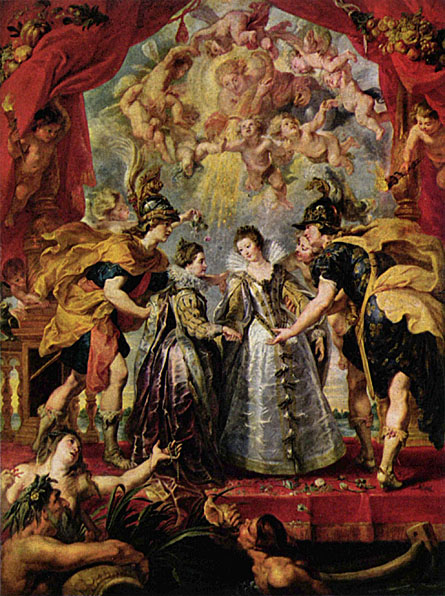
The Exchange of Princesses celebrates the double marriage of the Habsburg Infanta Anna of Spain to Louis XIII of France and Louis XIII's sister, Isabella Bourbon, to future king of Spain, Phillip IV on 9 November 1615. France and Spain present the young princesses, aided by a youth who is probably Hymen. Above them, two putti brandish hymeneal torches, a small zephyr blows a warm breeze of spring and scatter roses, and a circle of joyous butterfly-winged putti surround Felicitas Publica with the caduceus, who showers the couple with gold from her cornucopia. Below, the river Andaye is filled with sea deities come to pay homage to the brides: the river-god Andaye rests on his urn, a nereid crowned with pearls offers a strand of pearls and coral as wedding gifts, while a triton blows the conch to herald the event. The wedding, which was thought to secure peace between France and Spain, took place on a float midway across the Bidassoa River, along the French-Spanish border. In Ruben's depiction, the princesses stand with their right hands joined between personifications of France and Spain. Spain with a recognizable symbol of a lion on her helmet is on the left, whereas France, with fleur-de-lis decorating her drapery, is on the right. Anna, at age fourteen the older of the two, turns back as if to take leave of Spain, while France gently pulls her by the left arm. In turn, Spain can be seen taking the thirteen year old Isabella by her left arm.
The Felicity of the Regency of Marie de' Medici
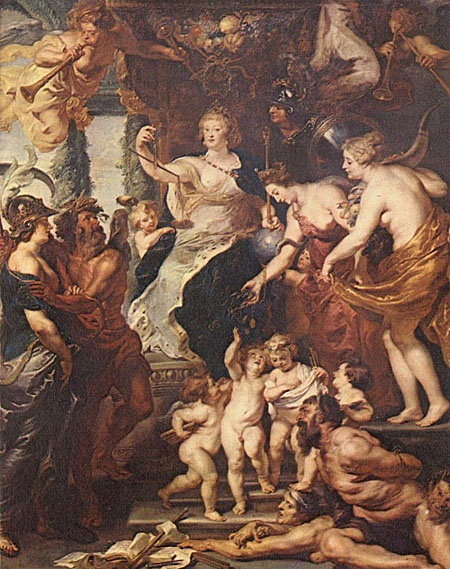
This particular painting in the Marie de' Medici Cycle is noteworthy for its uniqueness in execution. While the other paintings were completed at Rubens's studio in Antwerp, The Felicity of the Regency of Marie de' Medici was designed and painted entirely by Rubens on the spot to replace another, far more controversial depiction of Marie's 1617 expulsion from Paris by her son Louis. Completed in 1625, this is the final painting in the cycle in terms of chronological order of completion.
Here Marie is shown in allegorical fashion as the personification of Justice itself and flanked by a retinue of some of the primary personifications/gods in the Greek and Roman pantheon. These have been identified as Cupid, Minerva, Prudence, Abundance, Saturn, and two figures of Fame, all indicated by their traditional attributes, all bestowing their bounties on the Queen. (Cupid has his arrow; Prudence carries a snake entwined around her arm to indicate serpent-like wisdom; Abundance also appears with her cornucopia, also a reference to the fruits of Marie's regency. Minerva, goddess of wisdom, bears her helmet and shield and stands near Marie's shoulder, signifying her wise rule. Saturn has his sickle and is personified as Time here guiding France forward. Fame carries a trumpet to herald the occasion. These personifications are accompanied in turn by several allegorical figures in the guise of four putti and three vanquished evil creatures (Envy, Ignorance, and Vice) as well as a number of other symbols that Rubens employed throughout the entire cycle of paintings.
Though this particular painting is one of the most straightforward in the series, there is still some minor dispute about its significance. Rather than accept this as a depiction of Marie as Justice, some hold that the real subject of the painting is the "return to earth of Astraea, the principle of divine justice, in a golden age." They support this claim with a statement in Rubens's notes which indicates that "this theme holds no special reference to the particular reason of state of the French kingdom." Certain symbolic elements, such as the wreath of oak leaves (a possible corona civica), France being seen as a subjugated province, and the inclusion of Saturn in the scheme might all point to this interpretation and certainly would not have been lost on Rubens. Fortunately, and perhaps solely due to the controversy surrounding this painting, Rubens mentioned its significance in a letter to Peiresc dated 13 May 1625. It reads,
I believe I wrote you that a picture was removed which depicted the Queen's departure from Paris and that, in its place, I did an entirely new one which shows the flowing of the Kingdom of France, with the revival of the sciences and the arts through the liberality and the splendor of Her Majesty, who sits upon a shining throne and holds a scale in her hands, keeping the world in equilibrium by her prudence and equity.
Considering the haste with which Rubens completed this painting, his lack of specific reference to a golden age in his letter, and the existence of several contemporary depictions of Marie as a figure of Justice, most historians are content with the simpler allegorical interpretation which is more consistent both with Rubens's style and the remainder of the cycle.
It is believed that the original painting mentioned in the letter depicting Marie's departure from Paris was rejected in favor of The Felicity of the Regency due to the more innocuous subject matter of the latter. Rubens, in the same letter, goes on to say,
"This subject, which does not touch on the particular political considerations ... of this reign, nor have reference to any individual, has been very well received, and I believe that had it been entrusted altogether to me the business of the other subjects would have turned out better, without any of the scandal or murmurings."
Here, we can see evidence of the adaptability of Rubens' style which made his career so successful. His willingness to fit his ideas with those of the patron equipped him with the perfect tools to be in charge of such a delicate and heavily anticipated subject.
Louis XIII Comes of Age
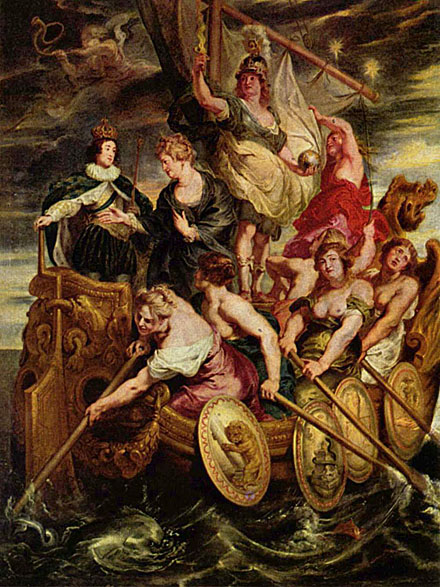
The painting Louis XIII Comes of Age represents the historical scene of the transferring of power from mother to son in abstract, or allegorical means. Marie has reigned as regent during her son's youth, and now she has handed the rudder of the ship to Louis, the new king of France. The ship represents the state, now in operation as Louis steers the vessel. Each of the rowers can be identified by the emblematic shields that hang on the side of the ship. The second rower's shield depicts a flaming altar with four sphinxes, a coiling serpent and an open eye that looks downwards. These characteristics are known to be that of Piety or Religion, both of which Maria would want her son to embody. What is also known as a parade boat, Rubens referencing Horace's boat, is adorned with a dragon on front and dolphins on the stern. Louis looks upwards to his mother for guidance on how to steer the ship of state. In the violent clouds are two Fames, one with a Roman buccina and the second with what seems to be a trumpet. Louis guides, while the ship's actual movement is due to the four rowing figures, personifying Force, Religion, Justice, and Concord. The figure adjusting the sail is thought to be Prudence or Temperance. At the center in front of the mast stands France, with a flame in her right hand illustrating steadfastness and the globe of the realm, or the orb of government, in her left. Force, extending her oar and heaving to, is identified by the shield just beneath her showing a lion and column. She is paired with Marie by the color of their hair, and similarly Louis is paired with Religion, or the Order of the Holy Spirit. The pairing of Marie with the figure of Force gives power to the image of the queen, while Marie's actual pose is more passive, showing very effectively her graceful acknowledgement of her son's authority henceforth. It is an interesting painting to examine within the context of the tense relationship between the young king and his mother. Sometime just prior to his coronation, Louis XIII and Marie de' Medici had a quarrel, leading to the exile of the queen. Rubens obviously would have known this and so chose to ignore the tension surrounding Marie's relationship with her son, instead emphasizing her poise in the transfer of power.
The Flight from Blois

The Flight from Blois is a depiction of Queen Marie escaping from confinement at Blois. The Queen stands in a dignified manner, suggesting her poise in times of disarray, amongst a chaotic crowd of handmaidens and soldiers. She is led and protected by a representation of France, and guided by illustrations of Night and Aurora. They are used literally to portray the actual time of the event and shield the queen from spectators as they illuminate her path. Rubens painted a scene of the event in a more heroic nature rather than showing the accuracy of realistic elements. According to historical records of the Queen's escape, this painting is not truthfully reflecting the moment of the occurrence. Rubens did not include many of the negative aspects of the event, fearing that he would offend the Queen, which resulted in the paintings non-realistic nature. The Queen Marie is depicted in a humble way, yet the illustration implies her power over the military. She does not express any hardships she had gone through by the escape. The male figures in foreground reaching for are unknown. The larger figures in the background represent the military, who were added to have a symbolic meaning of the Queen's belief in the command over military.
The Negotiations at Angouleme

In The Negotiations at Angouleme, Marie de' Medici genially takes the olive branch from Mercury, the messenger god, in the presence of both of her priests, as she gives her consent to have discussions with her son concerning her clash to his governmental direction. Rubens uses several methods to portray Queen Marie in precisely the light that she wanted to be seen, as her young son's guardian and wise advisor. Enthroned on a pedestal with sculptures of Minerva's symbols of wisdom and two putti holding a laurel wreath to represent victory and martyrdom, the representation of Marie de' Medici is quite clear. Her humble, yet all-knowing gaze conveys the wisdom that she holds. She is also placed compositionally in a tight and unified group with the cardinals, signifying a truthful side opposed to Mercury's dishonesty. Rubens gave Mercury an impression of untruthfulness by illustrating his figure hiding a caduceus behind his thigh. The effect of the two groups of figures is meant to stress the gap between the two sides. Rubens also added a barking dog, a common reference used to indicate or warn someone of foreigners who came with evil intention. All of these symbols, Rubens displayed in this ambiguous and enigmatic painting to represent or "misrepresent" Marie de' Medici in the manner that portrayed her as the prudent, yet caring and humble mother of a young and naive monarch. Overall, this painting is the most problematic or controversial, as well as the least understood out of the entire cycle. This image is of; once again, Marie claiming her of regal authority yet was nonetheless the first step towards peace between mother and son.
The Queen Opts for Security
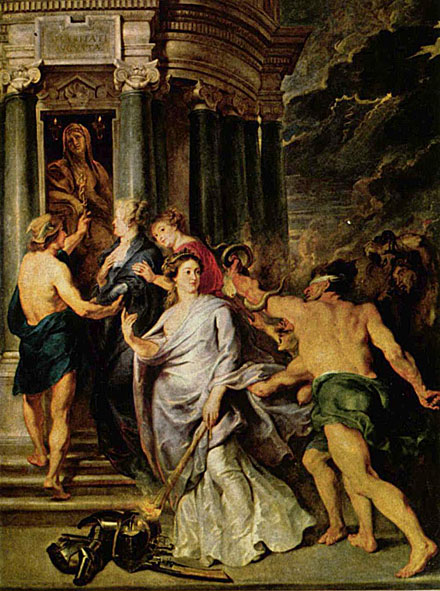
Rubens's The Queen Opts for Security represents Marie de' Medici's need for security through a depiction of the event when Marie de' Medici was forced to sign a truce in Angers after her forces had been defeated at Ponte-de-Ce. Though the painting shows Marie de' Medici's desire for security with the representation of the Temple of Security, the symbols of evil at bay, and the change of smoky haze to clarity, there is also underlying symbolism of unrest to the acceptance of the truce. The round shape of the temple, like those built by the ancients to represent the world, and has an Ionic order that is associated with Juno and Maria herself. The temple defines itself, by also including a plaque above the niche that says "Securitati Augustae" or For the Secturity of the empress. She is shown with the snakes of the caduceus emblem having uneasy movement and the forced escorting of the queen by Mercury into the Temple of Peace give the feeling of a strong will not to be defeated. It can also be debated that the painting is not really about peace or security, but really a unrelenting spirit that does not give into loss. As she is a divine power, she is heroically depicted in a classical setting using neoplatonic hierarchy and visual cues of light on her face. These ultimately imply that this allegory of Marie de' Medici is an apotheosis. Additionally, the inclusion of two differently adorned personifications of Peace hints at the fact that Rubens wanted confuse or excite the viewer to look deeper into the this particular painting as a whole.
Reconciliation of the Queen and her Son

The Return of the Mother to Her Son tenuously held an alternate title The Full Reconciliation with the Son after the Death of the High Constable until the temperament of the nation was assessed. The many headed hydra struck a fatal blow by Divine Justice as witnessed by Divine Providence, a theme based on a classical seventeenth century metaphor for insurrection. Here the monster is a stand in for the dead Constable de Luynes who has met its demise at the hand of a feminine Saint Michael. The death in 1621 of the falconer turned supreme commander may have improved the tensions between mother and son, but Conde, considered the most dangerous of Marie de' Medici's foes quickly stepped in to fill the gap. Rubens' deliberate vagueness would be consistent with his practice of generalizing and allegorizing historical facts especially in a painting about peace and reconciliation. Marie, desiring vindication for the death of her close personal friend, Concini, would likely have intended a more direct personal allusion to Constable de Luynes, but Rubens preferring to keep to allegory, avoided specifics that could later prove embarrassing. The artist chose the high road, relying on Ripa's visual vernacular, to portray a scene where virtues defeat vices and embrace peaceful reconciliation making little more than an allusion to a vague political statement.
It is not hard to imagine the much maligned scapegoat Luyens as the one suffering divine punishment and being thrown into the pits of hell while assuming all the blame for the animosity between Louis XIII and his mother. In this painting, Louis XIII, represented as an adult, is depicted as Apollo. The hydra's death is not at the hand of Apollo as might be expected. Instead it is left to an Amazon-like vision of Providence/Fate. With the removal of the scales she carried in an earlier sketch that would have connected her to Louis XII, we are left with an entity who with no help from Louis, slays the adversary as he appears oblivious and unconcerned. Marie de' Medici however, emerges as a loving mother, ready to forgive all evils and pain endured.
The Triumph of Truth
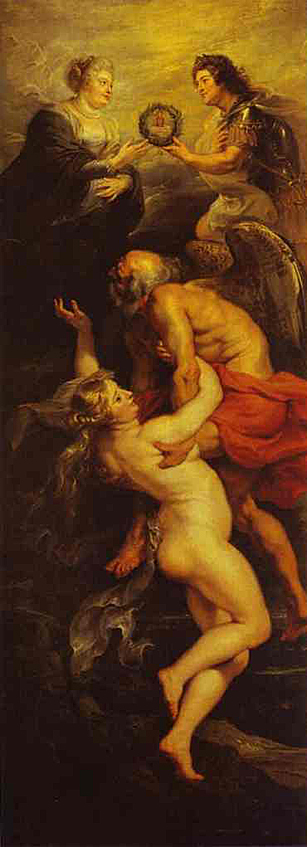
The last painting in the cycle, The Triumph of Truth, is a purely allegorical depiction of King Louis XIII and his mother, the Queen, reconciling before heaven. The Queen and Louis XIII are depicted floating in heaven, connected by the symbol of Concordia, which demonstrates her sons' forgiveness and the peace that was reached between them. Below, Saturn raises Veritas to heaven which symbolizes truth being, "brought to the light," as well as the reconciliation between the Queen and her son. The illustrations of Time and Truth occupy almost 3/4 of the lower canvas. The upper part of the canvas is filled with renderings of Marie and her son. In the composition, Marie is depicted as much larger than her son and occupies much more space. Her larger, less obscured body is turned frontally on the picture plane, which emphasizes her importance. Her importance is further highlighted by her equal height to her son, the King. Her son who is obscured in part by the Wing of Time, kneels before the queen and presents her with the token of amity, the clasped hands and flaming heart within a laurel crown. Compositionally, Rubens gives the queen greater importance in this panel through the use of gestures and gazes. In the work, Truth gestures toward the Queen while Time looks toward her from below. Both figures ignore the King. Rubens artfully projected both mother and son into the future, depicting them as more aged and mature than in the preceding panel (Peace is Confirmed in Heaven). It is at this point that the Medici Cycle changes to the subject of the Queen Mother's reign.[98] With the death of son Louis' court favorite, Charles d'Albert de Luynes, mother and son reconcile. Marie receives ultimate vindication by being re-admitted to the Council of State in January of 1622. This picture represents how time thus uncovers the truth in correspondence to the relationship between Marie and her son.
The final painting coincided with Marie's interest in politics after the death of her husband. She believed that diplomacy should be obtained through marriage and it is the marriage of her daughter Henrietta Maria to Charles I that rushed the completion of the Medici Cycle.
After the end of the Twelve Years' Truce in 1621, the Spanish Habsburg rulers entrusted Rubens with a number of diplomatic missions. Between 1627 and 1630, Rubens's diplomatic career was particularly active, and he moved between the courts of Spain and England in an attempt to bring peace between the Spanish Netherlands and the United Provinces. He also made several trips to the Northern Netherlands as both an artist and a diplomat. At the courts he sometimes encountered the attitude that courtiers should not use their hands in any art or trade, but he was also received as a gentleman by many. It was during this period that Rubens was twice knighted, first by Philip IV of Spain in 1624, and then by Charles I of England in 1630. He was awarded an honorary Master of Arts degree from Cambridge University in 1629.
Rubens was in Madrid for eight months in 1628-1629. In addition to diplomatic negotiations, he executed several important works for Philip IV and private patrons. He also began a renewed study of Titian's paintings, copying numerous works including the Madrid Fall of Man (1628-29). During this stay, he befriended the court painter Diego Velázquez. The two planned to travel to Italy together the following year. Rubens, however, returned to Antwerp and Velázquez made the journey without him.
Madrid 'Fall of Man'
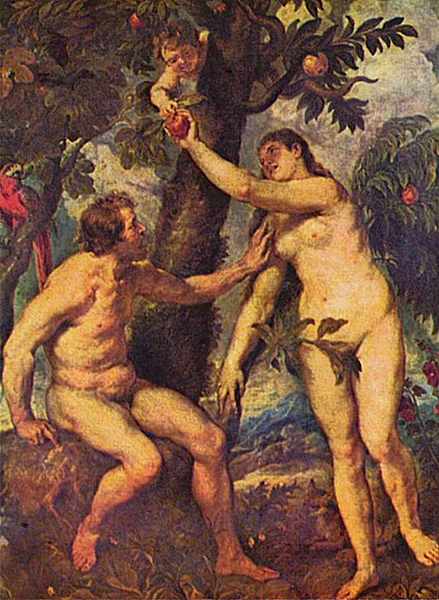
His stay in Antwerp was brief, and he soon traveled on to London. Rubens stayed there until April, 1630. An important work from this period is the Allegory of Peace and War (1629; National Gallery, London). It illustrates the artist's strong concern for peace, and was given to Charles I as a gift.
Minerva Protects Pax from Mars
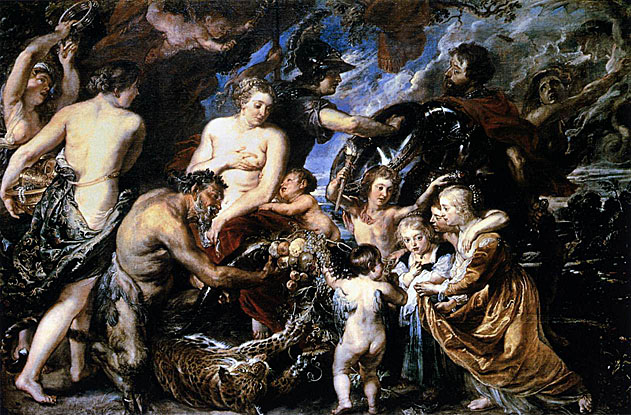
The painting was probably executed in England in 1629-30, illustrating Rubens's hopes for the peace he was trying to negotiate between England and Spain in his role as envoy to Philip IV of Spain. Rubens presented the finished work to Charles I of England as a gift.
The central figure represents Pax (Peace) in the person of Ceres, goddess of the earth, sharing her bounty with the group of figures in the foreground. The children have been identified as portraits of the children of Rubens's host, Sir Balthasar Gerbier, a painter-diplomat in the service of Charles I.
To the right of Pax is Minerva, goddess of wisdom. She drives away Mars, the god of war, and Alecto, the fury of war. A winged cupid and the goddess of marriage, Hymen, lead the children (the fruit of marriage) to a cornucopia, or horn of plenty. The satyr and leopard are part of the entourage of Bacchus, another fertility god, and leopards also draw Bacchus's chariot. Two nymphs or maenads approach from the left, one brings riches, the other dances to a tambourine. A putto holds an olive wreath, symbol of peace, and the caduceus of Mercury, messenger of the gods.
While Rubens's international reputation with collectors and nobility abroad continued to grow during this decade, he and his workshop also continued to paint monumental paintings for local patrons in Antwerp. The Assumption of the Virgin Mary (1625-6) for the Cathedral of Antwerp is one prominent example.
The Assumption of the Virgin Mary: 1626

The Assumption of the Virgin Mary or Assumption of the Holy Virgin is a painting by Peter Paul Rubens, completed in 1626 as an altarpiece for the high altar of the Cathedral of Our Lady, Antwerp, where it remains.
According to New Testament apocrypha, Jesus' mother Mary was physically assumed (raised) to heaven after her death. In Rubens depiction of the Assumption, a choir of angels lifts her in a spiraling motion toward a burst of divine light. Around her tomb are gathered the 12 apostles - some with their arms raised in awe; others reaching to touch her discarded shroud. The women in the painting are thought to be Mary Magdalene and the Virgin Mary's two sisters. A kneeling woman holds a flower, referring to blossoms that miraculously filled the empty coffin.
The Antwerp cathedral opened a competition for an Assumption altar in 1611. Rubens submitted models to the clergy on 16 February 1618. In September 1626, 15 years later, he completed the piece.
Rubens's last decade was spent in and around Antwerp. Major works for foreign patrons still occupied him, such as the ceiling paintings for the Banqueting House at Inigo Jones's Palace of Whitehall, but he also explored more personal artistic directions.
In 1630, four years after the death of his first wife, the 53-year-old painter married 16-year-old Helene Fourment. Helene inspired the voluptuous figures in many of his paintings from the 1630s, including The Feast of Venus (Kunsthistorisches Museum, Vienna), The Three Graces (Prado, Madrid) and The Judgment of Paris (Prado, Madrid). In the latter painting, which was made for the Spanish court, the artist's young wife was recognized by viewers in the figure of Venus. In an intimate portrait of her, Helene Fourment in a Fur Wrap, also known as Het Pelsken, Rubens's wife is even partially modeled after classical sculptures of the Venus Pudica, such as the Medici Venus.
The Feast of Venus
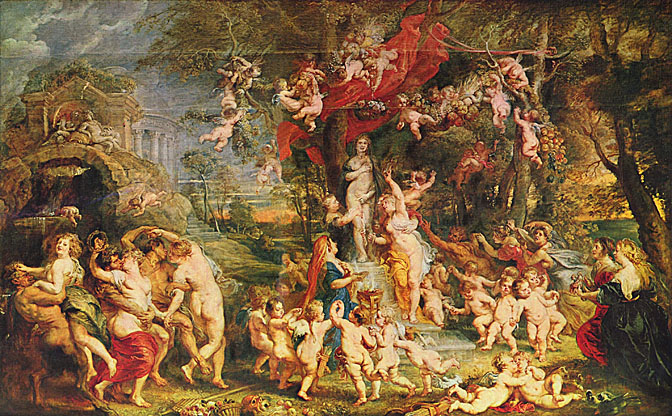
The Three Graces
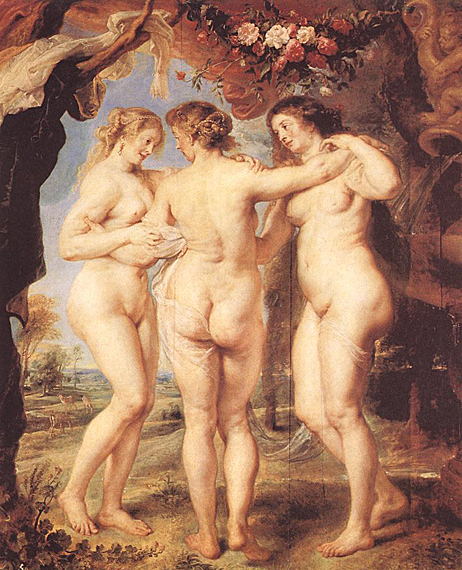
Charities (called in Latin Graces) ancient Greek divines for beauty, grace and artistic inspiration, and perhaps also, in their earliest form, of powers of vegetation. They are generally said to be tree sisters called Euphrosyne, Thalia and Aglaea. Their father was Zeus, mother either Eurynome, or Hera. They are usually depicted as naked girls embracing at each other. They frequently accompany Apollo, Athena, Aphrodite, Eros and Dionysus.
The Judgment of Paris
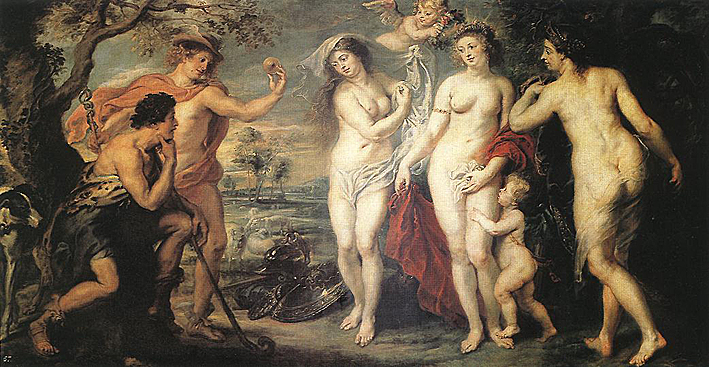
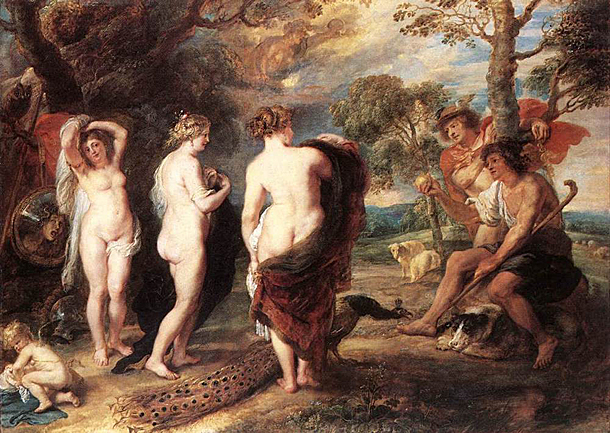
Rubens follows the story of the Judgement of Paris as told by Lucian in the 'Judgement of the Goddesses'.
Alterations to this work show that Rubens first painted an earlier moment in the story when Mercury ordered the goddesses to undress; the final stage shows Paris awarding the golden apple to Venus, who stands between Minerva and Juno; Mercury stands behind Paris; above is the Fury, Alecto.
Venus with a Fur Wrap
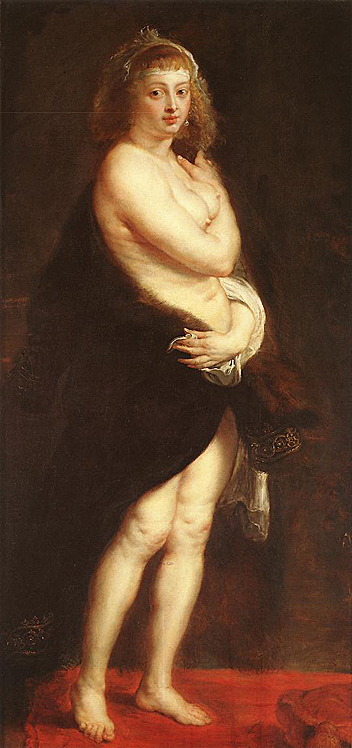
In this painting the artist portrayed his second wife, Helena Fourment nude but for a fur. This was certainly his favourite among the many paintings exhibiting her undeniable charms. At all events, he refused to part with Het Pelsken. In tones worthy of Titian, he painted Helena with curly hair, her nipples erect, her nudity barely concealed by a fur wrap better suited to her husband's bulk than her own. Her expression is difficult to read: is her mutinous air intended as a provocation, or was she simply anxious to wrap herself up against the cold?
Venus at a Mirror

The toilet of Venus is a timeless theme of sensuous seduction.
In 1635, Rubens bought an estate outside of Antwerp, the Chateau de Steen (Het Steen), where he spent much of his time. Landscapes, such as his Chateau de Steen with Hunter (National Gallery, London) and Farmers Returning from the Fields (Pitti Gallery, Florence), reflect the more personal nature of many of his later works. He also drew upon the Netherlandish traditions of Pieter Bruegel the Elder for inspiration in later works like Flemish Kermis (c. 1630; Louvre, Paris).
View of Het Steen
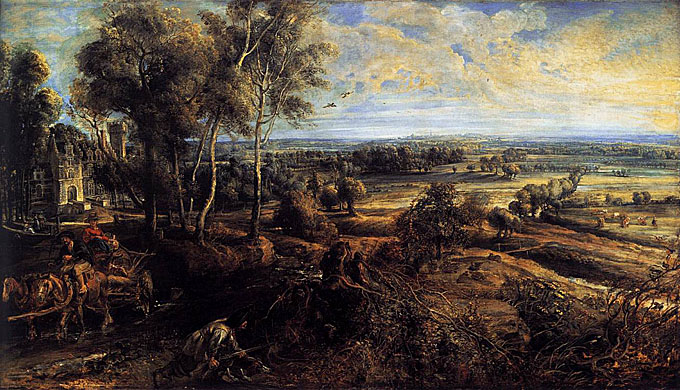
Farm at Laken
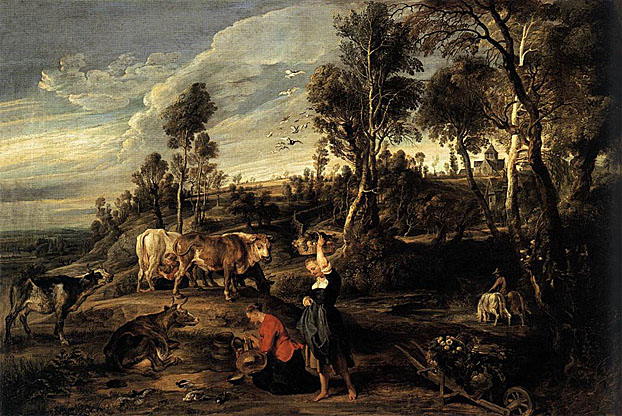
Rubens died from gout on May 30, 1640. He was interred in Saint Jacob's church, Antwerp. Between his two marriages the artist bore eight children, three with Isabella and five with Helene; his youngest child was born eight months after his death.
Rubens was a prolific artist. His commissioned works were mostly religious subjects, "history" paintings, which included mythological subjects, and hunt scenes. He painted portraits, especially of friends, and self-portraits, and in later life painted several landscapes. Rubens designed tapestries and prints, as well as his own house. He also oversaw the ephemeral decorations of the Joyous Entry into Antwerp by the Cardinal-Infante Ferdinand in 1635.
The Cardinal Infante Ferdinand
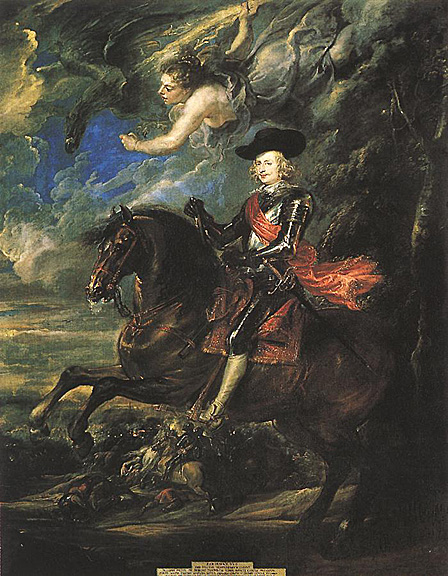
His drawings are mostly extremely forceful but not detailed; he also made great use of oil sketches as preparatory studies. He was one of the last major artists to make consistent use of wooden panels as a support medium, even for very large works, but he used canvas as well, especially when the work needed to be sent a long distance. For altarpieces he sometimes painted on slate to reduce reflection problems.
Paintings can be divided into three categories: those painted by Rubens himself, those which he painted in part (mainly hands and faces), and those he only supervised. He had, as was usual at the time, a large workshop with many apprentices and students, some of whom, such as Anthony Van Dyck, became famous in their own right. He also often sub-contracted elements such as animals or still-life in large compositions to specialists such as Frans Snyders, or other artists such as Jacob Jordaens.
At a Sotheby's auction on July 10, 2002, Rubens' newly discovered painting Massacre of the Innocents sold for 49.5million punds ($76.2 million) to Lord Thomson. It is a current record for an Old Master painting.
Massacre of the Innocents: 1621
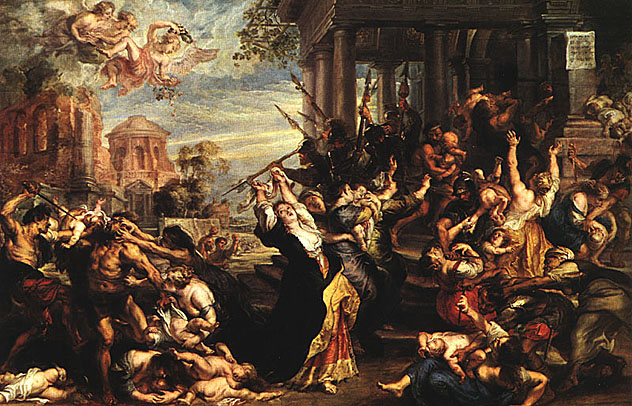
Recently in 2006, however, another lost masterpiece by Rubens, The Calydonian Boar Hunt, dating to 1611 or 1612, was sold to the Getty Collection in Paris for an unknown amount. It had been mistakenly attributed to a follower of Rubens for centuries until art experts authenticated it.
The Calydonian Boar Hunt
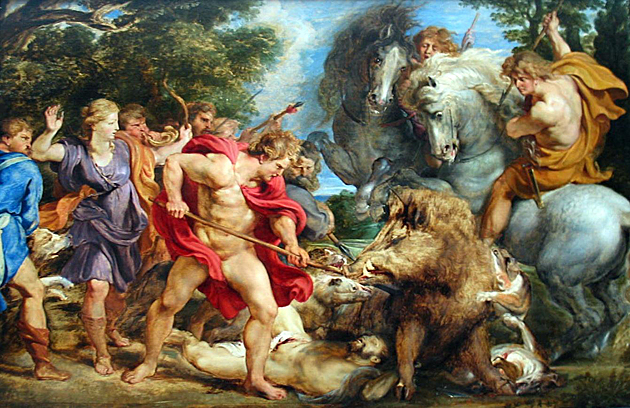
Press Release
The Calydonian Boar Hunt Ranks as One of the Greatest Paintings by Rubens in the United States
May 8, 2006
LOS ANGELES-The J. Paul Getty Museum has acquired The Calydonian Boar Hunt (about 1611-12), a newly discovered painting by 17th-century master Peter Paul Rubens (Flemish, 1577-1640) that was previously only known from later copies and engravings. It is one of the most significant works by Rubens to become available in a generation and ranks among his greatest paintings held in the United States. With this new acquisition, the Getty Museum will have the nation's most important collection of works by the artist from the innovative and crucial period following his return to Antwerp, which formed the foundation for the rest of his career. The painting will be on view to the public for the first time at the Getty Center from July 5, 2006.
"We are extremely excited about this rare find. It is seldom that a "lost" painting of such an innovative historical subject by an artist of this caliber comes to light again," says Michael Brand, director of the J. Paul Getty Museum. "What has been unknown to scholars until now is the extraordinary beauty and visual power of this painting, which epitomizes Rubens' assurance and technical brilliance at a key moment of his career. This acquisition offers us the opportunity to study and appreciate the work for the first time, establishing another connection to this influential talent. From this one painting, we can trace the root of Rubens' expressive style and his bold inventiveness, and observe his passion and personal affinity for classical art and literature."
The Calydonian Boar Hunt will be installed in the permanent collection galleries of the Getty Museum at the Getty Center. Here, among the Museum's outstanding 17th-century paintings collection, The Calydonian Boar Hunt will be displayed alongside works by Nicolas Poussin, Orazio Gentileschi, Jan Brueghel the Elder, and other contemporaries of Rubens. Visitors will be able to learn more about Rubens in two complementary exhibitions opening this summer-Rubens and Brueghel: A Working Friendship, and Rubens and His Printmakers. Both these Getty Museum exhibitions run concurrently at the Getty Center from July 5-September 24, 2006.
With The Calydonian Boar Hunt joining The Return from War: Mars Disarmed by Venus (1610-12) and The Entombment (about 1612), all painted at around the same time, the Museum will be able to vividly demonstrate the ingenuity of one of the greatest artists of the century during his formative years. Rubens' brilliant and descriptive brushwork in the panel has much in common with his oil sketches, another strength of the collection. The Getty's collection also includes one of the largest holdings of drawings by Rubens in the U.S., ranging from early examples such as Anatomical Study (about 1600-05) to the magnificent Assumption of the Virgin (about 1624).
Depicting the mythological hunt as told by Ovid, the painting is the artist's first treatment of this classical combat between men and beast, a rare subject in the 1600s. With this work, Rubens established a new genre, combining Flemish naturalism with Italian classical influences. Painted on his return from Italy, The Calydonian Boar Hunt reflects Rubens' study of statues from antiquity and reliefs on Roman sarcophagi, which informed the pose of his subjects and the tight composition of his scene.
Portraying the climactic instant when Meleager thrusts a spear into the boar, surrounded by robust hunters and the bloodied form of a fallen warrior, the painting is a superb expression of the Baroque style in its ability to depict emotion through action. It epitomizes the dramatic, powerful style Rubens brought to his battle scenes and his subjects from history. Combining dazzling brushwork and chiaroscuro light effects, the picture features two dynamic horses influenced by an awareness of Leonardo da Vinci. The Calydonian Boar Hunt shows Rubens at his most daring and inventive. It is thought that Rubens retained this painting in his studio as inspiration as he continued to develop the theme of the boar hunt and related subjects through the years.
Born in 1577, Peter Paul Rubens rose to become the preeminent painter in Antwerp, forging a bold style that earned him an international reputation and major public commissions. He embarked on an influential eight-year sojourn in Italy in 1600, where he served as court painter to the Duke of Mantua. Over the years Rubens worked across Europe, producing paintings for the rulers of France, England, and Spain, among others.
A Unique Collaboration
Peter Paul Rubens and Jan Brueghel the Elder were the most eminent painters in Antwerp, in present-day Belgium, during the first two decades of the 17th century. While it was common practice in the Netherlands around 1600 for two or more artists to contribute to a single composition, Rubens and Brueghel's partnership was extraordinary.
There are a few collaborative paintings by Rubens and Brueghel. It is their joint work which makes these paintings unique, and consider how these two great artists were able to work together. The results of recent technical analysis provide new insight into their collaborative working method.
Both painters served the Brussels court of the joint Habsburg regents of the Southern Netherlands, Archduke Albert and Archduchess Isabella. Fond friends, both in and out of the studio, Rubens and Brueghel accommodated each other's preferences and modified each other's contributions. While it has often been assumed that Rubens was the dominant partner, in fact it was Brueghel, senior by nine years, who often took the lead.
The two artists had distinctive individual styles. Brueghel was a renowned still-life and landscape specialist known for highly detailed works, while Rubens created large-scale history paintings. Brought together in the same painting, these individual styles result in highly inventive compositions. The rich context for joint productions in Antwerp is represented in the exhibition by Rubens and Brueghel's collaborative works with important contemporaries.
Collaboration of Jan Brueghel the Elder and Peter Paul Rubens
The Garden of Evil With the Fall of Man

The Return From War: Mars Disarmed by Venus

Vision of Saint Hubert
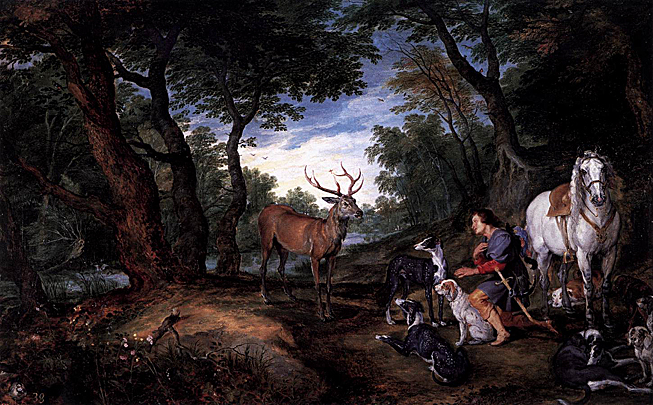
This painting is a fruit of collaboration between Rubens and Jan Brueghel, the former being responsible for the figures and the latter for the landscape.
St Hubert was born in the middle of the seventh century, son of a Duke of Aquitaine. He was elected as Bishop of Maastricht around 705. Later he was transferred to Liege, becoming its first bishop, and evangelized the Ardennes.
At the end of the middle ages, his life was enriched with a number of episodes borrowed from the legend of St Eustace, in particular his encounter with a miraculous stag. One Good Friday Hubert, a fearsome hunter, fell upon a stag with a crucified Christ between its antlers. Blinded in the manner of St Paul on the road to Damascus, he fell from his horse and knelt down. He heard a voice, "Hubert, Hubert, why do you pursue me? Will your love of hunting make you forever forgetful of your salvation?" Hubert immediately changed his life and retired to the forest of Ardennes. He then succeeded St Lambert as Bishop of Maastricht and performed numerous miracles. St Hubert now is the patron saint of hunters, and protector of hunting dogs.
Virgin and Child Surrounded by Flower and Fruit
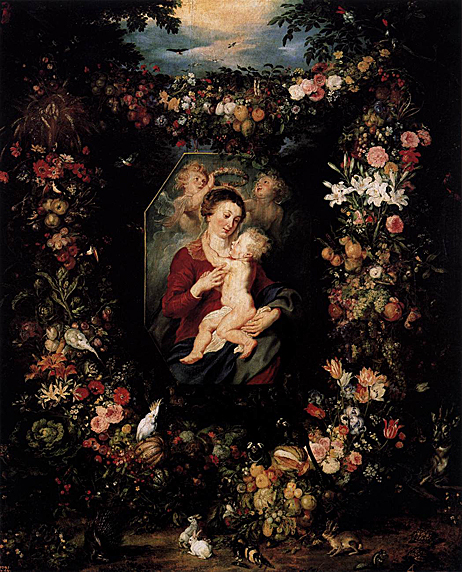
This painting is the result of collaboration between Rubens and Jan Brueghel, the former being responsible for the figures and the latter for the flowers and fruit.
Battle of the Amazons: 1618
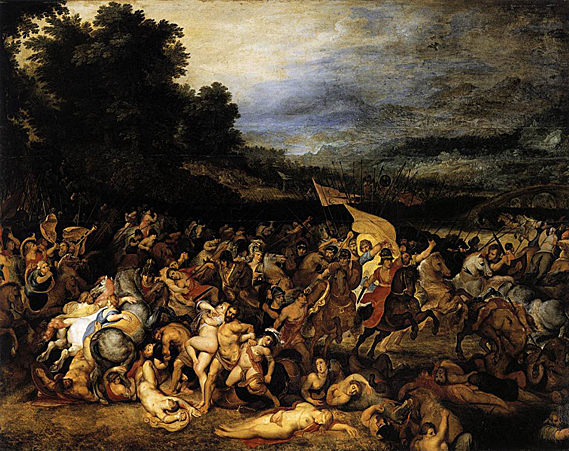
After becoming a master in 1678, Rubens also produced paintings in addition to graphic works. His earliest work was very similar in style to that of Van Veen. This is apparent from the rare juvenilia which can on good grounds be ascribed to Rubens, such as the Battle of the Amazons in Potsdam. The classicist portrayal of the characters goes back to Van Veen, but bears witness to a better anatomical insight than is often the case with him.
The Battle of the Amazons shows small figures in a landscape by Jan Brueghel, here Rubens followed the earlier and specifically Antwerp tradition of sharing out the tasks in landscapes with figures.
RELIGIOUS SUBJECTS
Adoration of the Shepherds: ca 1608

Rubens worked in Italy from 1600 to 1608 before returning to Antwerp. This masterpiece, commissioned for the church of San Filippo in Fermo, dates from the last year of his stay, while he was working in Rome for the Congregation of St. Philip Neri, and is one of his finest works from this period.
Its lighting, naturalism and human power owes much to the influence of Caravaggio and documents a significant development in Rubens' work.
Bathsheba at the Fountain: ca 1635
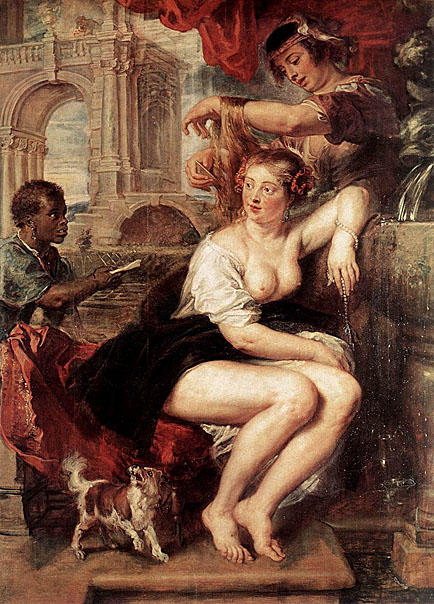
Rubens depicts Bathsheba at her toilet, sitting at a fountain. A messenger is shown arriving with a letter sent by King David who is barely visible at the upper left corner of the painting.
Christ at Simon the Pharisee: 1618-20
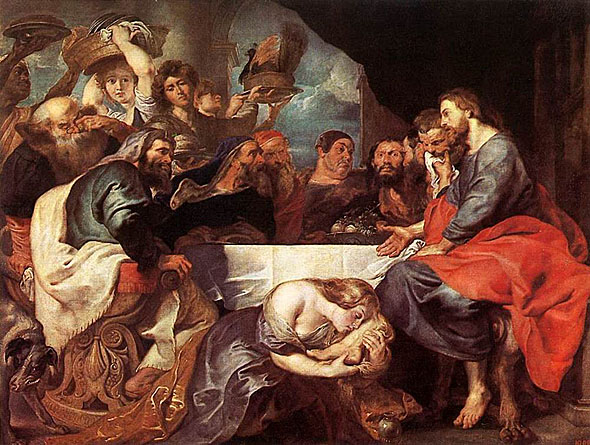
According to the Bible (Luke 7:40-50) Simon the Pharisee invited Jesus to share a meal. He received Jesus in his home. While they were at table, a sinner, occasionally taken wrongly to be Mary Magdalene, came and poured ointment over Jesus' feet.
Christ on the Cross between the Two Thieves: 1620
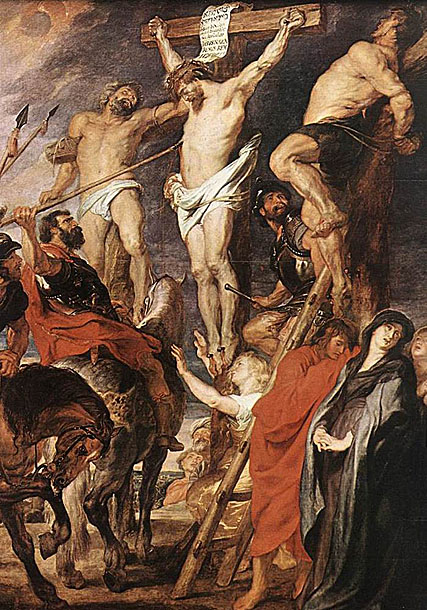
Rubens' close involvement with the resurgence of Catholicism and the struggle for power led to the production a numerous large altarpieces. His stirring baroque ideas come to the fore in The Lance, with its emotionally charged, highly plastic figures.
Daniel in the Lions Den: ca 1615
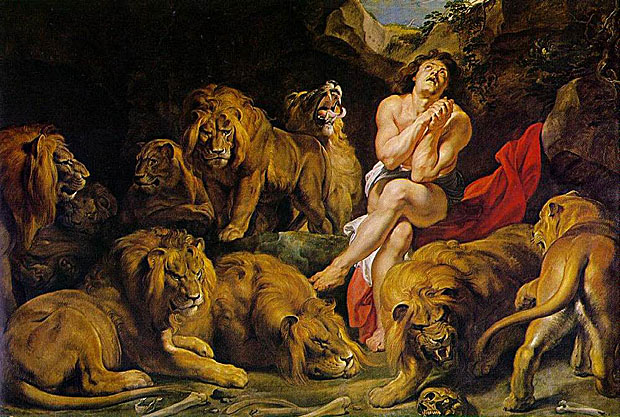
The Old Testament prophet Daniel, as chief counselor to the Persian king Darius, aroused the envy of the other royal ministers. Conspiring against the young Hebrew, they forced the king into condemning Daniel to a den of lions. The following dawn, Darius, anxious about his friend, had the stone that sealed the entrance rolled away to discover that Daniel had been miraculously saved. Rubens depicted the moment when, as the beasts squint and yawn at the morning light streaming into their lair, Daniel gives thanks to God.
The monumental size of the ten lions and their placement close to the viewer heighten the sense of immediacy. Within the asymmetrical baroque design, Daniel is the focal point. Against the brown tones of animals and rocks, his pale flesh is accented by his red and white robes as well as by the blue sky and green vines overhead.
In 1618, Rubens traded Daniel along with eight other paintings and some cash for a collection of more than a hundred ancient Roman busts and statues. During the transaction, Rubens described this canvas as: "Daniel among many lions, taken from life. Original, entirely by my hand." The North African lions Rubens used as his models were kept in the royal menagerie at Brussels. The Gallery has in its collection a study for the lion facing the viewer, standing to Daniel's right. (This Moroccan species, now extinct in the wild, may be seen at Washington's National Zoo.)
Fall of the Rebel Angels: 1620

In Christian belief, the angel Lucifer, backed by some angels, rebelled against God and was driven by God into Hell. This painting depicts the fall of Lucifer and other angels who rebelled against God.
Immaculate Conception: ca 1628
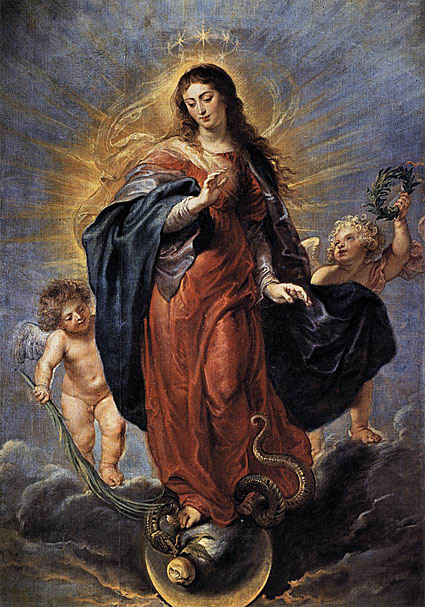
King Philip IV's affection for pictures was emulated by his courtiers who amassed large collections and helped to turn Madrid into one of the most active picture market in Europe. Diego Messia, the marquis of Leganes's beginnings as a collector was modest enough; in 1630, his inventory lists a mere eighteen works, eleven of which were ascribed to Titian. Twelve years later, the total increased to well over 1.100 pictures, among them masterpieces by Rubens and van Dyck, as well as a generous share by lesser Flemish masters. Leganes also collected the Flemish primitives. His Italian paintings included attributions to Titian, Raphael, Veronese and the Bassanos.
This Immaculate Conception by Rubens was also part of Leganes's collection.
Madonna Enthroned with Child and Saints: ca 1628
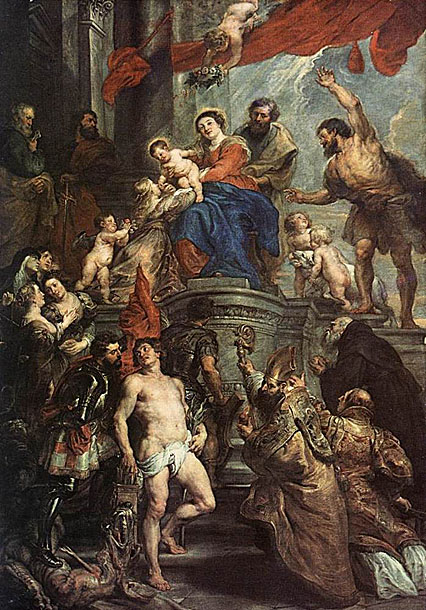
Madonna in Floral Wreath: ca 1620
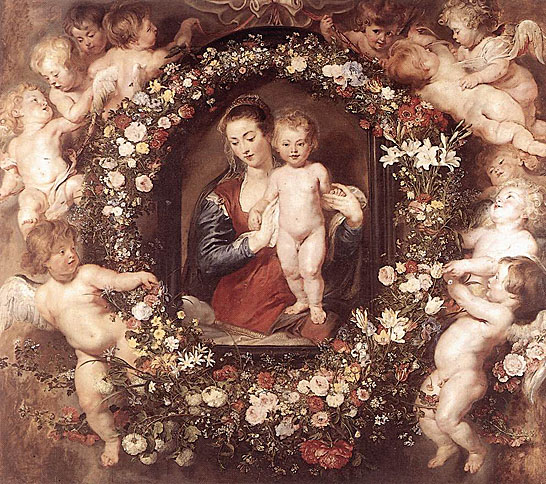
Religious flower still-lifes are a special category, first developed by the Fleming Daniel Seghers, a pupil of Jan Brueghel the Elder. However, this can be traced back to Rubens's Madonna in Floral Wreath (with the collaboration of Jan Brueghel the Elder). This represents a picture within a picture with an authoritative religious significance, encircled by a floral arrangement and cherubs. Unlike Seghers, however, Rubens did not quote Mary and Jesus as historical traditions or pictorial relics. Instead he preferred to give the impression that they were physically present, even though the motif of a picture within a picture would have been ideally suited for illusionist stylization.
This painting is a good example of the encounter of talents of Rubens and Jan Brueghel the Elder, one much appreciated by collectors. Each exhibits his own virtuosity, Rubens painting the figures and Brueghel the floral decoration.
Adoration of the Magi: 1618-19
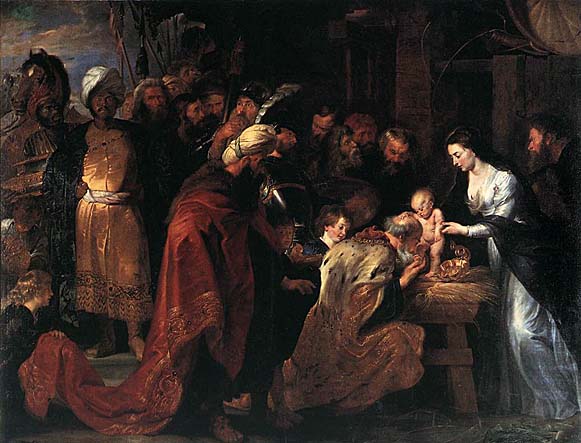
Adoration of the Magi: 1626-29
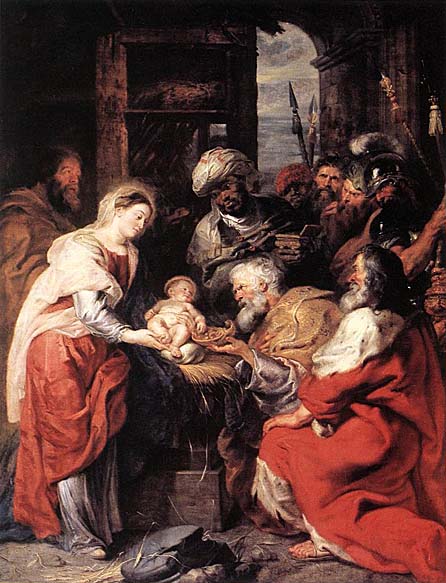
Altarpiece of Saint Ildefonso (right-panel): 1639
_1639.jpg)
The Ildefonso Altar is the main work of Rubens late period, when he was finally able to cut the "golden knot of ambition, as he called it, and give up his career as a diplomat and political advisor in order to devote himself exclusively to his art. The altar was commissioned by the Habsburg regent in the Low Countries, Clara Isabella, in memory of her deceased husband, Archduke Albert of Austria. Intended for the Ildefonso Brotherhood in Brussels, the altar is in the form of a mediaeval triptych, a form Rubens often used. The altar with its side panels closed shows a pastoral idyll of the "Holy Family Beneath an Apple Tree (also in this gallery). Opened up, a drama of solemn splendour unfolds in gold-brown and red tones. From the side panels and their show of princely pomp, Rubens moves into the centre of the triptych, a sacred sphere of miracle and vision. Seen kneeling in the wings, the ducal pair, each accompanied by his own patron saint, participate in the heavenly event: in the dusky semi-darkness of a church, the Virgin Mary appears to St. Ildefonso. Surrounded by holy maidens, she presents the pious man with a precious chasuble that he presses to his lips in ardour and humility. Rubens energetically flowing brushwork is sensual while softening form and transparent while compact. His style attains a hitherto unknown freedom and brilliance through the atmospheric shimmer of the setting and the evocative use of colour to create illusion. Here is the perfect blend of two divergent artistic traditions: the illusionism and colour sense of his beloved Venetians with the enamel-like, near-sighted depiction of body and surface from the Early Netherlandish school, the inheritance of his own Flemish home. One of the greatest masterpieces of all time, the Ildefonso Altar embraces the earthly and unearthly, the close and remote. It is a vision of colour and light that combines idealised princely-Catholic patronage with spiritualism and contemplative tranquillity.
The Annunciation: ca 1628

At the age of twenty-eight Rubens' works were accepted for the most historical locations, and have since entered the most prestigious collections. With paintings such as his Annunciation he was well on the way to fame.
Assumption of the Virgin: ca 1620
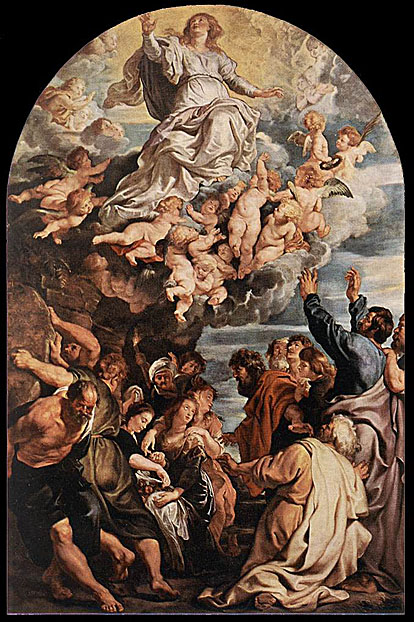
As recounted in the New Testament's Apocrypha, Jesus' mother Mary was physically raised, or assumed, to heaven after her death. In this Assumption of the Virgin, a choir of angels lifts Mary's body upward in a dramatic spiraling motion toward a burst of divine light. The twelve apostles gather around her tomb. Some raise their hands in awe; others reach down to touch her discarded shroud. The three holy women are probably Mary Magdalene and the Virgin Mary's two sisters. The kneeling woman holds a flower, referring to the blossoms that miraculously filled the empty coffin.
In 1611, the cathedral at Antwerp announced a competition for an Assumption altar. On 16 February 1618, Rubens submitted two modelli or models to the clergy. He finished the huge altarpiece in September 1626. Thus, fifteen years elapsed between the beginning and conclusion of this project. The cathedral needed the time to complete a majestic marble frame, and Rubens was preoccupied with other commissions.
The relation of the National Gallery's panel to the final altarpiece and to another, smaller sketch is a topic of scholarly debate. One of these paintings may be a later replica that Rubens or a member of his workshop made for a private patron.
Bethrotal of Saint Catherine: ca 1628
_CA_1628.jpg)
Christ on the Cross: 1627
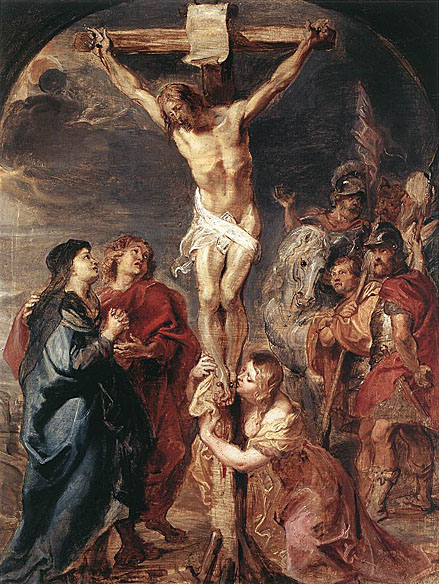
The Christ on the Cross is a typical example of an oil sketch made to serve as a design for a larger work, in this case an altarpiece for St. Michael's Church in Ghent, commissioned in 1627. However, because of the demands made on his time by his diplomatic missions, Rubens was unable to make the painting and the work was entrusted to Van Dyck, who prepared a new oil sketch based on Rubens' original design.
Lamentation of Christ: 1616-17
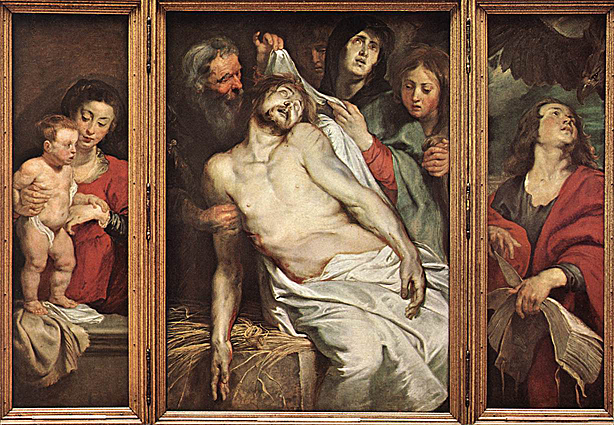
The Passion and Redemption of Christ are concentrated and brought together as if under a magnifying glass in "The Lamentation. Contemplating this painting, which was intended for private devotion, the viewer can make each of the sensuously painted details the starting point for a meditation on the Passion. Noteworthy is the harmony achieved between the intellectual concept of the didactic function of religious painting in the Counter-Reformation and the artistic concept, which fuses the ideal and the illusion of a tangible reality. The composition itself provides the ideal of classical form. Rubens figures, suffused with the warmth of life and in the grip of passion, provide the element of truth.
Cimon and Pero-1630
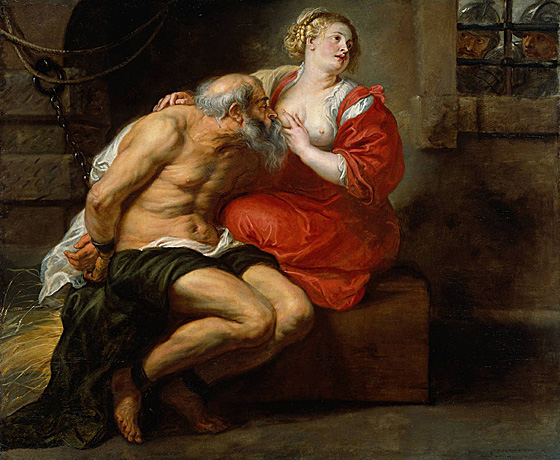
When the aged Cimon was forced to starve in prison before his execution, his devoted daughter Pero secretly visited her father to nourish him at her own breast. In his Memorable Acts and Sayings of the Ancient Romans, the ancient Roman historian Valerius Maximus, Pero's selfless devotion was presented as the highest example of honoring one's parent.
In the 1600s, major artists painted dramatic versions of the popular subject, which Jean-Baptiste Greuze and other artists revived a century later. Closely basing the setting and arrangement of figures on Peter Paul Rubens's version, Greuze probably made this oil sketch as the final stage of preparation for an unexecuted, large-scale painting. Contemporaries admired the rapid execution, vibrant colors, and lively paint handling in Greuze's oil sketches. The critic Denis Diderot lavishly praised his combination of genre and history painting and his public, moralizing purpose.
Return of the Prodigal Son: ca 1618
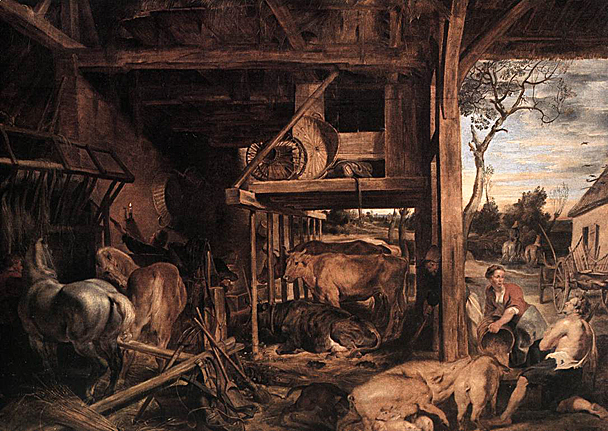
When Rubens died in 1640, he still possessed his Prodigal Son of 1618. Amongst his many grand altarpieces and dramatic mythological subjects, the creation of this rural scene, intended for his own living room, must have given him a great deal of pleasure. The biblical subject - depicted bottom right - serves merely as a vehicle for the painting of one of his earliest landscapes.
Saint Gregory with Saints Domitilla Maurus and Papianus: 1607
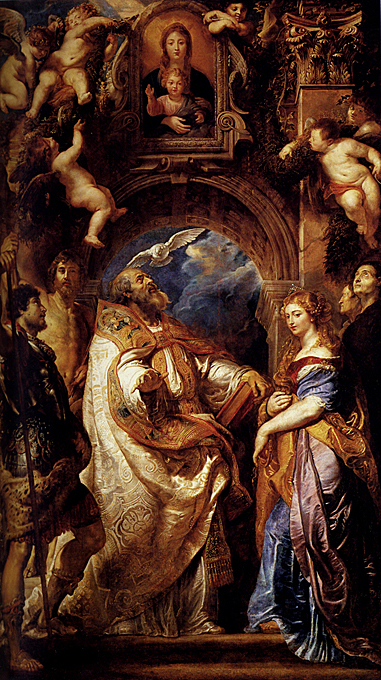
St. Maurus
A nobleman of Rome he died 584. He is represented as an abbot with crozier, or with book and censer, or holding the weights and measures of food and drink given him by his holy master. Sometimes he is depicted as above, dressed similarly to John the Baptist. He is the patron of charcoal-burners, coppersmiths etc. and in Belgium he is the patron of shoemakers; he is also invoked against gout, hoarseness etc. He was a disciple of St. Benedict, and his chief support at Subiaco. By St. Gregory the Great he is described as a model of religious virtues, especially of obedience.
St. Gregory the Great
Pope and Doctor of the Church
Son of a wealthy patrician, Gordianus, he was born and educated at Rome. He was prefect of Rome when the Lombard invasion of Italy was threatening Rome in 571. Long attracted to the religious life, about 574 he converted his home in Rome into St. Andrew's Monastery under Valentius, became a monk there, and founded six monasteries on his estates in Sicily. After several years of seclusion at St. Andrew's, he was ordained by Pope Pelagius II and was made one of the seven papal deacons in 578. He served as papal nuncio to the Byzantine court, 579-85, was recalled in 586, resumed his monastic life, and became abbot of St. Andrew's. He set out to evangelize England but was brought back to Rome by Pope Pelagius when plague struck Rome, 589-90. Pelagius was stricken and died, and Gregory was elected Pope and consecrated on September 3, 590. He restored ecclesiastical discipline, removed unworthy clerics from office, abolished clerical fees for burials and ordinations, and was prodigious in his charities. He administered papal properties wisely and justly, ransomed captives from the Lombards, protected Jews from unjust coercion, and fed the victims of a famine. In 593, he persuaded the invading Lombards under Agilulf to spare Rome, and he negotiated a peace with the Lombard King-----an unprecedented move that effectively set aside the authority of the Byzantine Emperor's representative, the exarch. This was the beginning of a series of actions by which Gregory resisted the arrogance, incompetence, and treachery of Byzantine authorities by which he appointed governors of the Italian cities, providing them with war materials and denouncing the heavy taxes levied on the Italians by Byzantine officials. He thus started on its course the acquisition and exercise of temporal power by the papacy. He was responsible for the conversion of England to Christianity by his interest in that country and his dispatch of St. Augustine of Canterbury and forty monks from St. Andrew's there and helped to secure Justinian's acknowledgment of papal supremacy. He sent missionaries to Germany, among them St. Corbinian and St. Boniface in 719, whom he consecrated bishop. He was untiring in his efforts to ensure that the papacy was the supreme authority in the Church, and denouncing John, Patriarch of Constantinople, for his use of the title Ecumenical Patriarch [he himself preferred as his own title "Servant of the Servants of God," a title used by Popes to this day, fourteen centuries later]. He was an eloquent preacher and was mainly responsible for the restoration of a Rome devastated by the invasions, pillages, and earthquakes of the century before his pontificate. He wrote treatises, notably his Dialogues, a collection of visions, prophecies, miracles, and lives of Italian Saints, and Liber regulae pastoral [on the duties of bishops], and hundreds of sermons and letters. Whether he was the compiler of the Antiphony on which the Roman rchola cantorum was based and several hymns attributed to him is uncertain, but he did greatly influence the Roman Mass. The custom of saying thirty successive Masses for a dead person goes back to him and bears his name, and to Gregory is due Gregorian Chant. He actively encouraged Benedictine monasticism, and his grant of privileges to monks often restricting episcopal jurisdictions was the beginning of later exemptions that were to bring religious orders directly under papal control. He is the last of the traditional Latin Doctors of the Church, is justly called "the Great," and is considered the founder of the medieval papacy. He died in Rome on March 12 and was canonized by acclamation immediately after his death.
St. Domitilla
A Christian Roman matron of the imperial family, she lived towards the close of the first century. She bore two sons, who, while children were adopted as his successors by Domitian and commanded to assume the names Vespasianus and Domitianus. It is quite probable that these two lads had been brought up as Christians by their pious mother, and the possibility thus presents itself that two Christian boys at the end of the first century were designated for the imperial purple in Rome. Their later fate is not known, but Domitilla was banished for her faith, after her husband was Martyred in 96 to the island of Pandataria in the Tyrrhenian Sea. She had a niece of the same name who was Martyred by being burnt to death. It is thought that her two companions, who were her servants, shared her fate of banishment and she is almost always shown with them by her side.
Of St. Papianus, we were unable to locate any information.
Rubens painted two versions, the second we do not have a copy of, but St. Maurus is depicted with different garb, more like St. Papianus who is the figure in the front. The artistic portrayal of St. Gregory the Great, who was a most beloved Pope, is perhaps, after St. Peter, among the best of masterpiece works and quite numerous. This is our favorite of the several images of the Saint that we are privileged to have in our collection. The image alone is worth a special page.
Samson and Delilah: ca 1609

Samson, the Jewish hero, fell in love with Delilah. She was bribed by the Philistines, and discovered that his strength came from his hair which had never been cut. While he was asleep it was cut, Samson was drained of his strength and the Philistines were able to capture him. Old Testament (Judges 16: 17-20). Rubens depicts a candlelit interior; the Philistines wait at the door, one of their number cuts Samson's hair, while an elderly woman provides extra light. In a niche behind is a statue of the goddess of love, Venus, with Cupid - a reference to the cause of Samson's fate.
This painting was commissioned by Nicolaas Rockox, alderman of Antwerp, for his town house in 1609-10. It shows the influence of the antique, Michelangelo and Caravaggio.
Saint James the Apostle: 1612-14
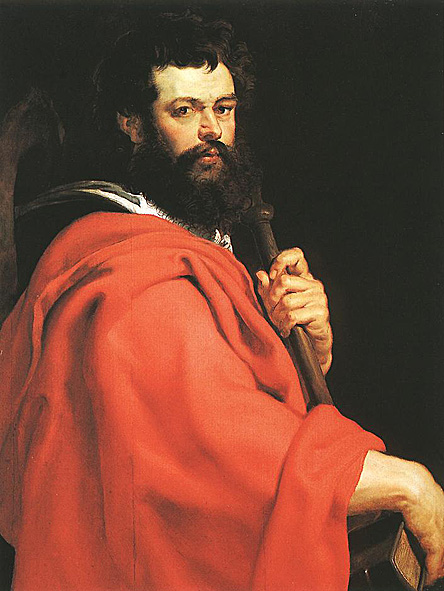
Saint Roch Altarpiece: 1623-26
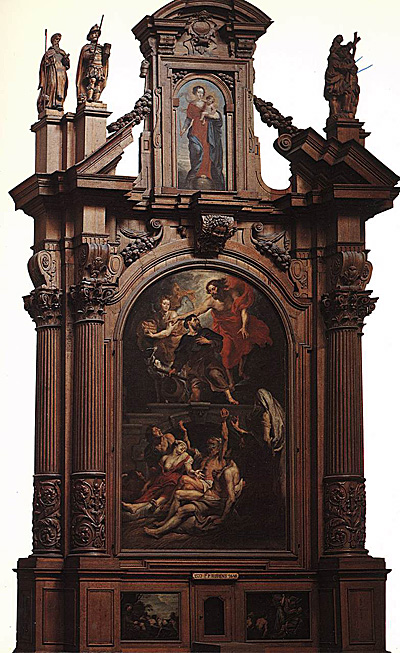
Rubens consecrated this altarpiece to St Roch, protector of the sick. The Saint is represented with his attributes, the pilgrim's staff and the dog.
The Deposition: 1602

Pieter Paul Rubens, the genius of European Baroque, painted his Deposition during his first stay in Rome. Rubens provides us with an extraordinary interpretation of the theme of the incarnation of the divine and human nature of Christ, suspended between death and potential future life. All the shades of the spectrum of light are apparent in the flesh tones, with an opalescence that develops that mother of pearl quality first introduced by Federico Barocci.
The impact made on Rubens by Roman Statuary can be seen in the antique altar with sacrifice scenes, but above all in the strong sculptural high relief of the figures. The dense chromatic texture of the composition owes much Titian's later works, while the airy vibrato and gentle rhythms echo Correggio's achievements. The light unexpectedly bursting through the dark area of the painting provides evidence that Rubens competed in an original way with the chiaroscuro experiments of his contemporary Caravaggio.
The Incredulity of Saint Thomas: 1613-15
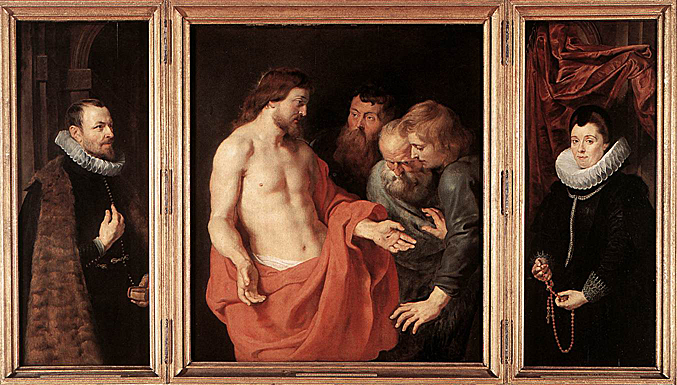
After becoming a master in the Antwerp Guild of Saint Luke in 1598, Rubens left for Italy in 1600, where he spent eight years and visited all the major cities. He spoke Italian, knew Latin, and was familiar with the great writers of Antiquity. His period in Italy allowed him to study Antique works of art and the masterpieces of the Italian Renaissance at first hand. After returning to Antwerp in 1608, he was appointed court painter to Archduke Albert and the Infanta Isabella in 1609. He was given a great many commissions. Between 1613 and 1615, for instance, he painted the triptych The Incredulity of Saint Thomas for Nicolaas Rockox, which was destined for the chapel containing his tomb in the Franciscan church in Antwerp. Rockox, a famous Antwerp patrician and humanist, who was mayor of the city on a number of occasions, is shown in the left-hand panel, with his wife on the right.
The Last Communion of Saint Francis: 1619
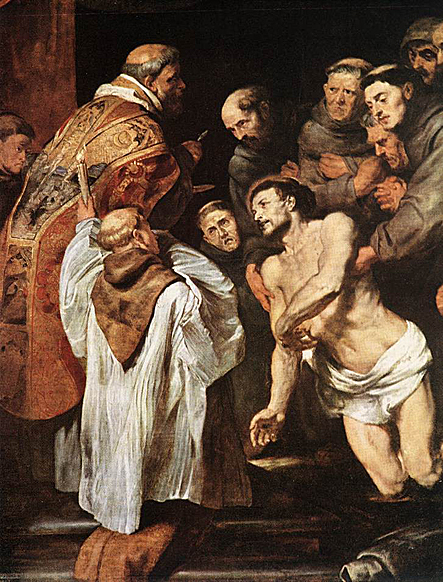
The Martyrdom of Saint Livinus: 1633
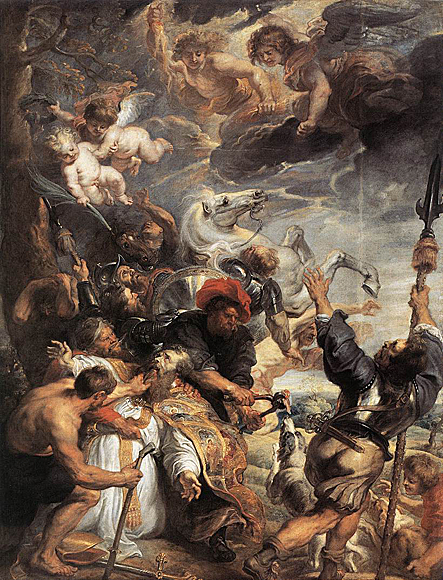
This monumental canvas once decorated the high altar of the Jesuit church in Ghent. When the order was dissolved at the end of the 18th century, Louis XVI bought the painting which, after the French Revolution, ended up in the Brussels museum.
According to the legend, the Scots monk Livinus was not only bishop of Ghent but also a martyr whose tongue was torn out. It is possible that Rubens was commissioned to produce this painting for the millennium of the martyrdom in 1633. In so doing a date previously assumed for Livinus' martyrdom was corrected and the exemplary behaviour of a local saint, the founder of the local community of believers, was given place of honour in the church. All this is typical of the Jesuit's counter-reformation intentions of basing the re-sourcing of the true faith on militant, recognisable and historically grounded foundations. Their founder, Ignatius of Loyola, defended the heroism of the martyrs against the Protestants.
In the prints of Meditations on the Gospel, a book of devotions written by the Jesuit Hieronymus Nadal on Ignatius' instructions, the accent is therefore on the cruelty of their tortures. Rubens' depiction of Livinus' torture follows the same line. The viewer is spared not a single horrible detail, neither the blood-spattered knife in the torturer's mouth who in the left foreground grins at the saint in his bishops' garments with his mitre and staff, nor his companion who has grabbed Livinus' beard, nor his comrade-in-arms holding the saint's torn-out tongue in a pair of tongs above an avidly yapping dog. The strong gestures, the rhythm of the paint strokes, the shimmering lighting and the masterly colour composition carry the sense of movement to a climax. From heaven comes the reward for the martyr and the justified retribution for his executioners' misdeed, in the figures of two putti, who reach Livinus the martyr's palm, and the angels who, with their thunderbolts, cause the soldiery to disperse in fear and their horses to bolt. For this final, central detail, Rubens took his inspiration from the famous Tyrant Slayers group of statues in front of the Quirinale Palace in Rome, thereby playing to the learned Jesuits' love for surprising aesthetic effects and their erudite knowledge of antiquity.
The Road to Calvary: 1634-37
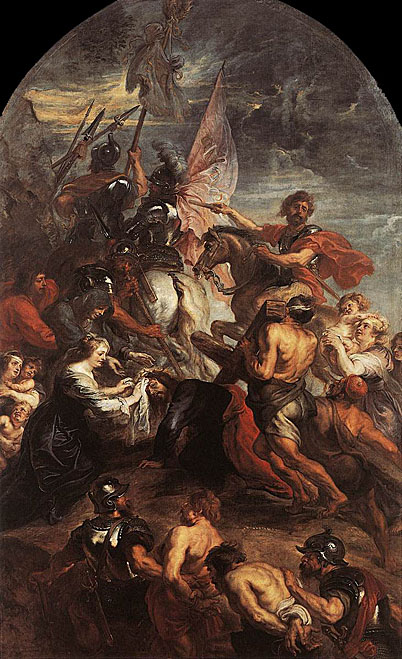
This painting was commissioned in 1634 for the high altar of the Abbey of Affligem, then one of the most important monasteries in the Low Countries. Tensions inside the monastery may explain why this monumental work was not delivered until 1637.
In this production of his mature period, Rubens masterfully combines two artistic traditions. The first of these is that of the large single-frame altarpieces that were to replace the older polyptychs in the Southern Low Countries in the 17th century. With their exceptional scale and their strongly vertical format, they faced artists with the problem of constructing a convincing compositional unity from a series of related themes in a vertical format. As an artist gifted with one of the greatest compositional and narrative talents of his age, Rubens fulfilled his task masterfully. Instead of dividing the painting into an upper and lower register, a solution that he had often applied following Titian, he elects here to represent Christ's ascension to the place of his execution on Calvary in an uninterrupted zigzag movement. The thrust from below to above is achieved both in the colouring, with a balanced rhythm of localised concentrations of colour, and also iconographically, with the successive tableaux of the executioners with the two thieves, the holy women with Mary and Veronica, and ending with the Roman officers on horseback with their flapping pennants.
The centre-point of the composition is Christ's face that St Veronica is wiping. Turned towards the viewer, it forms a direct call to the faithful to follow his life and to think on their own sins that had to be redeemed by Christ's suffering. This procedure descends directly from the tradition of devotional art, with small-scale pictures intended for individual meditation. The genius of Rubens' invention lies precisely in the combination of the two pictorial traditions, breathing new life into the ancient devotional tradition within a contemporary, counter-reformation form of altar decoration, whilst at the same time enriching the broad, sweeping movement of such a monumental high altarpiece with the more intimate emotionality of smaller devotional paintings.
The Supper at Emmaus: 1610
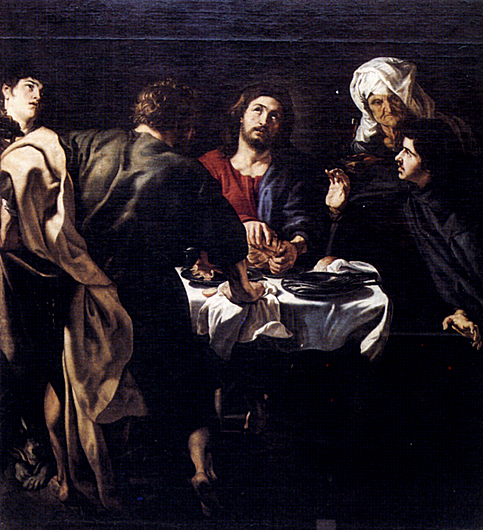
The Three Crosses: ca 1620
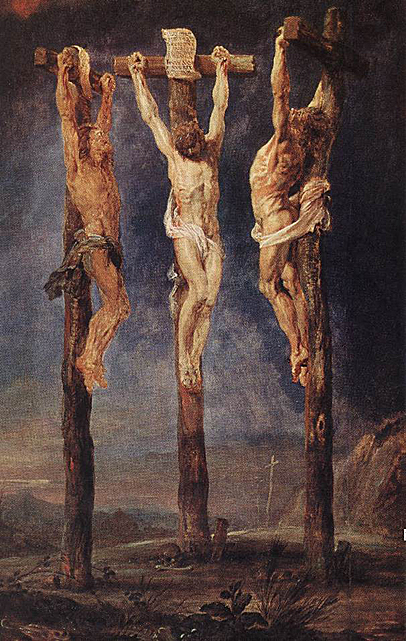
The Trinity Adored by The Duke of Mantua and his Family: ca 1604-06

Virgin and Child: 1620-24
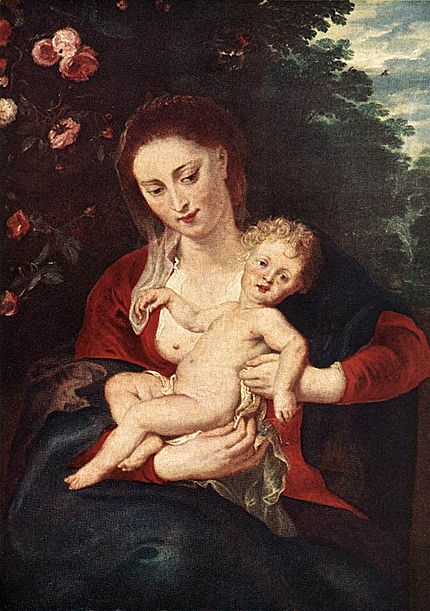
Virgin and Child Adored by Angels: 1608
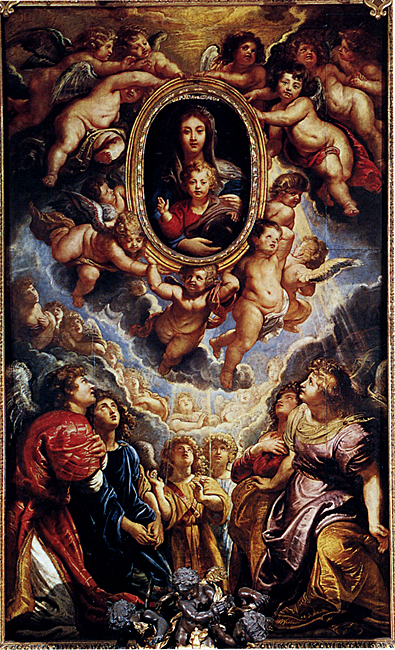
Virgin and Child: ca 1604
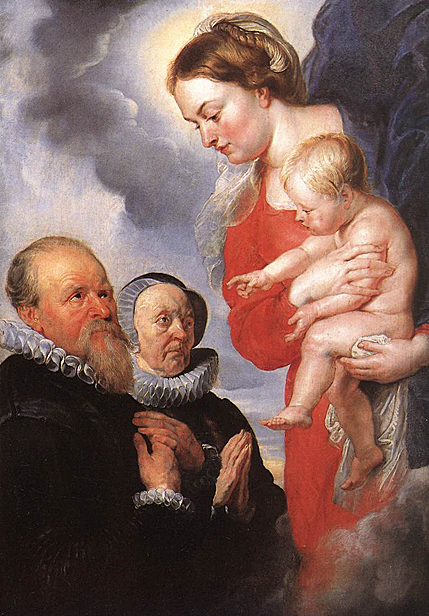
Susanna and the Elders: 1607-08
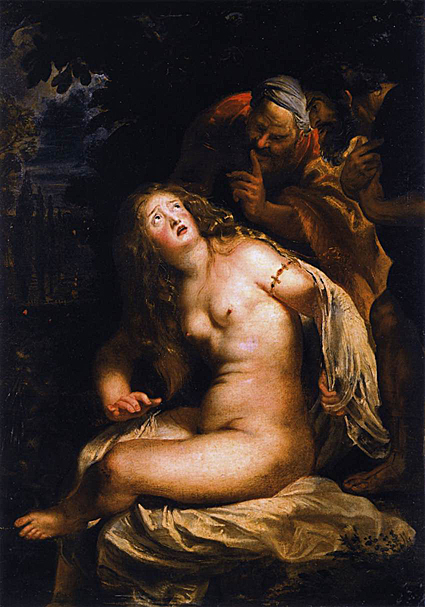
Tereus Confronted with the Head of his Son Itylus: 1636-38
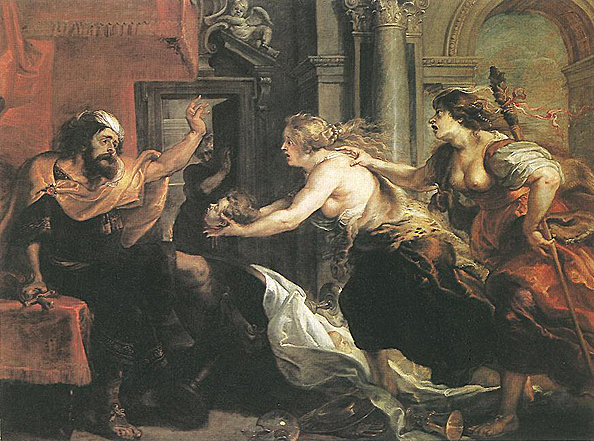
Tereus was a son of Ares, a king of the Thracians, in Daulis, afterwards Phocis. Some traditions place Tereus at Pegae, in Megaris. Pandion, king of Attica, who by his wife Zeuxippe had two daughters, Philomela and Procne, and twin sons, Erechtheus and Butes, called in the assistance of Tereus against some enemy, and gave him his daughter Procne in marriage. Tereus became by her the father of Itys, and then concealed her somewhere in the country, that he might thus be enabled to marry her sister Philomela whom he deceived by saying that Procne was dead. At the same time he deprived Philomela of her tongue. Ovid reverses the story by stating that Tereus told Procne that her sister Philomela was dead. Philomela, however, soon learned the truth, and made it known by a few words which she wove into a peplus. Procne then came to Philomela and killed her own son Itys. Tereus, who had been cautioned by an oracle against such an occurrence, suspected his own brother Dryas and killed him. Procne took further vengeance by placing the flesh of her own child in a dish before Tereus, and then fled with her sister. Tereus pursued them with an axe, and when the sisters were overtaken they prayed to the gods to change them into birds. Procne, accordingly, became a nightingale, Philomela a swallow, and Tereus a hoopop. According to some, Procne became a swallow, Philomela a nightingale, and Tereus a hawk. According to the Megarian tradition, Tereus, being unable to overtake the women, killed himself. The Megarians showed the tomb of Tereus in their own country, and an annual sacrifice was offered to him. Procne and Philomela, moreover, were there believed to have escaped to Attica, and to have wept themselves to death.
The Adoration of the Magi: 1624
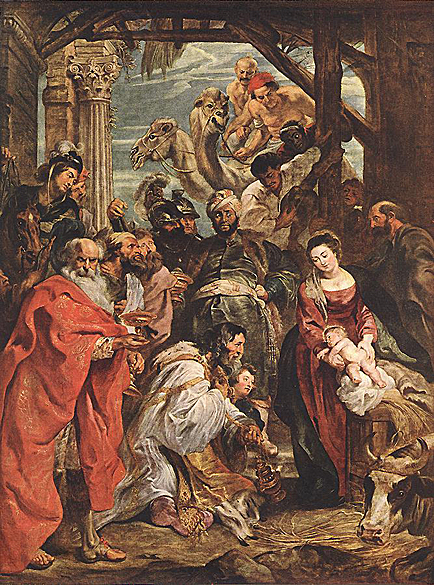
The detail shows the Magi offering the Christ Child the gift of gold coins in Rubens’s great painting of The Adoration of the Magi. The detail reveals the artist’s daring technique: in addition to using a brush heavily charged with pigment to depict the highlights around the eye and in the hair, he also used the other end of the brush to make marks in the still wet paint in order to reinforce the curls in the hair and give them more movement. Rubens painted this work in 1609. In 1628 he returned to it, enlarging it with three wide strips of canvas and adding various figures including his own self-portrait.
The Crucified Christ: 1610-11
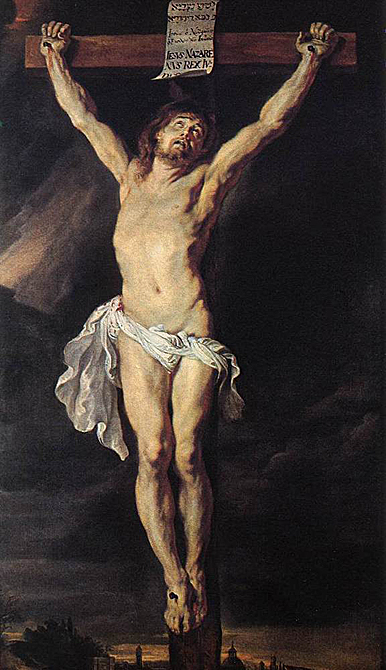
The Education of the Virgin: 1625-26
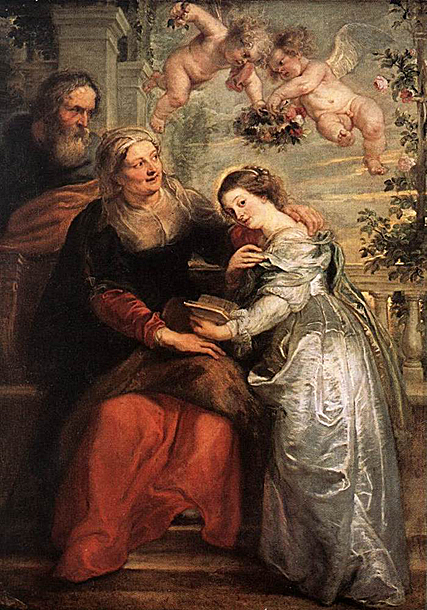
The Golden Legend, drawing on the apocryphal gospels, tells how the Virgin Mary was brought up as a child in the Temple at Jerusalem 'with other virgins'...and was visited daily of angels', since it had been foretold to her parents, Joachim and Anne, that their daughter was to be consecrated to the Lord as the 'chosen vessel' of Christ's Incarnation. The theme became popular in the 16th century and remained so after the Counter-Reformation in spite of some disapproval by the Church because of its apocryphal character. Mary is seen in earlier examples teaching her young companions, sewing the priest vestments or being ministered to by angels who bring bread and water. But the favourite theme, especially in Counter-Reformation art, depicts her education in the strict sense, at the knee of her mother Anne, learning to read.
The Entombment: 1611-12
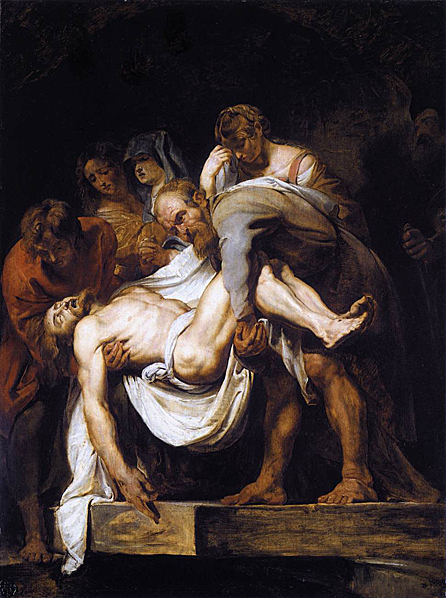
In 1611, Rubens returned to copying, his original this time the artist who had most impressed him after Titian: his version of the latter's Entombment after Caravaggio is now in the Canadian National Gallery.
The Flagellation of Christ
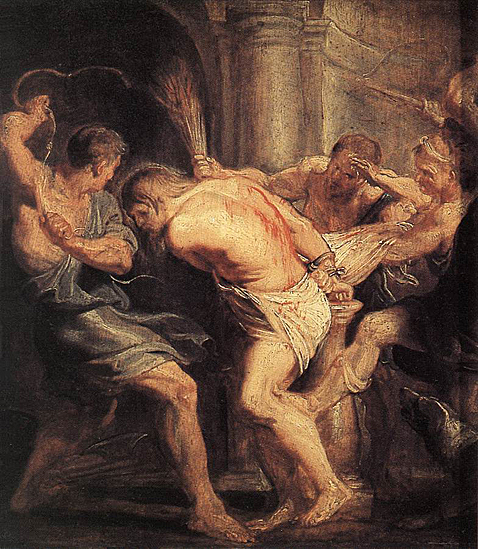
The essence of Rubens's exuberant style can be found in the oil sketches he made when preparing his monumental paintings. In the Flagellation of Christ - a sketch for the painting in Antwerp's Church of St Paul - he explores the contrast between the physical violence of the torturers and Christ's bent body. The figures fill virtually the entire space and stand out for their sculptural power.
The Holy Family with Saint Anne: ca 1628

Although Rubens run a large workshop, he was perfectly honest about his proceedings. Studio works were rigorously distinguished from those to which he had, to a greater or lesser extent, contributed. Philip IV of Spain wanted works by Rubens, and he wanted them in quantity; Rubens himself supplied them, and no assistants were permitted to help him. The Holy Family with St. Anne shows how tender the master's own hand could be in representing the warmth of family life.
The Holy Family with the Basket: ca 1616
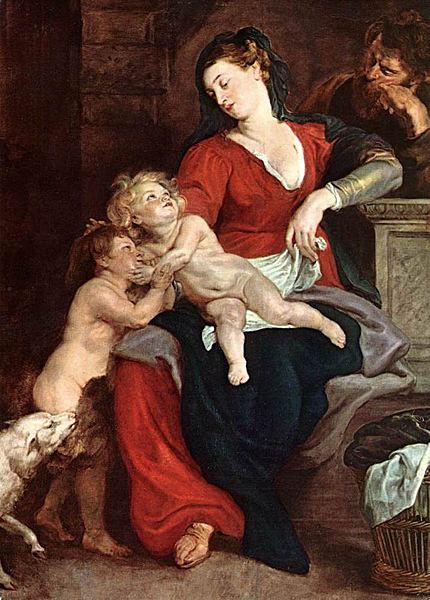
The Martyrdom of Saint Stephen

This painting, the centre panel of a triptych, was commissioned by the rich Benedictine Abbey Saint-Amand, near Valenciennes. In open state the triptych shows the martyrdom of St Stephen (centre) and scenes from the saint's life. When the wings are closed an Annunciation can be seen on the reverse of the side wings.
The Meeting of Abraham and Melchizedek: 1625

Isabella of Spain commissioned Rubens to design twenty tapestries for the Convent of the Poor Clares in Madrid. The subject of the tapestry series, woven in Brussels and still in the Spanish convent, was The Triumph of the Eucharist. This painting is an oil sketch for one of the tapestries.
The Resurrection of Christ: 1611-12
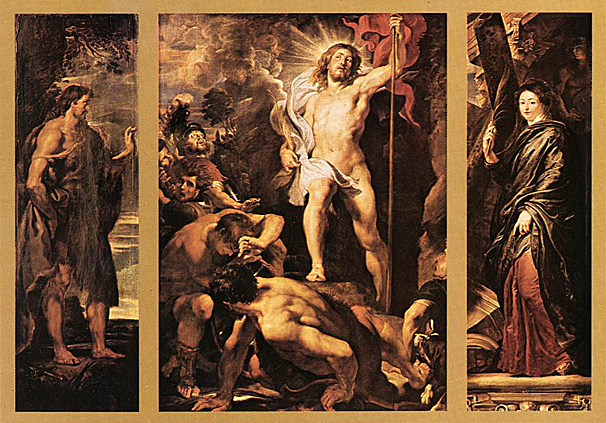
Rubens painted this triptych, called Moretus triptych, in 1611-12, shortly after completing the Raising of the Cross, and at more or less the same time as the centre panel of the Descent from the Cross. Martina Plantin, widow of the printer Jan Moretus of the Plantin Press, placed the commission.
Christ strides powerfully from his open, rocky tomb rather than the customary sarcophagus. The supernatural radiance of his body contrasts with the darkness that shrouds the astounded soldiers. The panel on the left shows John the baptist, Jan Moretus' patron saint, in his camel-hair tunic by the River Jordan. The sword at his feet is an allusion to his beheading. St Martina, patron saint of Moretus' widow, holds the palm branch that symbolises the martyr. According to her legend, the temple of Apollo collapsed when she made the sign of the cross - an incident recalled by the setting behind.
The Resurrection of Christ: ca 1612
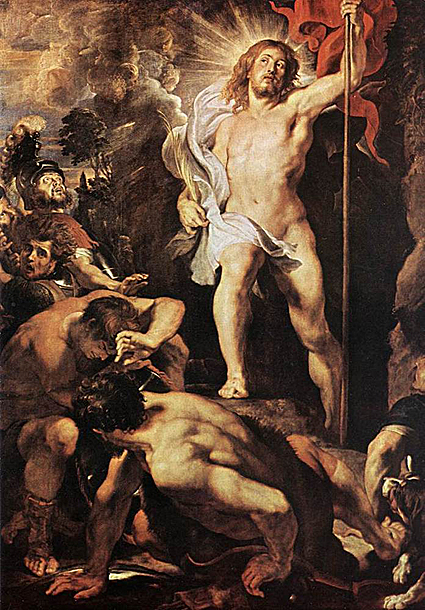
The Virgin and Child in a Garland of Flower: 1621
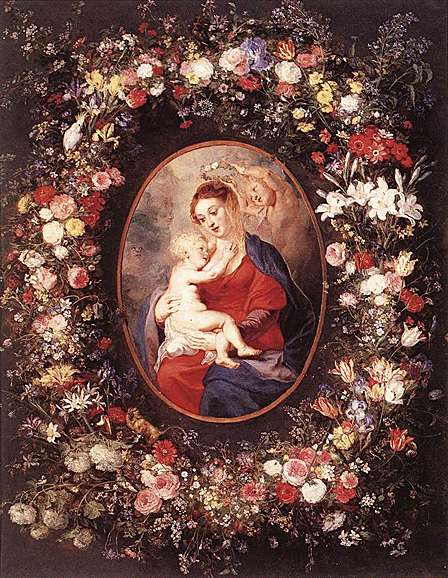
MYTHOLOGICAL SUBJECTS
Bacchus: 1638-40

Created in the last years of Rubens' life, this painting amazes the viewer with its virtuosity of style and unusual interpretation of the image of the god of wine and merriment. Bacchus is depicted as a grossly obese man, surrounded by a satyr, a maenad and putti. The rich palette, in which all the colours blend into one golden stream, and the natural, sketchy technique, enabled the artist to create a genuine sense of debauchery, or bacchanalia. This is a paean to human flesh. According to Rubens' nephew, Philip, this was not a commissioned work, and the artist kept it in his studio till the end of his life.
Diana and her Nymphs Surprised by the Fauns: 1638-40
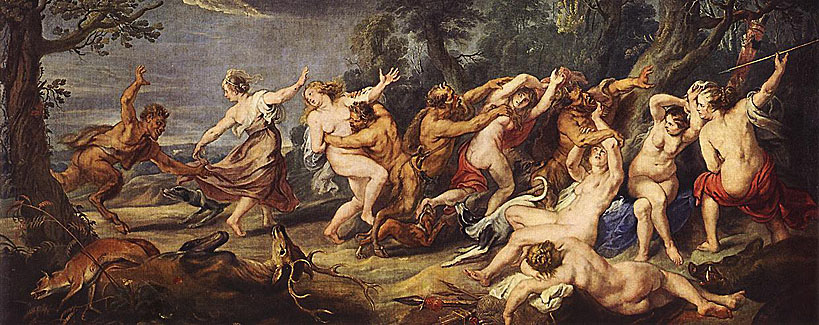
"Diana and her Nymphs Surprised by the Fauns" was painted by Peter Paul Rubens in Oil on canvas during the Baroque epoch in 1636-1640. Original painting size was 123.6" x 50.4" (314.0cm x 128.0cm). The style of the painting is Flemish Baroque and the theme represented is Mythological Motif, Nudes. The painting is currently displayed at Prado, Madrid.
Rubens was a Flemish painter and diplomat.
After apprenticeships in Antwerp, he was admitted to its painters' guild in 1598. He went to Italy in 1600 and until 1608 worked for the duke of Mantua, who in 1603 sent him to Spain to present paintings and other gifts to Philip III, the first of many diplomatic missions he would perform for various courts over three decades.
Diana Returning from Hunt: ca 1615
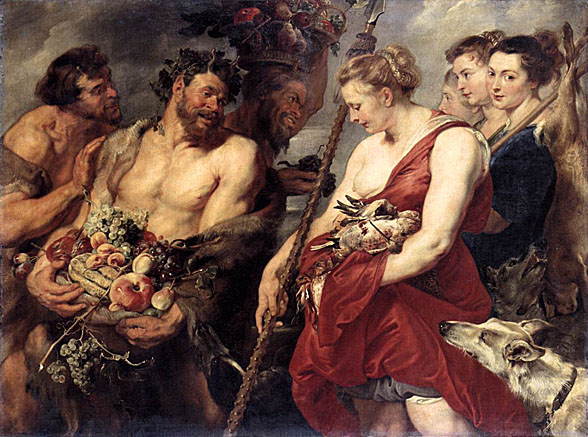
Rubens returned to Antwerp in 1608 from Italy, and he brought with him an interest in the heritage of Antique art and literature that developed into a cornerstone of his thinking and artistic production. After setting up home in Antwerp, he devoted himself with unfailing interest to Greek and Roman mythology, which he used for the subject of many works, mostly as private commissions.
The goddess of Diana was evidently of great importance to Rubens in around 1615, for she could be combined with another subject that interested him: the hunt. Moreover, this subject was well received by his royal and aristocratic patrons: game hunting was the exclusive preserve of the ruling class. Rubens produced a number of large format hunting scenes in 1614-15, many with mythological backdrop.
Rather than emphasizing extremes of movement, as is typical of many of Rubens's hunting pictures, the Diana Returning from Hunt focuses instead on characterizing the powerful, beautiful and pensive huntress. Diana, simultaneously the goddess of chastity, stands with her companions before a group of satyrs, who belong to a quite different branch of Rubens's work: Bacchanalia. Diana's hunting spear divides the different worlds of the two groups And no less different than their appearance and natures are the spoils held by the satyrs on the one side, and Diana and her companions on the other. The fruit presented in richly laden baskets and the intoxicating wine, combined with the lecherous gazes of these half-naked figures, must be seen as an unambiguous sexual overture. Diana, guardian of female chastity, resists. The birds and the dead hare that she and her nymphs have bagged during the hunt reveal them as the conquerors of the pleasurable indulgence embodied by the friends of Bacchus.
The animals and the fruits were painted by Frans Snyders.
Drunken Silenus: 1618

Silenus, in Greek mythology, is part bestial and part human creature of the forests and mountains. Part of Dionysus' entourage, the sileni are usually represented as aged satyrs-drunken, jolly, bald, fat, bearded, and possessing horse ears. According to some myths they were prophets; but according to others they were so perpetually stupefied with drink that they were unable to distinguish truth from falsehood. In some legends only one such creature appears, Silenus, described as the oldest of the satyrs, the son of Hermes or Pan. He was the companion, adviser, or tutor of Dionysus.
Jupiter and Callisto: 1613
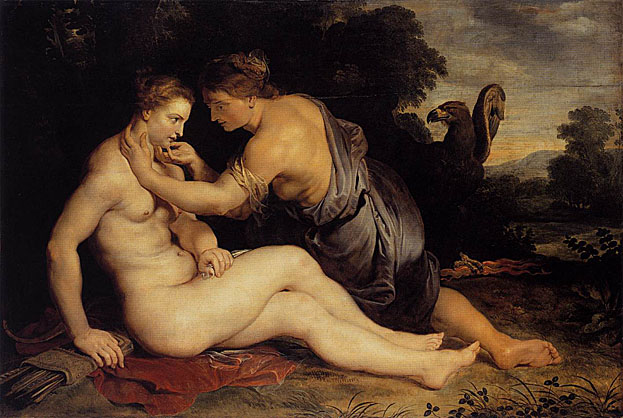
KALLISTO (or Callisto) was a daughter of the Arkadian King Lykaon and a hunting companion of the goddess Artemis. There were several contradictory versions of her story, but ancient writers all agreed on a number of facts:--that she was seduced by the god Zeus, transformed into a bear, bore a son named Arkas, was hunted down as a beast and placed amongst the stars as the constellation Ursa Major.
In the first version of the story Kallisto swore to preserve her virginity for as long as she remained in the company of the goddess. But after she was seduced by the god Zeus, she kept the fact hidden. Her condition was eventually revealed during the bath and Artemis, in her fury, transformed Kallisto into a bear. Hunters then caught and delivered her and her son Arkas to King Lykaon. Later, when the boy was grown, Kallisto inadvertently wandered into the sanctuary of Zeus Lykaios and Arkas, not knowing the bear's identity, would have killed her for the sacrilege had not Zeus immediately transferred the pair to the stars.
In a comedic version of the previous story, Zeus seduced Kallisto in the guise of the goddess Artemis. When her pregnancy was revealed in the bath, Kallisto blamed the goddess of the offence. She was naturally incensed by such an accusation and turned the girl into a bear.
In yet a third version, when Kallisto was seduced by the god Zeus, his jealous wife Hera angrily transformed her into a bear and persuaded the goddess Artemis to shoot her. Zeus sent Hermes to recover the child Arkas from her womb and delivered him into the care of the goddess Maia. Kallisto was again placed amongst the stars.
In a slight variation of the last, Zeus turned Kallisto into a bear when Hera came across them as they were consorting. The goddess was not fooled by the switch and persuaded Artemis to shoot her.
In the chronology of myth Kallisto lived in the time before the Great Deluge which, some say, was brought on by her father King Lykaon who had served Zeus a meal of human flesh. After the catastrophe, Arkas claimed his throne and ruled a new generation of Pelasgian tribesmen born of the oaks. His descendants ruled the kingdom right down to the time of the Trojan War.
Mercury and Argus: 1635-38
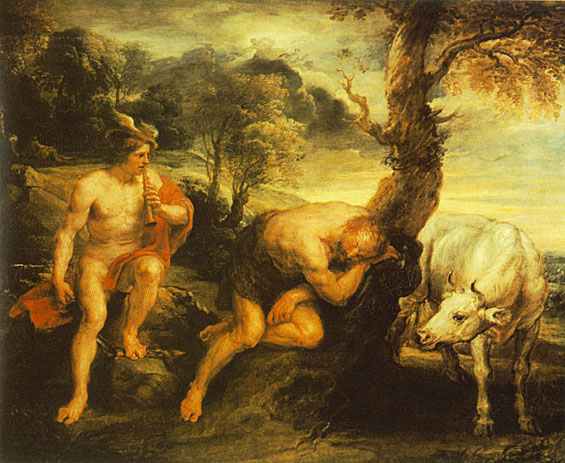
Io was a river goddess. Jupiter fell in love with the beautiful maiden, and one day, as she rested on the banks of the River, he changed his shape into that of a cloud, and embraced her. He whispered words of love to her, and then planted an immortal kiss upon her upturned cheek.
Now Jupiter's wife, the goddess Juno, was suspicious when she saw the cloud enveloping the Earth, for she noticed at the same time that her husband Jupiter was absent from Mt. Olympus. So Juno mounted her peacock drawn carriage and came to investigate. Jupiter quickly changed Io into a cow, hoping to conceal his romance with Io from his jealous wife. When Juno came upon the spot where Jupiter had only moments before been embracing Io, she saw only him and a beautiful cow. She immediately realized what had occurred, and said with sweet cunning, "Oh what a beautiful cow. Will you, mighty lord and master of all gods and men, give it to me as a gift." Jupiter was trapped. He could not deny Juno so simple a gift as a cow, yet he did not want to give away his girl friend Io. But in the end, Jupiter gave Juno the cow.
Juno immediately placed the cow under the watchful eyes of her trusted servant Argus. Now Argus had a hundred eyes, and only a few were ever closed at any one time. Thus Argus was able to watch over the cow Io constantly, without ever sleeping, for some eyes were always open. Jupiter was very sad, not only because Io was a cow, but because he could not visit with her without arousing jealousy in Juno. Finally, Jupiter sent his son Mercury to the site, with instructions that Mercury should sing and tell stories, and thereby lull Argus to sleep. So Mercury set out to fulfill his father's command, armed only with his syrinx, or musical pipes, and a head full of stories. Soon enough he found Argus sitting along the banks of the River Inachus, maintaining constant watch over Io, the heifer. After hearing him play on his pipes, Argus invited Mercury to sit awhile, and entertain him.
Mercury sat and played on the pipes, known as a syrinx, and told many stories. Finally he related the story of how the instrument he played upon was created. "Once upon a time, there was a beautiful water-goddess named Syrinx. She avoided young men and only kept company with the moon goddess Diana. Every day she attended to the needs of Diana, and followed her on the hunt. One day the god Pan met Syrinx in the woods, and fell in love with her. He told her how much he loved her, but Syrinx ran away if fear. Pan ran after her, for he wanted to hug her and kiss her. He overtook her on the bank of the river, and reached out to embrace her. She cried out for help from her companion water-goddess, and they responded by turning her into a clump of reeds at the moment of that Pan was about to kiss her. Pan sighed with disappointment when he saw that his beloved Syrinx had turned into a clump of reeds. Pan noticed that the air from his sigh passed through the clump of reeds, and made a beautiful sound. Pan then fashioned the reeds into a musical instrument which he named Syrinx, in honor of the young girl he had loved in vain." At this moment Mercury noted that Argus had fallen fast asleep.
When Mercury saw that Argus had fallen asleep, he reached for his sword, cut off the monster's head, and set Io free, although Io was still in the shape of a heifer. Juno took the eyes from the head of the slain Argus and placed them on the tail of her favorite bird, the peacock, where they remain to this day. And then Juno released a stinging fly to torment Io.
The legacy of the myth of Jupiter and Io includes names of seas, geographical passes, whole races of peoples, a moon of Jupiter, and a major feature on that moon.
Following the release of the stinging fly by Juno, Io swam across a body of water west of Greece, that was afterwards named the Ionian Sea to honor Io's passage. Io then passed over the narrow entrance to the Black Sea. The narrow entrance to the Black Sea is named the Bosporus, meaning "the fording of the ox," in honor of her passage. In the Caucusus she visited with the god Prometheus, who was also being unjustly punished, his crime being the theft of fire from heaven for the benefit of mankind. Finally, after Jupiter promised to no longer pursue Io, Juno released Io from her shape of a cow, and Io eventually settled in Egypt, becoming, according to legend, the first Queen of Egypt.
Nature Adorning the Three Graces: ca 1615

The flowers and fruit are by Jan Breughel the Elder, the great specialist in these subjects.
Nymphs and Satyrs: 1637-40
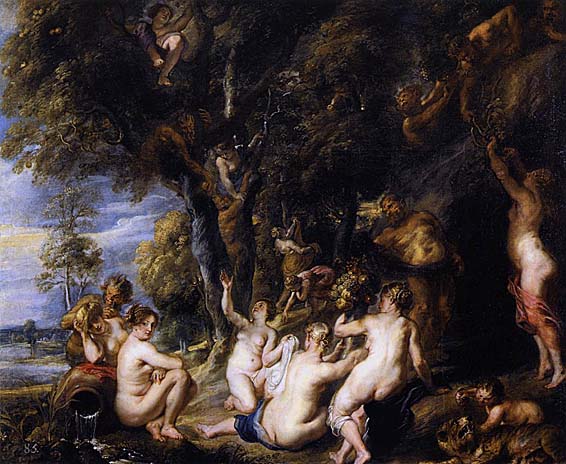
Pan and Syrinx: 1617-19
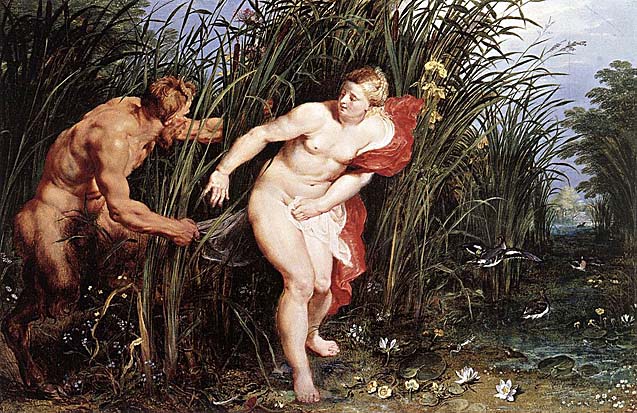
The painting represents a scene from Ovid's Metamorphoses. The lustful shepherd-god Pan pursued the shy, virginal nymph Syrinx, who ran to a river to escape him, calling on her 'sisters of the stream' to turn her into a reed. Just as Pan attempted to seize the nymph, she was transformed and he was left holding not a beautiful maiden but a bunch of reeds. From these he made his pipes, ever since called the syrinx, whose lovely tones reminded him of his lost love.
Rubens, for whom Pan and the nymphs symbolize positive forces of nature, has based his Syrinx - modestly covering her loins with one hand and seemingly fending off the fast-closing Pan with the other - on the ancient Medici Venus, famous since the 16th century. Jan Brueghel the Elder, renowned for his life-like depiction of plants and animals, nestles the scene in a lively and luxuriant landscape.
Perseus and Andromeda: 1620-21
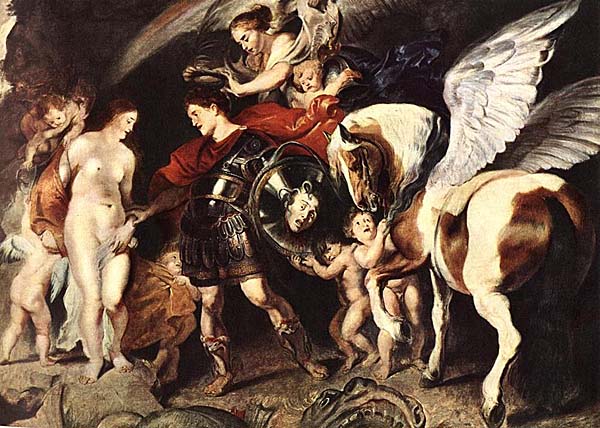
Ovid (Met. 4:665-739) tells how Andromeda, daughter of an Ethiopian king, was chained to a rock by the sea-shore as a sacrifice to a sea-monster. Perseus, the son of Zeus and Danae, flying overhead, fell in love at first sight. He swooped down just in time, slew the monster and released Andromeda. He is shown, sword and shield in hand, hovering in the air near the girl. The monster approaches through the waves. The anguished parents and other onlookers stand on the shore.
Rape of the Daughters of Leucippus: ca 1617
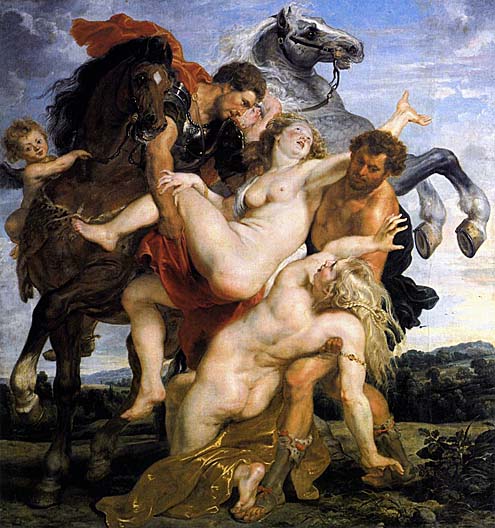
Ovid (Met. 4:665-739) tells how Andromeda, daughter of an Ethiopian king, was chained to a rock by the sea-shore as a sacrifice to a sea-monster. Perseus, the son of Zeus and Danae, flying overhead, fell in love at first sight. He swooped down just in time, slew the monster and released Andromeda. He is shown, sword and shield in hand, hovering in the air near the girl. The monster approaches through the waves. The anguished parents and other onlookers stand on the shore.
The lyricism, eloquence and sensuality that characterize his entire oeuvre are already apparent in Rubens' mythological compositions of 1600-1620. These are often vigorous, earthy works, such as the Rape of the Daughters of Leucippus.
The two daughters of King Leucippus were betrothed to a set of twins, cousins of Castor and Pollux. But the latter pair carried the maidens off and had sons by them. Armed warriors are seen in the act of seizing the naked maidens and bearing them away on horseback
.
The composition of this painting opens upward like the flowering of a bouquet. The two divergent diagonals rise from the base of the painting, where the feet of captive and aggressor are placed side by side. The volumes ascend from this point, harmoniously residing on successive points of equilibrium, while the luminous white forms of the nude victims contrast with the tanned, caparisoned bodies of their hirsute rapists. Here Rubens' classicizing and Baroque tendencies are completely reconciled.
Aeneas and his Family Departing from Troy: 1602-03

The Legend of Aeneas and the Foundation of Rome
Medusa: ca 1617

The Head of Medusa was painted by Rubens with sections by Frans Snyders. Hypotheses vary concerning the date, but between 1610 and 1617 seems to be the spread.
In Greek mythology, Medusa was one of the monsters known as Gorgons. She often was represented as a winged female creature with hair consisting of snakes. Because she was mortal, Perseus was able to kill her by cutting off her head. The story is told in the epic, Argonautica. From her spurting blood, sprang Chrysaor and Pegasus, the flying horse, her two sons by Poseidon, the sea god.
The severed head, which had the power of turning into stone all who looked upon it, was taken by Athena, who placed it in her shield.
In Ovid's version, Medusa, whose long hair was quite beautiful, was raped by Neptune in the Temple of Minerva. Minerva, Roman Goddess of Wisdom, turned Medusa's hair into writhing, living snakes, her face into one that, gazed upon, would turn people into stone. One interpretation of Medusa's head, therefore, is as a symbol of lust and lawlessness, even though she had been raped by Neptune in a holy temple.
Rubens very likely knew Caravaggio's painting of the Medusa. The symbolism of the head is complex. In Renaissance literature, the decapitated head represented the triumph of the intellect over evil and impiety. Possibly an implication was that triumphs of the mind, including art, could render the onlooker astonished.
Hero and Leander: ca 1605
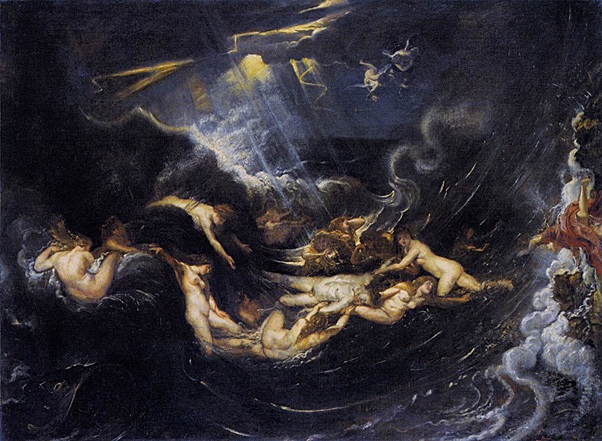
The subject of the painting is a legend according to which Leander, a youth of Abydos, a town on the Asian shore of the Hellespont, used to swim across the waters at night to Sestos on the opposite side to meet his lover Hero, a priestess of Aphrodite. She would guide him by holding up a lighted torch. One stormy night Leander was drowned. Hero in despair threw herself into the sea. The story is related in this form by the Greek poet Musaeus (4th-5th century A.D.). Ovid (Heroides, 18, 19) tells of the lovers, omitting their death. The theme is found in Italian and Netherlandish painting, especially of the 17th century which depicts Leander swimming the Hellespont towards a distant tower lighted by Hero; or the drowned Leander is borne away by Nereids as Hero plunges to her death into the sea.
Leda and the Swan: ca 1598-1600
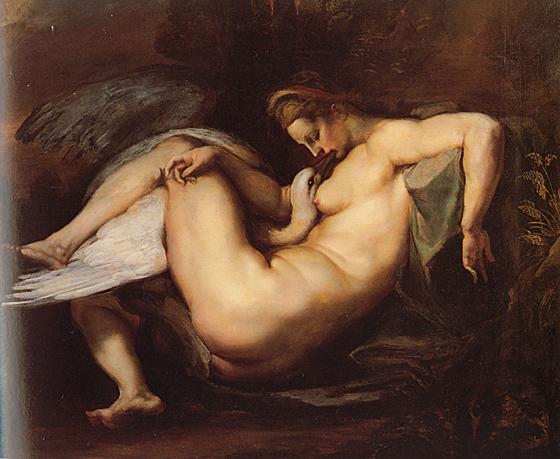
Whatever your stance on Yeats' poetry, you would not deny that the man has written a poem the charms of
which no devotee of art can possibly resist:
the unparalleled 'Leda and the Swan' which sounds as follows:
LEDA AND THE SWAN
A sudden blow: the great wings beating still
Above the staggering girl, her thighs caressed
By the dark webs, her nape caught in his bill,
He holds her helpless breast upon his breast.
How can those terrified vague fingers push
The feathered glory from her loosening thighs?
And how can body, laid in that white rush,
But feel the strange heart beating where it lies?
A shudder in the loins engenders there
The broken wall, the burning roof and tower
And Agamemnon dead.
Being so caught up,
So mastered by the brute blood of the air
Did she put on his knowledge with his power
Before the indifferent beak could let her drop?
Mars and Rhea Silvia: ca 1620
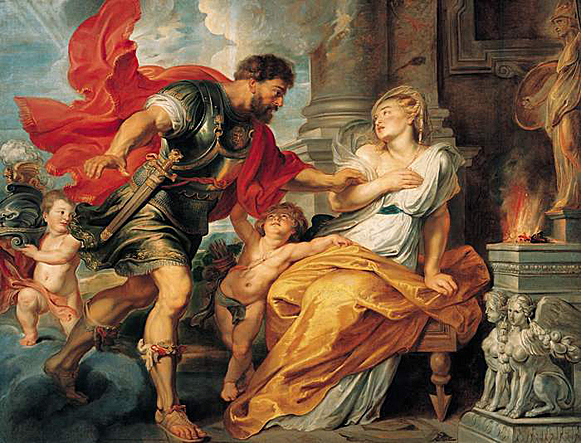
For Peter Paul Rubens' Mars and Rhea Silvia, the Princely Collections not only own the completed work but also the elaborate oil sketches. According to ancient myth, Mars was attracted to Rhea Silvia, a priestess of Vesta, the goddess of the hearth, who was also worshipped as the protectress of the family, of hospitality and of ordered community life. Ovid reports that Mars overpowered the Vestal while she was asleep. Rubens shifted the scene to the temple. The god has been borne there on a cloud and passionately approaches the priestess, who cringes in horror: as a Vestal, she has sworn an oath of chastity, though possibly not of her own free will. Mars has removed his helmet, and with it his war-like aspirations, for the time being. Cupid, the god of love, acts as pimp, and leads Mars to Rhea. Virgil records that Mars had twins by Rhea Silvia, Romulus and Remus, who later founded Rome. You see Vesta's eternal fire, tended by the priestess, burns on the altar on the right. As no images with human faces were made of this goddess, her shrine is marked by a statue of Pallas Athena instead. Rubens demonstrated once more at this point that he was familiar with ancient sources and their contemporary interpretation, as by his friend Justus Lipsius in De Vesta et Vestalibus Syntagma (Antwerp, 1605). Rubens borrowed small details from Roman coins and ancient sarcophagi like the one in the Palazzo Mattei in Rome. The fact that the attributes of Mars and Athena are reversed shows that the painting was used as the basis for a tapestry. It is possible that it was intended as the first of a series on Romulus, but by 1625 at the latest, when the scene was taken up for the first time as part of a tapestry for the cycle on the Roman consul Decius Mus, Rubens had clearly abandoned his ideas for an independent series.
The Union of Earth and Water: ca 1618

In the 16-17th centuries the four elements (Earth, Air, Fire and Water) are usually represented as classical gods and goddess with their attributes. Earth, as a woman has the attributes that belong to the goddesses of fertility (e.g. the cornucopia of Ceres). Water is personified by a river good with his overturned urn.
Venus, Cupid, Baccchus and Ceres: 1612-13
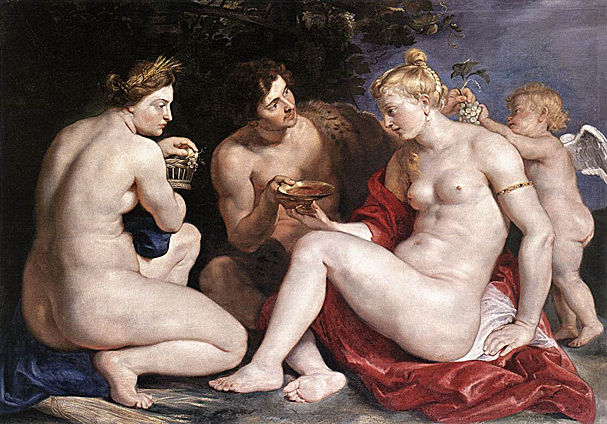
Venus and her son Cupid are being offered food and wine by Ceres, goddess of the fruits of the field, and Bacchus, god of wine. The subject comes from a line by the Roman comic poet Terence (d. 159 BC) which frequently figures in the emblem literature that developed from the mid-16th century: 'Sine Cerere et Libero friget Venus' - without Ceres and Bacchus, Venus would freeze. Love is impossible without food and drink. Rather than depicting a boisterous feast, Rubens has opted for a rather restrained scene that must be read as a plea for moderation in pleasure.
Rubens produced this painting a few years after his eight-year stay in Italy, where he was employed at the court of Duke Vincenzo Gonzaga of Mantua, and also in Rome. The knowledge of antiquity he gained then was put to use in this painting, as also in a later work on the same theme in 1614, (Royal Fine Arts Museum, Antwerp), Ceres' pose being taken from the Crouching Venus of the Hellenistic sculptor Doidalsas, dating from around 240-230 BC. Rubens certainly knew the marble copy in the Farnese collection in Rome (today in the National Archaeological Museum, Naples).
What he particularly appreciated in Hellenistic and Roman sculpture was its formal dynamism, although he saw in ancient sculpture generally a realm of flawless, ideal nature. In painting from such antique models, he says in his De Imitatione Statuarum, a treatise 'on the imitation of sculpture', the statuary has to be humanized, translated into flesh and blood.
Venus Frigida: ca 1614
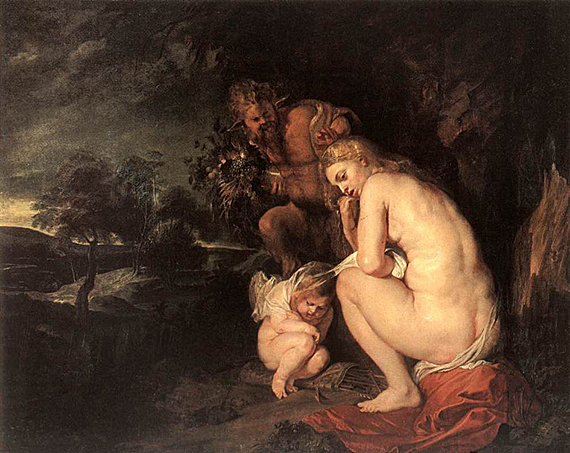
The lyricism, eloquence and sensuality that characterize his entire oeuvre are already apparent in Rubens' mythological compositions of 1600-1620. These are often vigorous, earthy works, such as the Venus Frigida. This painting depicts the proverb 'Hunger and thirst cool love's ardor' (Sine cerero et libero friget Venus).
PORTRAITS AND SELF PORTRAITS
Albert and Nicolaas Rubens: 1626-27
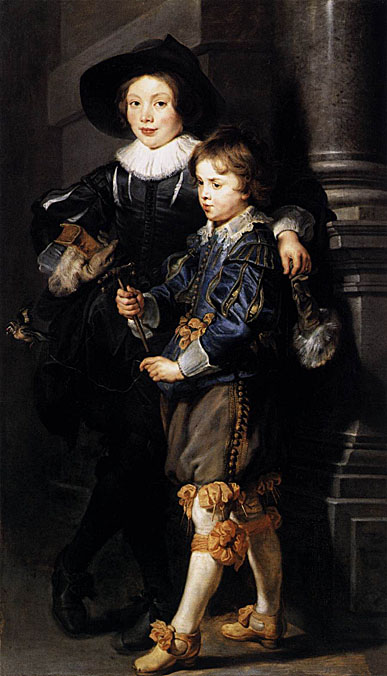
The lyricism, eloquence and sensuality that characterize his entire oeuvre are already apparent in Rubens' mythological compositions of 1600-1620. These are often vigorous, earthy works, such as the Venus Frigida. This painting depicts the proverb 'Hunger and thirst cool love's ardor' (Sine cerero et libero friget Venus).
The portraits of Rubens' children - of Clara Serena, Albert and Nicolaas - are entirely personal. In the full-length portrait of Albert and Nicolaas, Rubens's two sons by his first marriage, the, most prominent feature is the informal way in which the boys seem to pose, which also bears witness to the painter's great empathy with the children's nature: Nicolaas, the playful child, completely relaxed, and his serious elder brother Albert, a studious bookworm, posing rather self-consciously as a scholar.
Deborah Kip and her Children: 1629-30
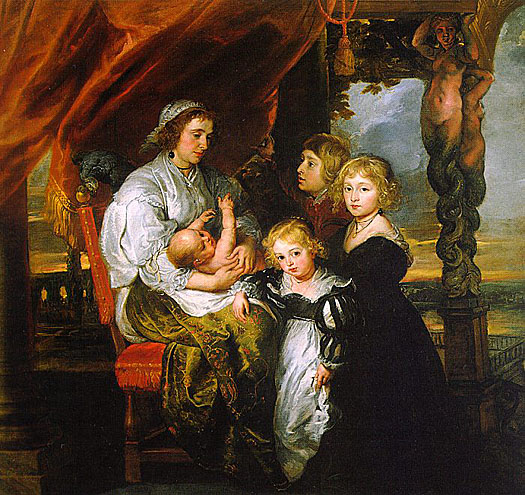
While arranging a truce among the English, French, and Spanish in 1629, Rubens spent several months in London as the houseguest of Balthasar Gerbier, a Flemish-born art dealer and diplomatic courier. Gerbier's Dutch-born wife, Deborah Kip, appears here with four of their nine children. Elizabeth, the eldest, confronts the viewer with dignity; George holds back a curtain; and little Susan stares wide-eyed. (Susan so enchanted Rubens that he reused her figure to personify innocence in an allegorical picture.) The baby cannot be identified because the birth dates of the six youngest Gerbiers are not known.
Embracing the squirming baby, Deborah Kip's interlocked fingers lie near the center of the composition. Her encompassing arm aligns with an oval configuration that includes all the faces. Thus, a flowing motion links the family.
Seams in the canvas show that the original design consisted merely of the heads and torsos. When completing the work, probably after his return to Antwerp, Rubens altered some details and sewed extra strips of canvas to all four sides. These additions allowed space for full-length figures, the exotic and expensive parrot, and the garden arbor with its mermaid columns.
Giancarlo Doria ca 1606
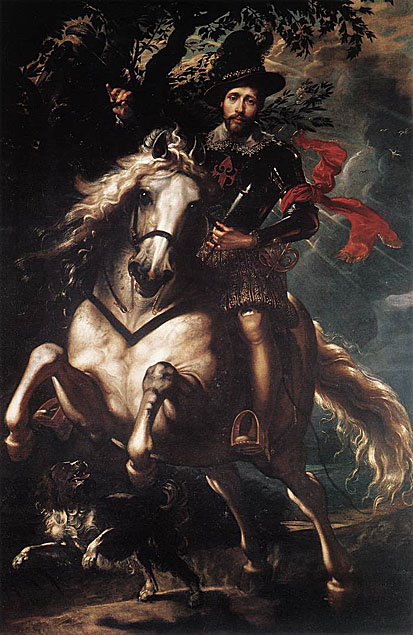
Explicitly Venetian are the two large equestrian portraits Rubens made in his Italian period. The Mannerist emotiveness of the Duke of Lerma and of Giancarlo Doria with their typical foreshortenings and flickering light is unthinkable without Tintoretto, from whom the composition is also derived. Yet unlike him, Rubens gives a strong impression physical presence and vitality to his aristocratic sitters.
Garden of Love
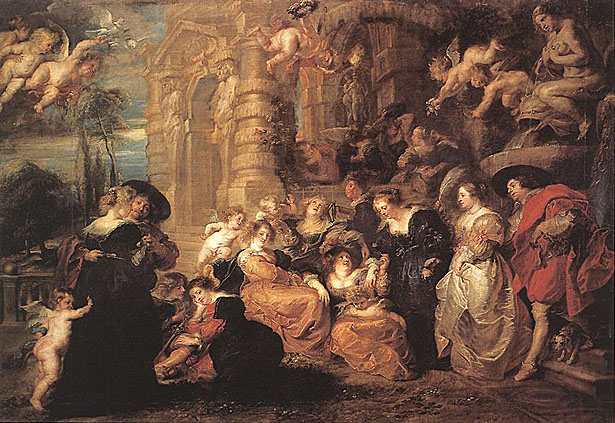
The splendid vision of sensual dalliance once hung in Philip IV's bedchamber. The subject is a traditional medieval one, in which lovers were shown conventionally in a garden, sometimes with moral messages or symbols accompanying them. In the Italian Renaissance the theme had been represented in 'fete champêtres' such as the one attributed to Giorgione or Titian in the Louvre. This picture by Rubens is an important link in the tradition running from those works to the scenes of Watteau and Pater in the eighteenth century.
In the Garden of Love Rubens celebrated his marriage to Helena Fourment, his second wife. Helena, the woman deemed "the most beautiful in Antwerp', is seen in the painting.
Garden of Love: ca 1633

Helena Fourment: 1630-32
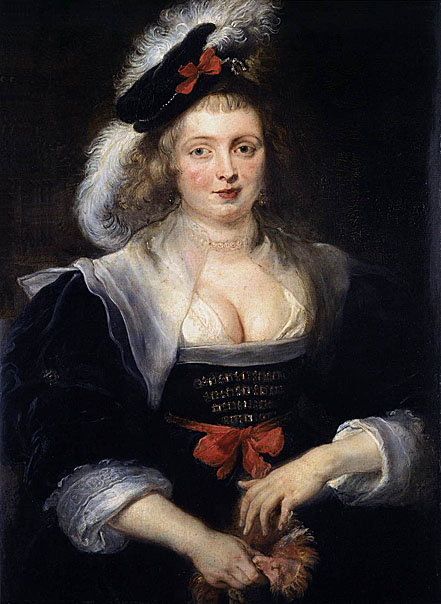
In 1630 Rubens returned to Antwerp from his diplomatic mission in England. His two sons were now twelve and sixteen, and he himself was over fifty. Yet the young woman he was now to marry, Helena Fourment, was no older than his elder son. She was, in the words of the Cardinal-Infante Fernando, "the most beautiful woman in Antwerp". She was the younger daughter of the silk and tapestry-merchant, Daniel Fourment, and sister to the Suzanne Fourment whose delightful portrait Rubens had painted some years before. Rubens explained himself to Peiresc: "I decided to remarry, for I have never been attracted to the abstinent life of the celibate, and I told myself that, though we should award the crown to continence, we may nevertheless enjoy legitimate pleasures and give thanks for them. I have chosen a young woman of good but bourgeois family, though everyone sought to convince me to make a court marriage. But I was fearful of a vice inbred in the nobility, and especially prevalent among noble women: vanity. So I chose someone who would never have to blush at finding me brush in hand. And the truth is, I am too fond of my freedom to exchange it for the embraces of an old woman." Far from blushing, Helena was to inspire some of the most personal and moving of all Rubens' portraits.
Helena Fourment with a Carriage: 1639
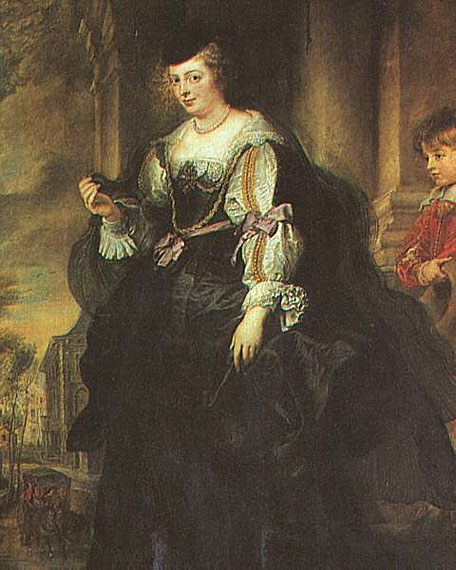
Helena Fourment with her Son Francis: 1635
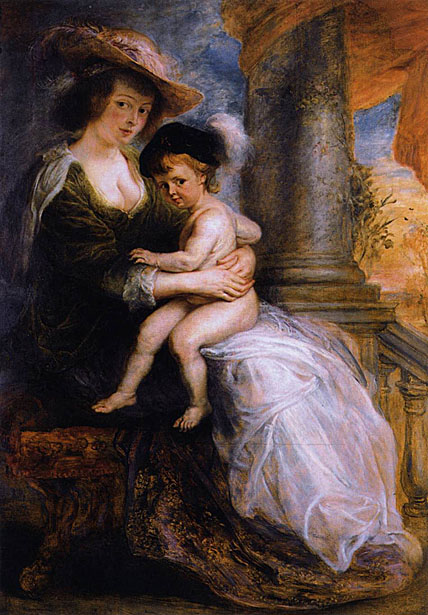
This intensely personal work reveals to us the true Rubens, whose mastery of stroke and palette can convey the sweetness and freshness of youth with incomparable mastery. These brushstrokes, so tenderly applied, reflect an obsession with the beauty of his "Helen".
Rubens his wife Helena Fourment and their son Peter Paul: ca 1639

This magnificent portrait of Rubens, his second wife, Helena Fourment, and one of their five children has usually been dated on stylistic grounds to the late 1630s. The child's blue sash, heavy shoes, and plain collar resemble adult male attire and suggest that he is either Frans Rubens, born in 1633, or, more likely, Peter Paul, born March 1, 1637.
Rubens married Helena Fourment on December 6, 1630, when he was fifty-three and she was sixteen. Helena became the model and the inspiration for many paintings by Rubens dating from the 1630s, particularly those dealing with themes of ideal beauty or love. The present composition was considerably revised during execution to shift the emphasis from Rubens, as the dominant half of a courtly couple, to Helena, as ideal wife and mother. The parrot, long a symbol of the Virgin Mary, suggests ideal motherhood, while the fountain, caryatid, and garden setting imply fertility and recall Rubens's own garden in Antwerp, where he frequently escorted Helena.
The painting hung at Blenheim, the Churchill family seat, between its presentation to the first Duke of Marlborough by the city of Brussels in 1704 and its purchase by Baron Alphonse de Rothschild in 1884.
Helene Fourment with Two of her Children: Claire Jeanne and Francois
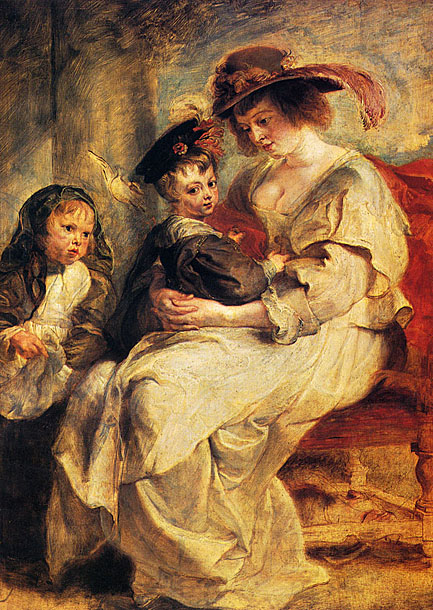
While commercial production continued apace in Rubens' studio, he reserved his strength for the intimate works that lay closest to his heart and in particular to those that his young wife continuously inspired. Here his painting becomes deeply moving. There are no greater works in his catalogue than the portrait Helena Fourment with her Children, in which she is seen rosy-complexioned beneath a wide-brimmed feather hat that sets off her round cheeks.
Helena Fourment: ca 1630
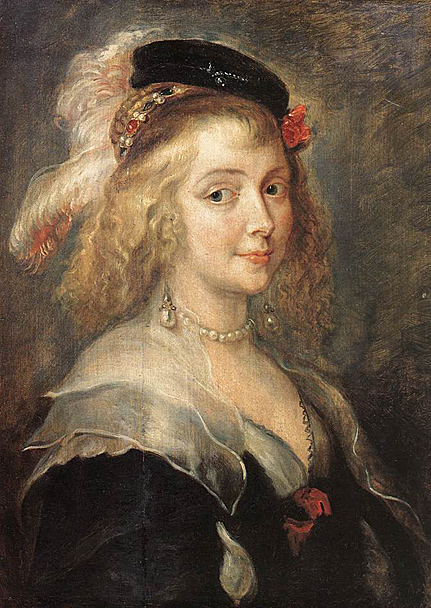
The Straw Hat: ca 1625
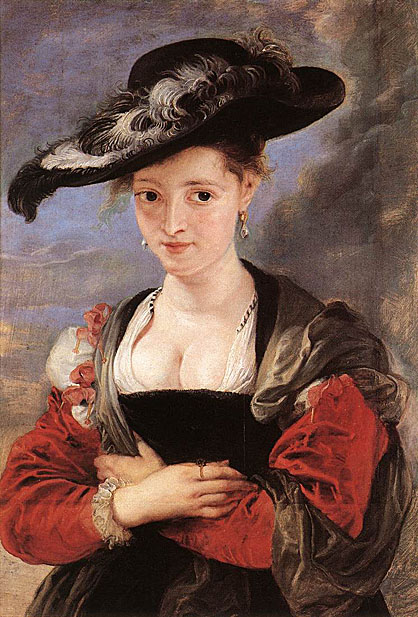
The sitter of the picture is probably Susanna Lundent, the sister of Helene Fourment, the second wife of Rubens. The title of the painting is "Straw hat" (Le chapeau de paille) from the 17th century, although the hat is not a straw hat. "Paille" is an old name for the baldachin, and the painter probably wanted to emphasize by this title the character of the hat.
Jan Gaspar Gevartius: ca 1628
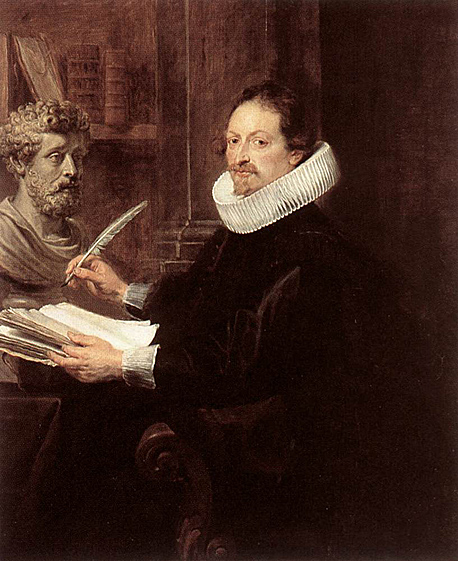
This is a portrait of Rubens' friend Jan Gaspar Gevaerts (1593-1666). He was a reputable philologist, Neo-Latin poet and historiographer. Characteristically for his intellectual circles he had his name Latinized to Gevartius.
After a stay in Holland and Paris Gevartius became the Registrar of the city of Antwerp. In this function he was in charge of official ceremonies in the city and in 1635 helped Rubens with the "Pompa Introitus Ferdinandi", one of Rubens most impressive projects.
Rubens here intends to represent his friend's humanist attitude: he is sitting at his desk, with a bust of the Roman Emperor and philosopher Marcus Aurelius, on whom he wrote an unpublished commentary.
The painting is dated around 1628. The composition of the work is not baroque, but fits more easily into the 16th-century tradition of homely portraits of humanists.
Maria Serra Pallavicino: 1606
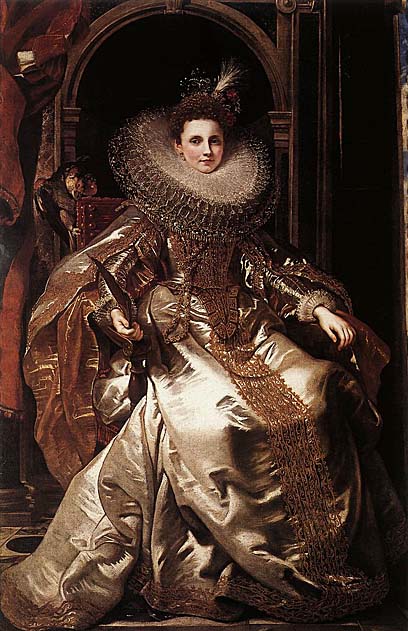
This large portrait of a noble woman was executed by Rubens during his stay in Genoa.
The fine full-length portraits of ladies from the highest social circles in Genoa possess a pronounced Venetian stamp. This port and trading city was governed by a city oligarchy, consisting of members of aristocratic families such as the Pallavicinis, Durazzos, Grimaldis, Imperiales and Spinolas, who controlled the banking, economy and politics of the republic. These members of Genoese urban aristocracy were painted by Rubens around 1606-07. The portraits have none of the courtly formality that was so characteristic of the Low Countries tradition of portraiture in the manner of Mor and Frans Pourbus II.
In portraits such as that of Maria Serra Pallavicino, the observer is struck by the high degree of realism. Rubens achieved this by a variety of means. He used interrupted backgrounds, where strategically placed porticos and pillars carry the eye of the observer into the distance; the brilliant suggestion of tangibility in the depiction of the costly satins worn by the ladies, the impression they give of arrested movement, and the presence of children dwarves and pets that enliven the decorum of the subject. It is evident that the similar portraiture of Titian, and even more, of Veronese, were the models here. The treatment of color and light, particularly in the glowing dark red of the ceremonial curtain and the reflections illuminating the dark, mainly brownish, architecture like flashes of lightning, is influenced by Tintoretto's technique.
Philip Rubens: 1610-11
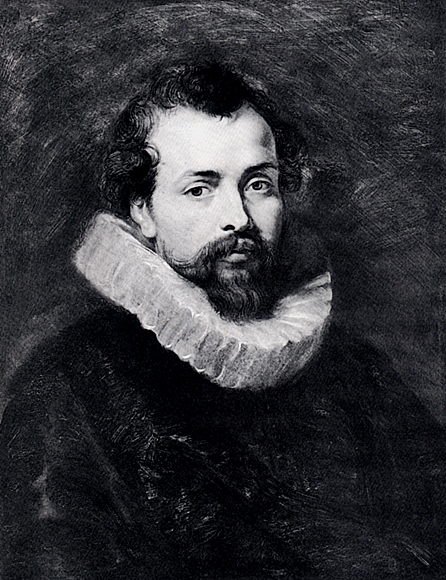
Portrait of a Man Probably Peter Van Hecke
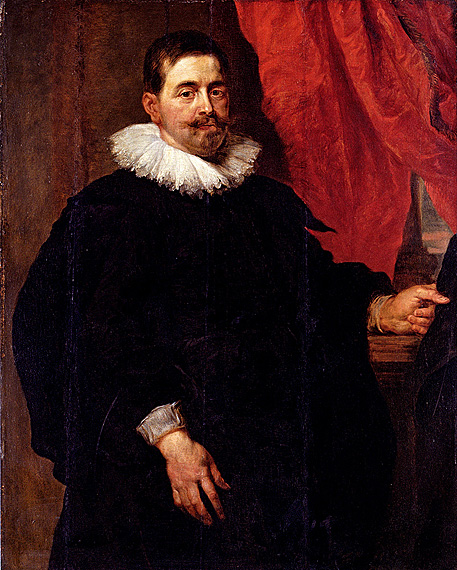
Portrait of a Woman Probably His Wife

Portrait of a Man: 1597
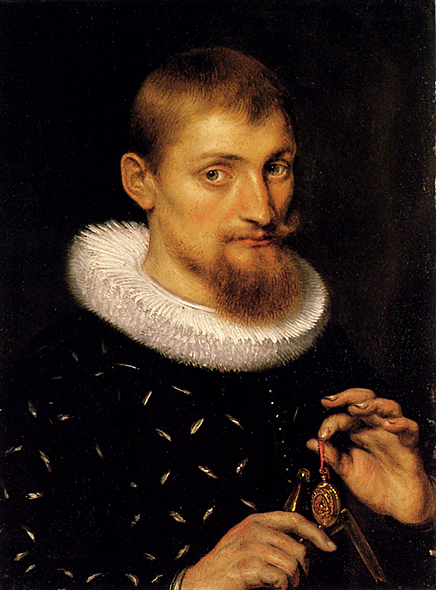
This is Rubens's earliest known painting. In its somewhat formal pose and pale flesh-tints of the face this painting is entirely in keeping with the earlier Netherland's style of portraiture. None the less, the play of the hands in Rubens's portrait reveals a lively force that seems to announce a new type of portrait painting which would, however, only later come into is own.
Portrait of a Woman
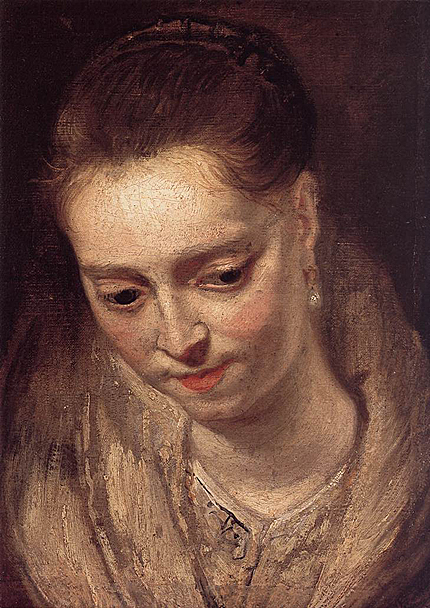
Gaspard Schoppius: ca 1604-05
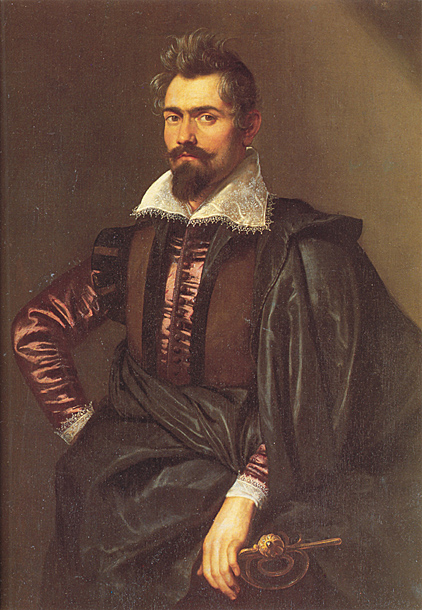
Marie de Medici as Bellona: 1622-25
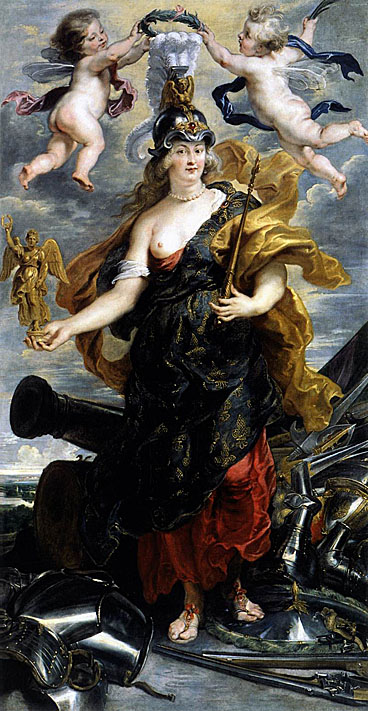
Certainly, it was not the rather heavy features of the Medici family, particularly evident in the queen, that had attracted Henri IV, but the scale of her dowry. Rubens nevertheless contrived to render her portrait agreeable. He disguised her now as an attractive Bellona, now as a proud horsewoman in The Capture of Juliers. The royal couple becomes Olympian deities in The Meeting of Marie de Medicis and Henri IV at Lyon, while The Fate Spinning Marie's Destiny and The Triumph of Truth became pretexts for a proliferation of female convexity.
Anne of Austria: 1621-25

King Louis XIII found little to admire in the allegorical exuberance of Rubens' Baroque invention in the series painted for her mother, Marie de Medicis. He nonetheless commissioned his own portrait and that of his wife, Anne of Austria, along with a series of sketches and large cartoons of the story of Constantine. Rubens the diplomat-artist responded with rigorously classical portraits, from which every trace of Baroque invention was meticulously excluded. The mother of the future Sun King, Louis XIV, was portrayed in all her feminine majesty. This portrait was executed by the workshop of Rubens.
Boy with a Bird: ca 1616
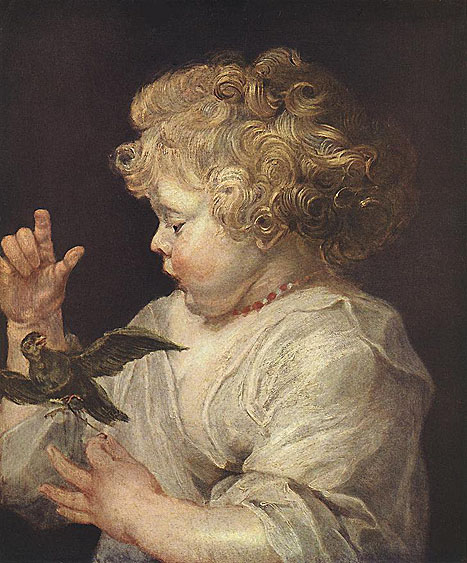
A child of about two is shown playing with a captive bird. On the original panel, which was smaller, only the child's head was visible. Rubens made use of this study for an angel in the Madonna with a Floral Wreath in the Alte Pinakothek in Munich. Later the artist enlarged the picture on the left side, adding the hands with the bird.
Although formerly taken to be a girl, the child portrayed is in all probability Rubens' first son Albert, who was born in 1614. The motif of the child playing with a bird goes back to antiquity. It also crops up frequently in Christian art. The bird symbolizes the soul or life, which passes all too quickly. In many pictures of the Virgin and Child, Jesus is portrayed holding a bird in his hand as an allusion to his death and resurrection. Whether Rubens had a similar allegory in mind when he introduced the bird into his child-portrait, or whether some particular incident in his own life motivated him, is not known.
Christoffel Plantin
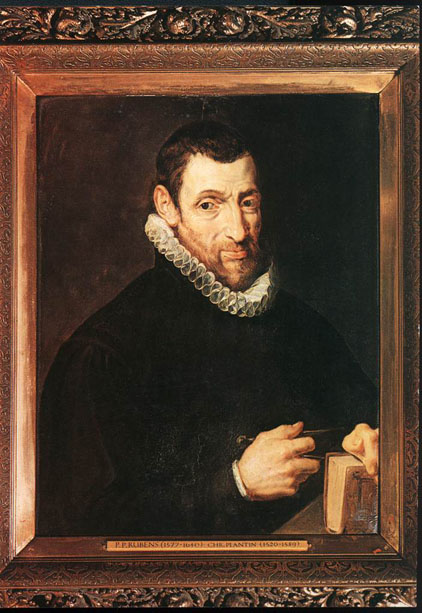
Christoffel (Christophe) Plantin (1520-1589), French printer, was the founder of an important printing house and publisher of the Antwerp Polyglot Bible.
Plantin learned bookbinding and bookselling at Caen, Normandy, and settled in 1549 as a bookbinder in Antwerp. A bad arm wound seems to have led him (about 1555) to turn to typography. His many publications were distinguished by their excellent typography, and he was original in using copper, instead of wood, engravings for book illustrations. His greatest venture, the Biblia regia, which would fix the original text of Old and New Testaments, was supported by Philip II of Spain in spite of clerical opposition and appeared in eight volumes during 1569-72.
When Antwerp was plundered by the Spaniards in 1576 and Plantin had to pay a ransom, he established a branch office in Paris and then, in 1583, settled in Leiden as the typographer of the new university of the states of Holland, leaving his much-reduced business in Antwerp in the hands of his sons-in-law, John Moerentorf (Moretus) and Francis van Ravelinghen (Raphelengius). But in 1585 Plantin returned to Antwerp and Raphelengius took over the business in Leiden. After Plantin's death, the Antwerp business was carried on by Moretus, but it declined during the second half of the 17th century. All was religiously preserved, however, and in 1876 the city of Antwerp acquired the buildings and their contents and created the Plantin-Moretus Museum.
A Franciscan Friar
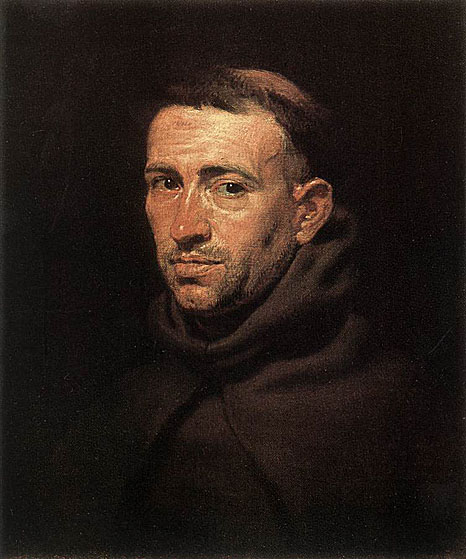
Marie de Medici Queen of France: ca 1622
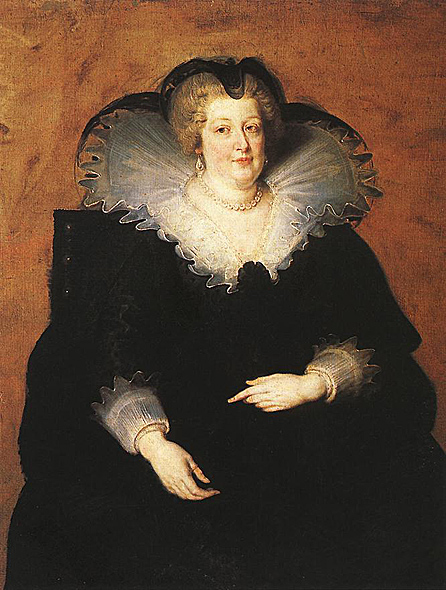
Marie de Médicis (1573-1642), queen consort of King Henry IV of France (reigned 1589-1610) and, from 1610 to 1614, regent for her son, King Louis XIII (reigned 1610-43).
Marie was the daughter of Francesco de' Medici, grand duke of Tuscany, and Joanna of Austria. Shortly after Henry IV divorced his wife, Margaret, he married Marie (October 1600) in order to obtain a large dowry that would help him pay his debts. In 1601 Marie gave birth to the dauphin Louis (the future Louis XIII), and during the following eight years she bore the king five more children. Nevertheless, their relationship was strained. Marie resented Henry's endless infidelities, and the king despised her unscrupulous Florentine favorites, Concino Concini and his wife Leonora. Upon the assassination of Henry IV (May 14, 1610) the Parlement of Paris proclaimed Marie regent for young King Louis XIII.
Guided by Concino (now the Marquis d'Ancre), Marie reversed Henry's anti-Spanish policy. She squandered the state's revenues and made humiliating concessions to the rebellious nobles. Although Louis XIII came of age to rule in September 1614, Marie and Ancre ignored him and continued to govern in his name. On April 24, 1617, Louis's favorite, Charles d'Albert de Luynes, had Ancre assassinated. Marie was then exiled to Blois, but in February 1619 she escaped and raised a revolt. Her principal adviser, the future Cardinal de Richelieu, negotiated the peace by which she was allowed to set up her court at Angers. Richelieu again won favorable terms for her after the defeat of her second rebellion (August 1620). Readmitted to the king's council in 1622, Marie obtained a cardinal's hat for Richelieu, and in August 1624 she persuaded Louis to make him chief minister. Richelieu, however, did not intend to be dominated by Marie. He enraged her by rejecting the Franco-Spanish alliance and allying France with Protestant powers. By 1628 Marie was the cardinal's worst enemy. In the crisis known as the Day of the Dupes (Nov. 10, 1630), she demanded that Louis dismiss the minister. Louis stood by Richelieu and in February 1631 banished Marie to Compiegne. She fled to Brussels in the Spanish Netherlands in July 1631 and never returned to France. Eleven years later she died destitute.
Marie de Médicis built the Luxembourg Palace in Paris, and in 1622-24 Peter Paul Rubens decorated its galleries with 21 paintings, portraying the events of her life, that rank among his finest work.
Rubens Self-Portrait: 1628-30
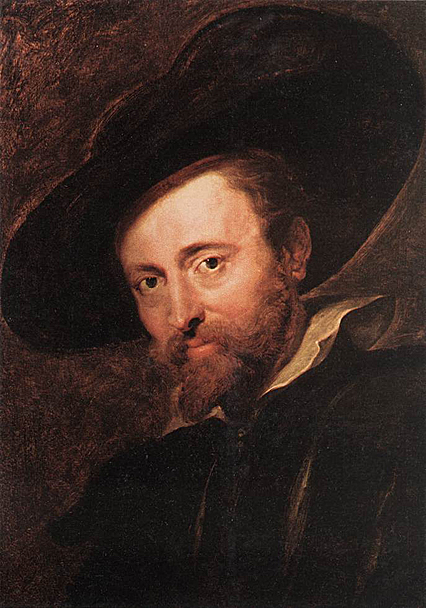
Self-Portrait: 1639

This is the last one of Rubens's four self-portrait which was executed shortly before his death. The portrait shows him dressed in black and wearing a feather hat, like the musketeer he had always been. Beneath the sunken lid glints an eye laden with the experience of life. He seems to have lived a blessed existence and in doing so to have reached a true serenity of heart. Gout alone had his measure. Despite the attentions of the best Brussels doctors, he died of a fierce attack on 30 May 1640.
Sir Peter Paul Saint Felix of Cantalice
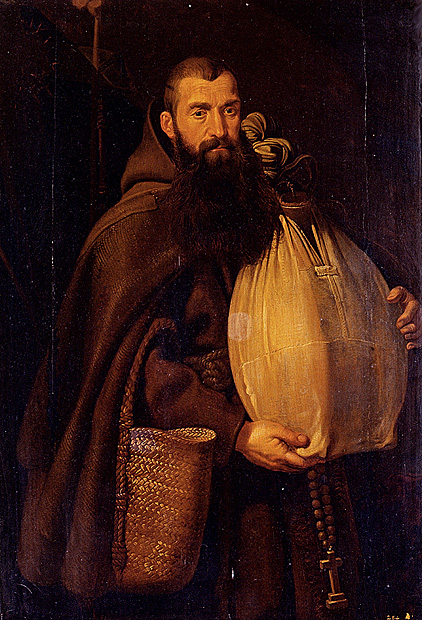
The Duke of Buckingham: ca 1625

George Villiers, the 1st Duke of Buckingham (1592-1628), was a royal favorite and statesman who virtually ruled England during the last years of King James I and the first years of the reign of Charles I. Buckingham was extremely unpopular, and the failure of his aggressive, erratic foreign policy increased the tensions that eventually exploded in the Civil War between the Royalists and the Parliamentarians.
The Four Continents: 1620

The four continents, personified as female figures, are found in the art of the Counter-Reformation where their most common function, especially in Jesuit churches, is to serve as a reminder of the world-wide spread of Catholic Christendom.
The Four Philosophers: ca 1602
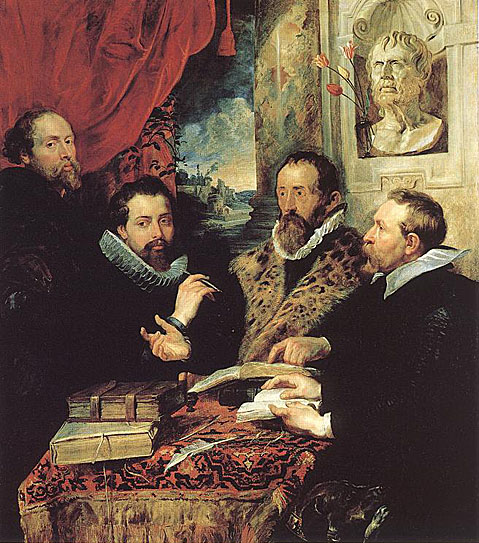
Portraits, including those in seventeenth-century Antwerp, were not just a mirror of the dominant ethical ideas of the time. They could also, in an equally subtle way, illustrate someone's intellectual role and significance. The group portrait known as the Four Philosophers, which shows Rubens with three humanists, his brother Philip, Johannes Woverius and the teacher of both of them, Justus Lipsius is a typical example. Emblematic details make it clear that Rubens has shown himself with the three humanists in order to express the underlying moral principles of Stoic philosophy, which were also those of the influential Lipsius and the other sitters. They are shown gathered together in homage to Seneca, one of the classical exponents of Stoicism, here represented by his bust. Finally, the ruins of the Palatine in the background show that the picture also pays homage to classical culture in the widest sense, symbolizing the resurrection in their own time of the departed glory of Hellenistic-Roman antiquity.
The Mantuan Circle of Friends: 1602
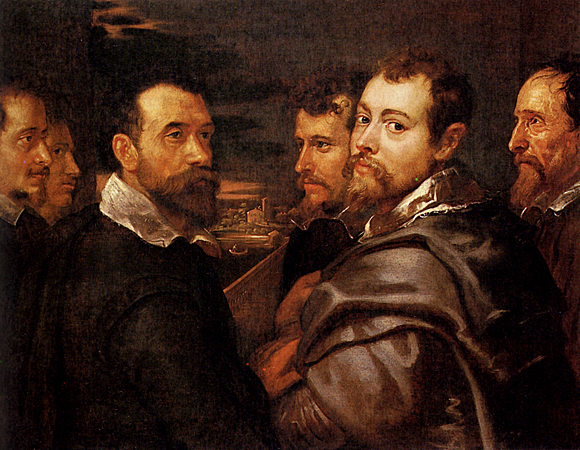
The Triumph of Victory: ca 1614
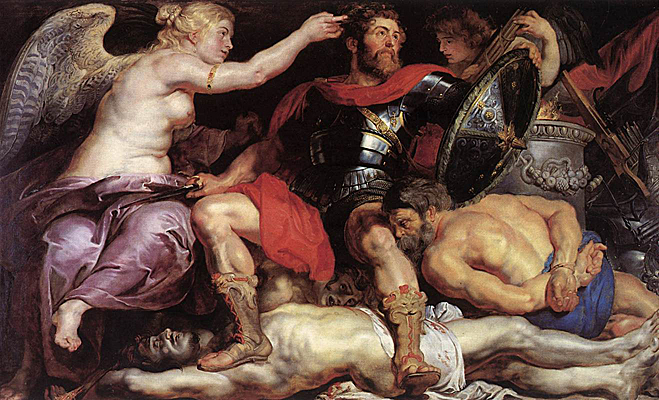
Rubens painted this moral and political allegory for the Guild of St George, the Antwerp archers' company, in the period of the Eighty Years' War (1568-1648).
Rubens, who painted numerous allegories of this sort, shows the victor as a hero in antique armor, bloody sword in hand, seated as if enthroned upon the vanquished figures of Rebellion, symbolized by the torch, and Discord, from whose curls a snake emerges. The goddess of victory crowns him with a wreath of oak leaves. On the right, above the bound figure of Barbarism, a tutelary spirit proffers a a bundle of crossbow bolts, a symbol of concord. On the altar burns the holy flame of the Fatherland, which must be defended. Behind it, red, white and red of the Habsburg flag gives the general, timeless allegory a more specific connection to the time of its composition.
The Village Fete: 1635-38
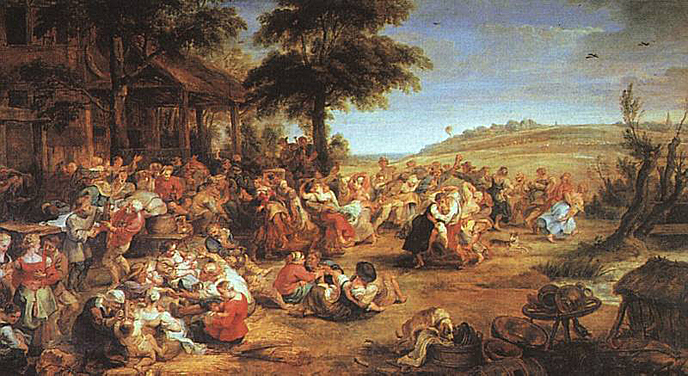
With the famous Flemish Kermis, Rubens reinforced his reputation as a Protean artist by showing himself the sole heir of the great Bruegel - whose works he collected. At Het Steen, he was immensely happy, wandered among the trees, discovered his landscape gifts, and anticipated the discoveries of Impressionism. Whereas the landscape artists of his time tended to consider the little figures with which their paintings were studded as mere accessories, to be entrusted for the most part to the diligence of their assistants, Rubens restored man's prominence, and showed him sharing in the seasonal life of nature. In the Brueghelian Kermis, Rubens returned to a traditional Flemish scene, with all its familiar episodes: here the joyful tread of the dancing, there the coarse antics of the drunk. But the sheer sweep of the painting frees the subject from its usual tenor of vulgarity and triviality. There is no Naturalism in this painting, rather a kind of ballet whose different scenes unfold beneath the poetry of Rubens' sky.
The Consequences of War: 1637-38
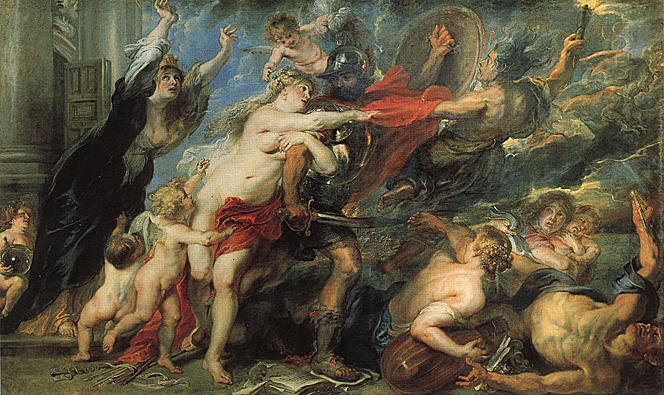
Rubens painted the Consequences of War (or Horrors of War) for Ferdinand de' Medici, Grand Duke of Tuscany. This picture in a certain sense is the negative counterpart of the allegory on peace painted for Charles I, king of England. The message of this painting is exceptionally pessimistic: even love cannot restrain the blind martial brutality of the Thirty Years War from plunging Europe into mourning and destroying her prosperity. Yet this did not prevent Rubens portraying this tragic subject in the most Titianesque spirit, as a perfect demonstration of chromatic harmony.
The Consequences of War: (Detail) 1637-38
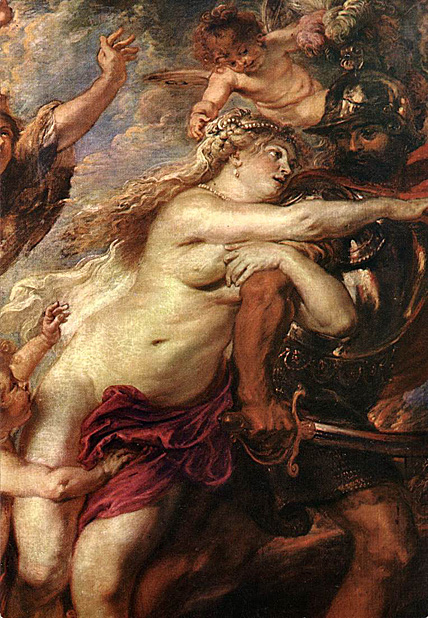
The Death of Seneca: ca 1615
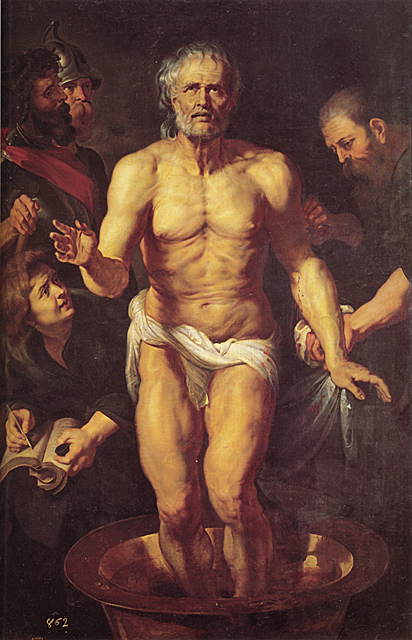
Though Peter Paul Rubens was an international diplomat, savvy businessman, devout Catholic, fluent in six languages, an intellectual who counted Europe's finest scholars among his friends, Peter Paul Rubens was always first a painter. Few artists have been capable of transforming such a vast variety of influences into a style utterly new and original. After study with local Antwerp painters, Rubens began finding his style in Italy, copying works from antiquity, Renaissance masters such as Michelangelo and Titian, and contemporaries like Annibale Carracci and Caravaggio. Returning to Antwerp, Rubens became court painter to the Spanish Viceroys, eventually receiving commissions from across Europe and England. Rubens's impact was immediate, international, and long lasting. The works of Thomas Gainsborough and Eugene Delacroix, among others, testify to his posthumous influence.
The Death of Seneca: This beautiful work of the Dutch master Rubens was completed in about 1615. It depicts the scene of Seneca's suicide in his bath at the orders of the emperor Nero in A. D. 65. Seneca was the son of a philosopher who had exerted considerable influence on the young emperor. This work is currently displayed in the Museo del Prado in Madrid.
Old Woman with a Basket of Coal: 1618-20
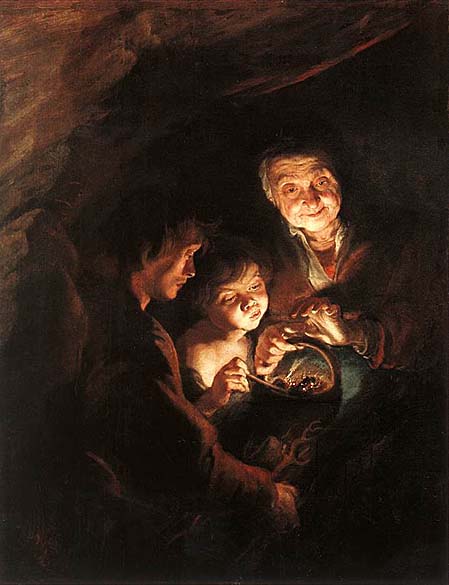
From 1616 onwards Rubens was able to illustrate dramatic scenes with a reliance on Caravaggio's sharp contrasts of light. This painting represents this aspect of Rubens's work well.
Hippopotamus and Crocodile Hunt: 1615-16
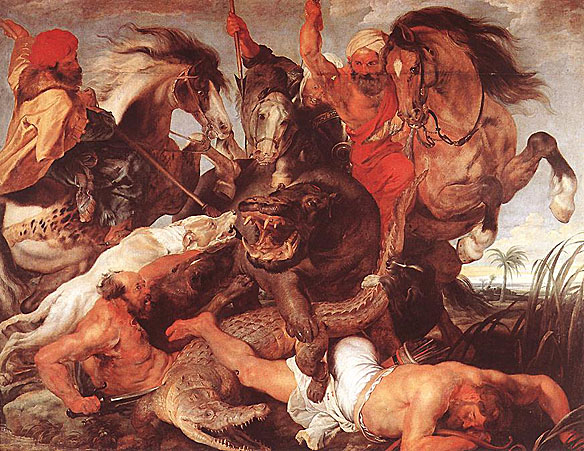
Rubens produced a number of large format hunting scenes in 1614-15, many with mythological backdrop.
The Hermit and the Sleeping Angelica: 1626-28
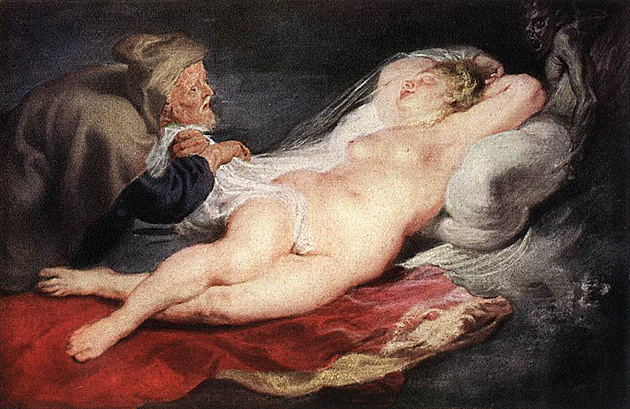
The painting is an illustration of one of the episodes of Ariosto's Orlando furioso.
Orlando Furioso
("Orlando Enraged")
By Ludovico Ariosto
(1474 - 1533)
Online Medieval and Classical Library Release #10a
LANDSCAPES
Landscape with Saint George and the Dragon: ca 1630
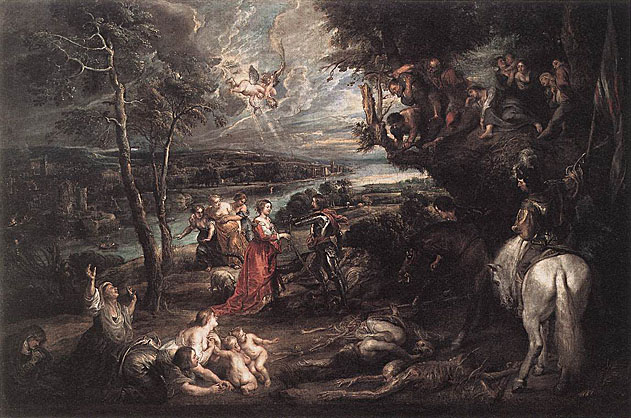
The canvas was extended by the artist, evidently sometime between 1630 and 1635. These additions betoken extensive rethinking of the design. The original concept was to have been contained within the central section and is recorded in a drawing in Stockholm (National Museum). This was preceded by a study in Berlin of motifs occurring in the right half of the composition. These drawings show that the horseman on the right was at first balanced on the left by a woman standing with a child, forms which can still be discerned between the trunks of the two trees and which are even more obvious by X-ray. They were omitted, however, when the composition was enlarged, possibly because they did not constitute a sufficiently strong counterpoint. The other elements of the composition, especially on the right, were merely rearranged on a broader scale. It is conceivable that some iconographical refinements were also made in order to sharpen the allegorical meaning. What remains of this central part is of good quality, particularly the flickering evening light and damp atmosphere so characteristic of the Thames Valley, and can be assigned to Rubens himself. The additions, however, are less adroitly handled and may have been left to studio assistants. The initial composition perhaps relates to the engraving of the same subject by Lucas van Leyden. The works of Pordenone, Titian, Polidoro da Caravaggio, Veronese and the Carracci family all inspired the artist in carrying out this political allegory which, in the context of the reign of Charles I, clearly has religious connotations with particular reference to Saint George.
Landscape with a Rainbow: 1632-35
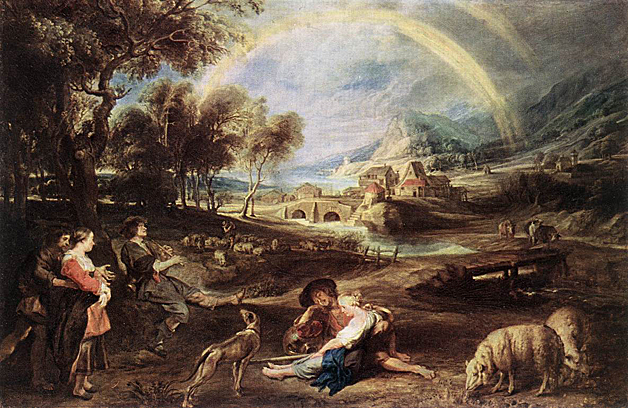
This painting displays the spirit of pastoral literature rather directly, which is emphasized by the Italianate appearance. This is obvious in the figures, the mountain view in the background and the architecture of the buildings.
Rubens in his Garden with Helena Fourment: ca 1631
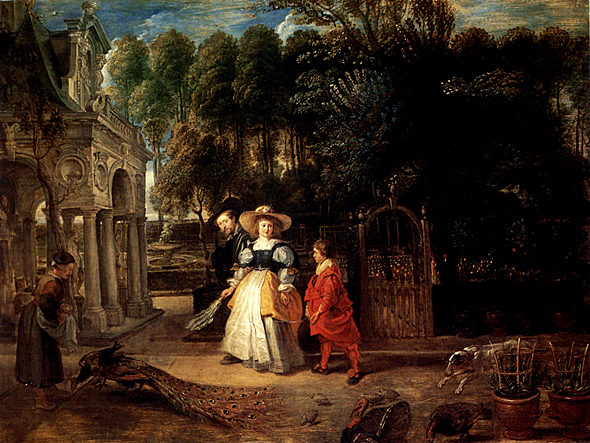
Stormy Landscape: ca 1625

Source: Art Renewal Center
Source: Web Gallery of Art
This page is the work of Senex Magister
Return to Pagina Artis
Return to Bruce and Bobbie's Main Page.




































































_1639.jpg)


_CA_1628.jpg)
































































































